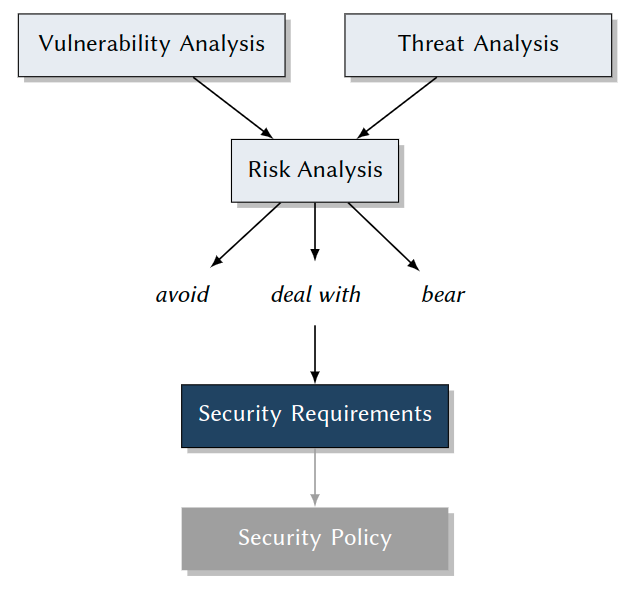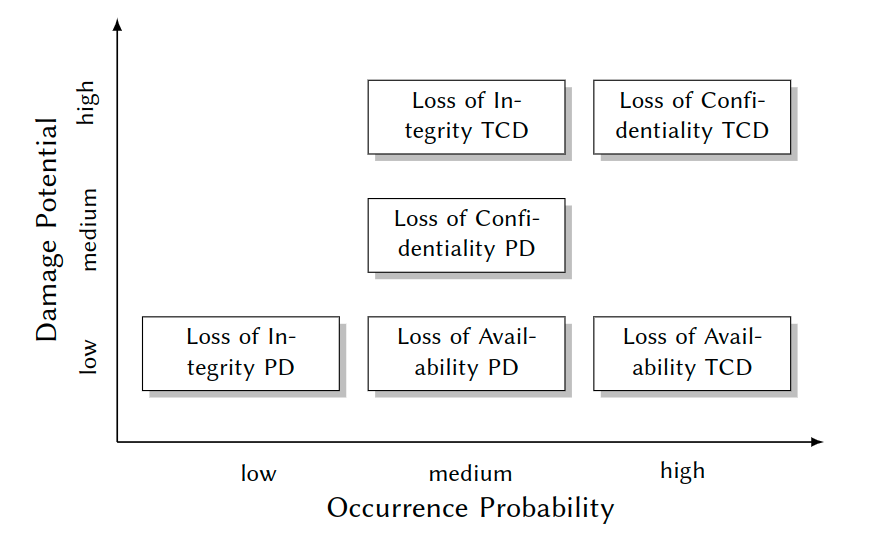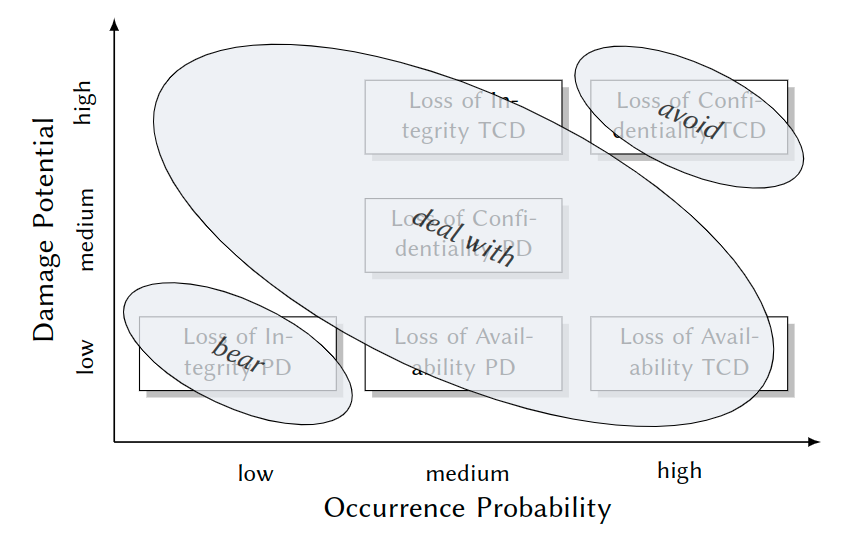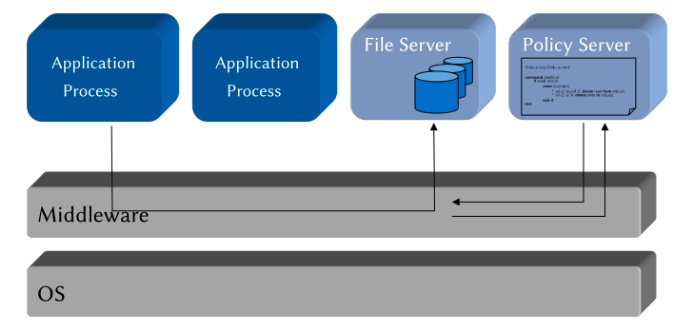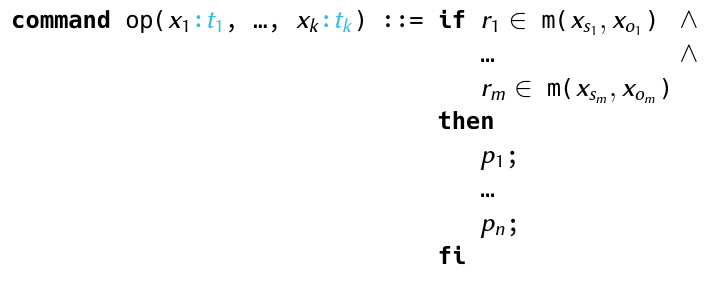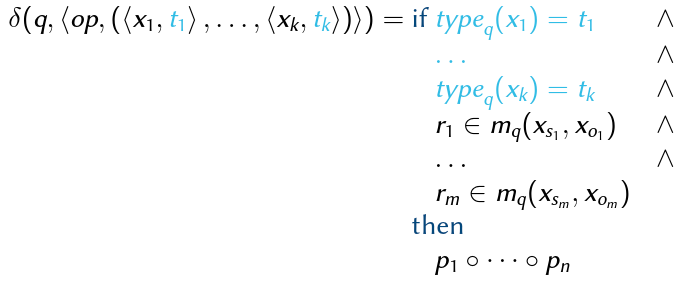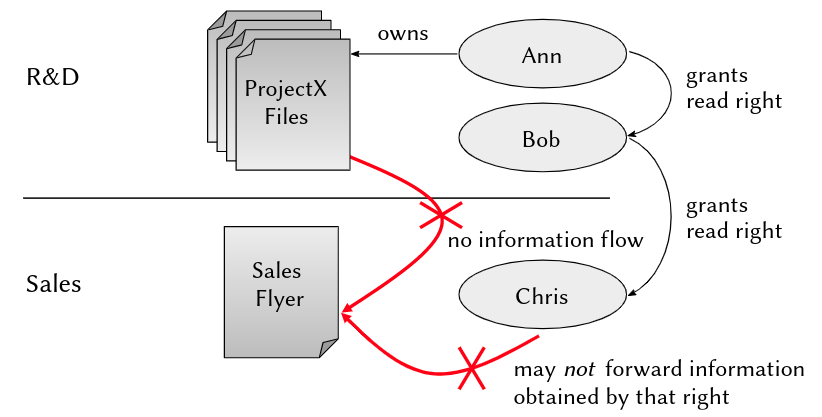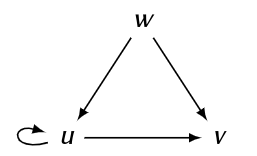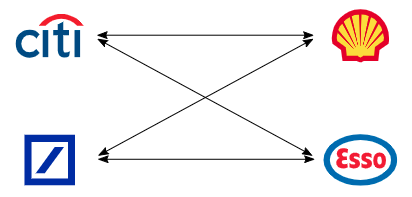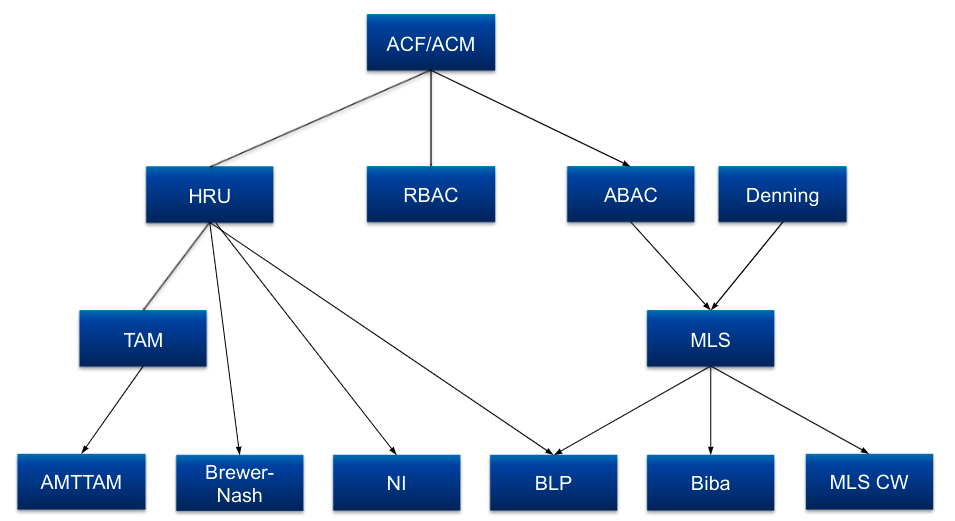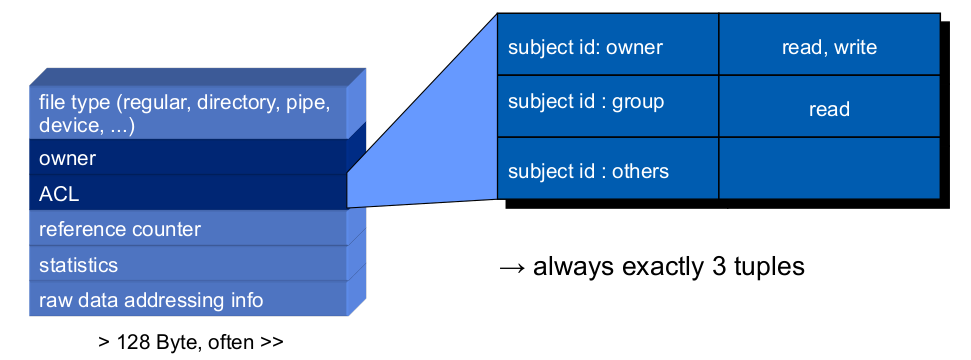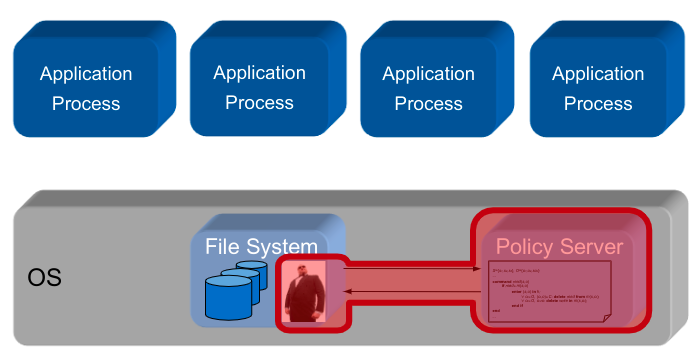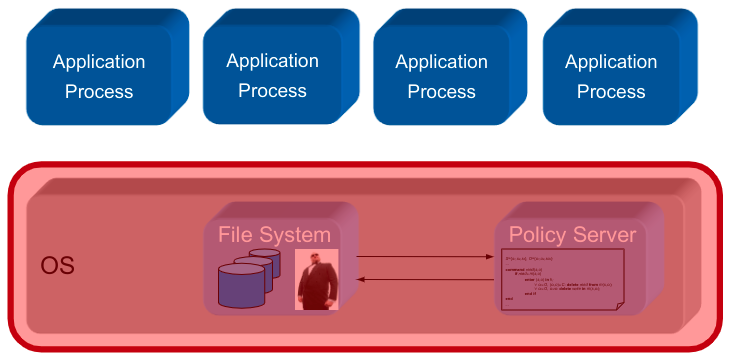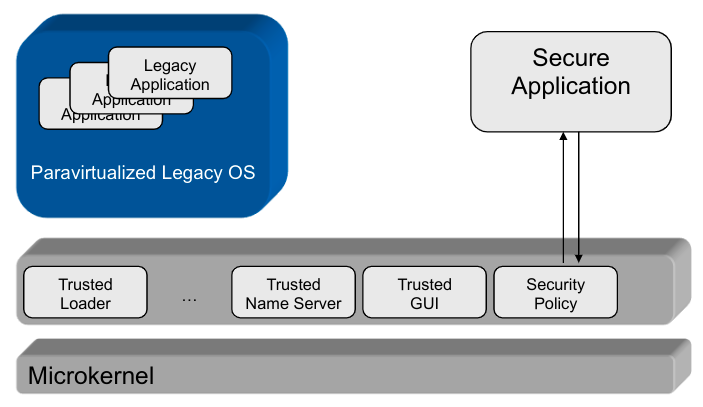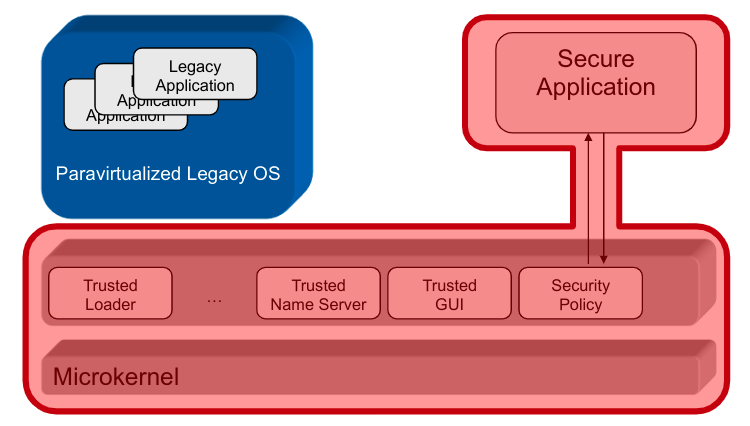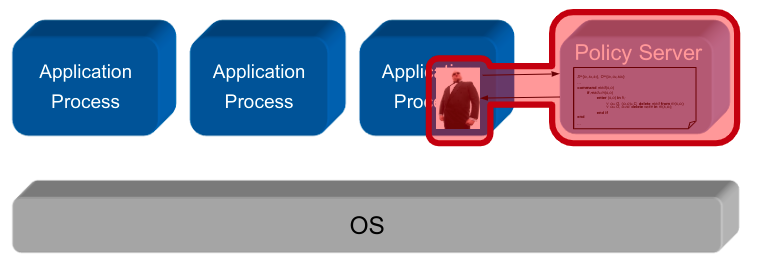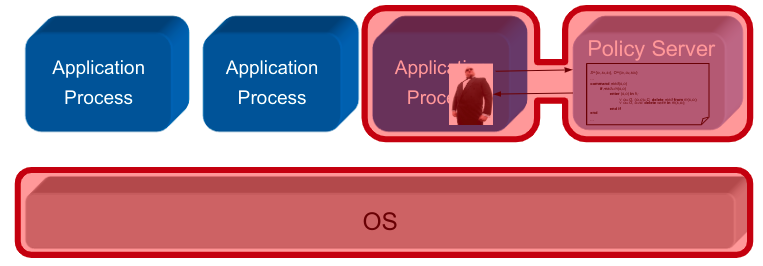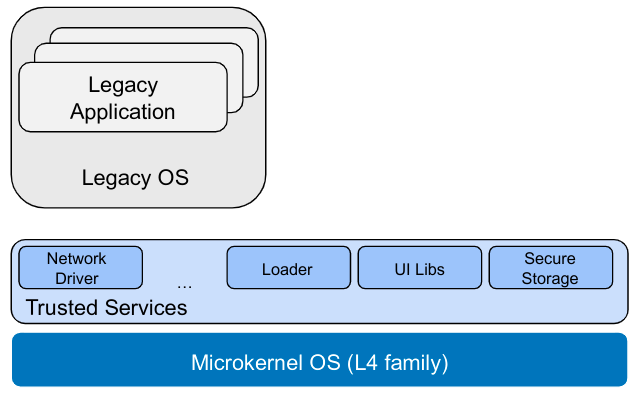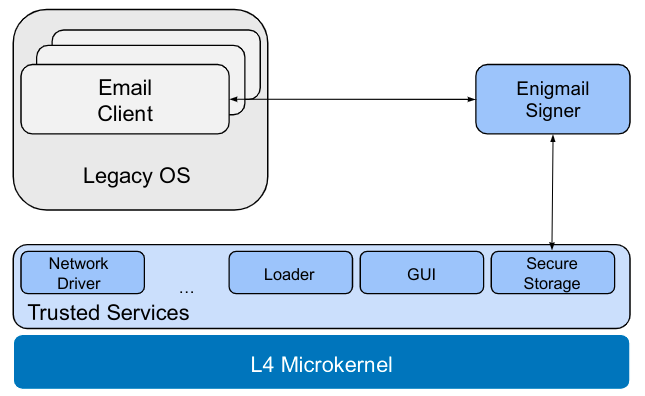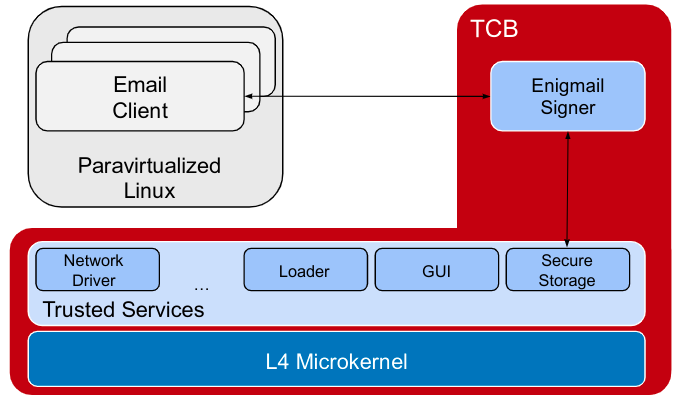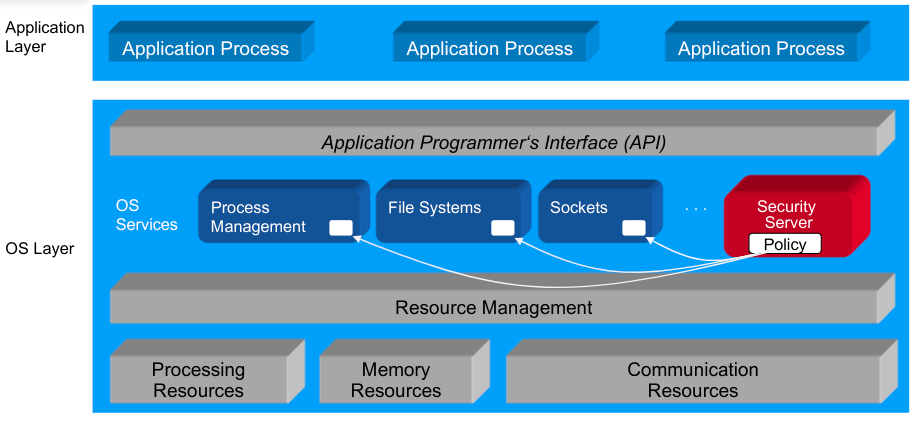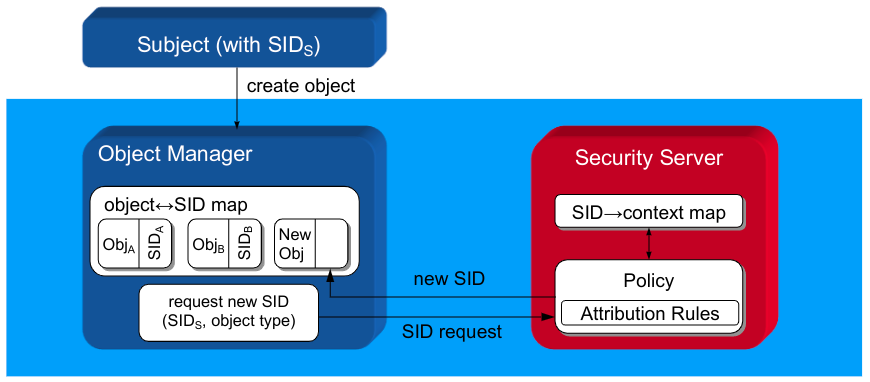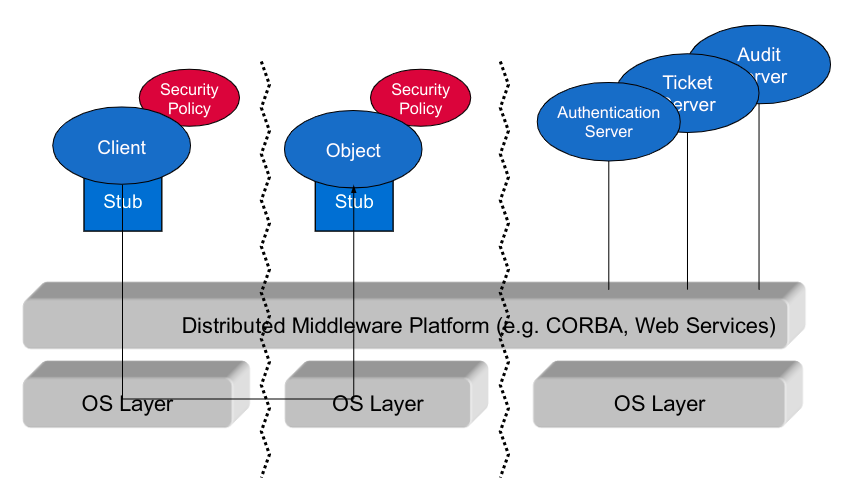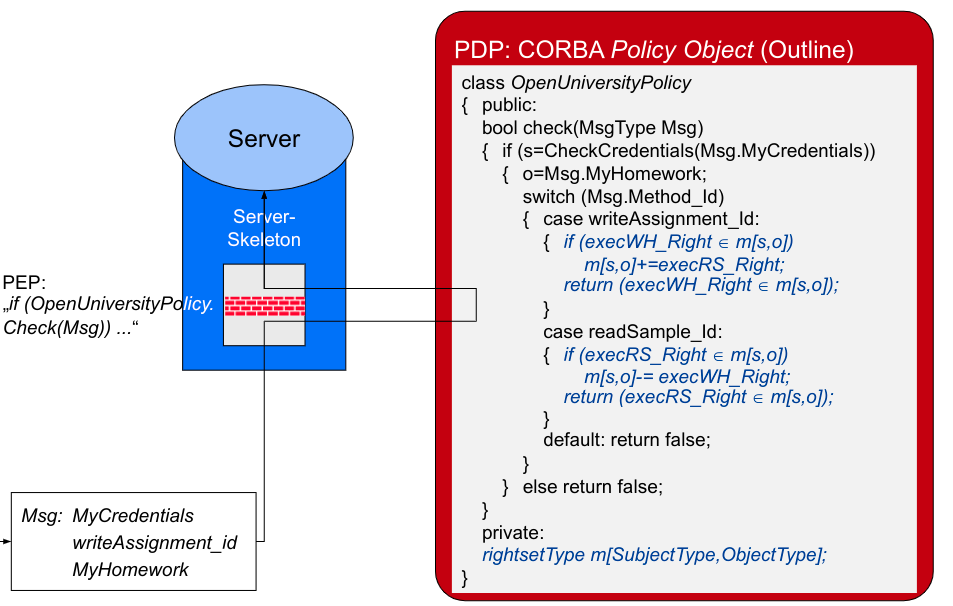209 KiB
- Introduction
- Security Requirements
- Security Policies and Models
- Security Policies
- Security Models
- Access Control Models
- DAC vs. MAC
- Identity-based Access Control Models (IBAC)
- Access Control Matrix
- The Harrison-Ruzzo-Ullman Model (HRU)
- Deterministic Automata
- HRU Security Model
- State Transition Scheme (STS)
- HRU Model Analysis
- HRU Safety
- Proof of Theorem
- (A) Restricted Model Variants
- (B) Heuristic Analysis Methods
- Summary HRU Models
- The Typed-Access-Matrix Model (TAM)
- TAM Safety Decidability
- Acyclic TAM Models
- Roles-based Access Control Models (RBAC)
- Attribute-based Access Control Models
- Information Flow Models
- Non-interference Models
- Hybrid Models
- Access Control Models
- Summary
- Practical Security Engineering
- Security Mechanisms
- Security Architectures
Introduction
Risk Scenarios
Reducing Operational Risks: What responsibilities can we bear?
Critical Properties
- Security + Safety
- Reliability
- Correctness
- Availability
- Real Time
- Scalability
- Openness
Examples:
- Information Systems
- Communication Systems
- Energy Grid Management
- Traffic Management
- Consumer Technology
Responsibility for risks -> guaranteed properties!
Relevance of Security: Security properties if any IT system are mission-critial - independet of its application domain
Security Goals
Our Faculty's Education and Examination Management System
- Maintains:
- Course profiles (examination form/date, credit points)
- Students records (personal data, registration to examinations, grades)
- Services:
- Enrolment/expulsion of students
- Registration to examination
- Registration of examination marks
- Information and attestations desk
- Operational Risks
- Conditio sine qua non: Provability of information properties
- Fake registration to examinations: integrity, non-repudiability ("nicht-abstreitbar")
- Leakage of grades, personal data: confidentiality, integrity
- Forgery of attestations: authenticity, integrity
Industry Control Systems
- e.g. Factorys, energy and water plants (public infrastructure)
- "Chinese Hacking Team Caught Takin over decoy water plant"
- "Internet Attack shuts off the Heat in Finland"
- Operational risks: Integrity & Availability of public community support systems
Self Study Task Read about these two scenarios. Find one or more recent examples for attacks on public infrastructure, including some technical details, in the news. Keep all these scenarios in mind, we will come back to them in the next chapter:
- Hacker breached 63 universities and government agencies
- Ransomeware attacks on public services
- Unsecured Databases
- Worst data leaks and breaches in the last decade
Message
- Goal of IT Security: Reduction of Operational Risks of IT Systems
- Elementary: Protection of
- Confidentiality
- Integrity
- Availability
- Non-repudiability
Specific Security Goals (Terms)
- Confidentiality: the property of information to be available only to anauthorized user group
- Integrity: the property of information to be protected against unauthorized modification
- Availability: the property of information to be available in an reasonable time frame
- Authenticity: the property to be able to identify the author of an information
- Non-repudiability: the combination of integrity and authenticity
| Safety | Security | |
|---|---|---|
| Goal | To protect environment against hazards caused by system failures | To protect IT systems against hazards caused by malicious attacks |
| Technical failures: power failure, ageing, dirt | Industrial espionage, fraud, blackmailing | |
| Human errors: stupidity, lacking education, carelessness | Terrorism, vandalism | |
| Force majeure: fire, lightning, earth quakes | ||
| => making sure things work | in the presence of system failures | in the face of an intelligent and maliciousadversary |
Security Engineering
Security Goals in Practice
- ... are diverse and complex to achieve
- ... require multiple stakeholders to cooperate
- ... involve cross-domain expertise
Security Engineering:
- Is a methodology that tries to tackle this complexity.
- Goal: Engineering IT systems that are secure by design.
- Approach: Stepwise increase of guarantees -> formal methods required!
Steps in Security Engineering:
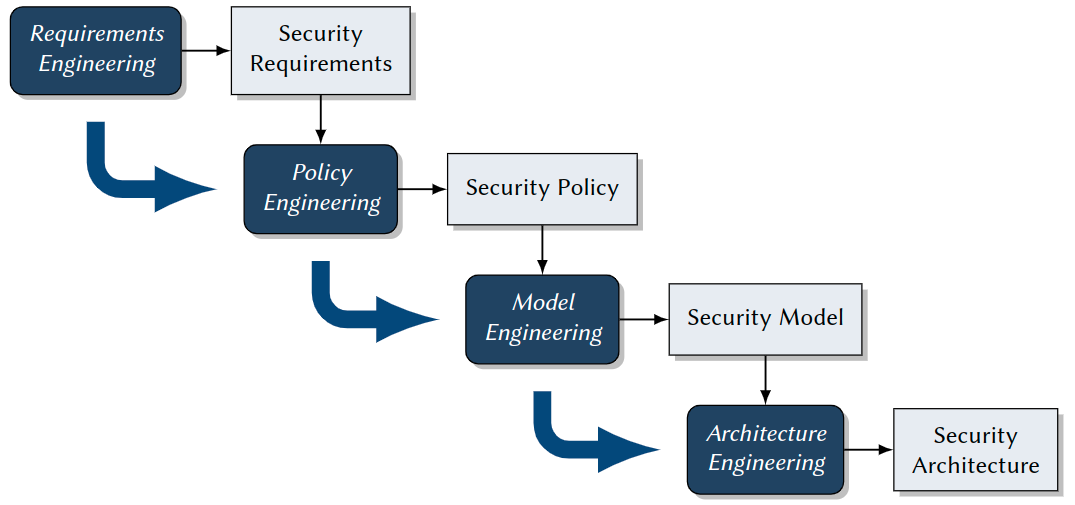
Lecture Roadmap
- Security Requirements: Vulnerabilites, Threats, Risks
- Security Policies and Models: Access Control, Information Flow, Non-Interference
- Practical Security Engineering: Model Engineering, Model, Specification, Model Implementation
- Security Mechanisms: FYI Authorization, Authentication, Cryptography
- Security Architectures: TCBs and Reference Monitors, Nizza,SELinux, Kerberos
Security Requirements
Motivation
Goal of Requirements Engineering:
Methodology for
- identifying
- specifying
the desired security properties of an IT system.
Result:
- Security requirements, which definewhatsecurity properties a system should have.
- These again are the basis of asecurity policy: Defineshowthese properties are achieved
Influencing Factors
- Codes and acts (depending on applicable law)
- EU General Data Protection Regulation (GDPR)
- US Sarbanes-Oxley Act (SarbOx)
- Contracts with customers
- Certification
- For information security management systems (ISO 27001)
- Subject to German Digital Signature Act (Signaturgesetz), toCommon
- Criteria
- Company-specific guidelines and regulations
- Access to critical data
- Permission assignment
- Company-specific infrastructure and technical requirements
- System architecture
- Application systems (such as OSs, Database Information Systems)
General Methodology: How to Come up with Security Requirements
Specialized steps in regular software requirements engineering:
- Identify and classifyvulnerabilities.
- Identify and classifythreats.
- Match both, where relevant, to yieldrisks.
- Analyze and decide which risks should bedealt with. -> Fine-grained Security Requirements
Vulnerability Analysis
Goal: Identification of
- technical
- organizational
- human vulnerabilities of IT systems.
Vulnerability
Feature of hardware and software constituting, an organization running, or a human operating an IT system, which is a necessary precondition for any attack in that system, with the goal to compromise one of its security properties. Set of all vulnerabilities = a system’sattack surface.
Human Vulnerabilities
Examples:
- Laziness
- Passwords on Post-It
- Fast-clicking exercise: Windows UAC pop-up boxes
- Social Engineering
- Pressure from your boss
- A favor for your friend
- Blackmailing: The poisoned daughter, ...
- An important-seeming email
- Lack of knowledge
- Importing and executing malware
- Indirect, hidden information flowin access control systems
Social Engineering
Influencing people into acting against their own interest or the interest of an organisation is often a simpler solution than resorting to malware or hacking. Both law enforcement and the financial industry indicate that social engineering continues to enable attackers who lack the technical skills, motivation to use them or the resources to purchase or hire them. Additionally, targeted social engineering allows those technically gifted to orchestrate blended attacks bypassing both human and hardware or software lines of defence. Europol
Real Cases
Self Study Task
Investigate the following real-world media (all linked from moodle). Find any potential security vulnerabilities there and give advice how to avoid them.
- Watch (no listening required) the interview with staff of the French TV station TV5Monde
- Read the lifehacker article about Windows UAC
- Read the Washington Times article about Facebook Scam
- Read the two eMails I received lately.
Indirect Information Flow in Access Control Systems
A More Detailed Scenario
- AlphaCompany has two departments: Research & Development(R&D) and Sales
- Ann is project manager and Bob is developer working in R&D on ProjectX, Chris is a busybody sales manager writing a marketing flyer about ProjectX
- All R&D developers communicate via an electronic bulletin board, including any preliminary product features not yet ready for release
- Bob is responsible for informing sales about release-ready features, using ashared web document
Security Requirement
No internal information about a project, which is not approved by the project manager, should ever go into the product flyer.
Access Control Configuration
-
3 users:ann,bob,chris
-
2 groups:
- crewx: ann, bob, ...
- sales: ann, bob
-
Settings:
drw- --- --- 1 ann crewx 2020-04-14 15:10 ProjectXFiles -rw- r-- --- 1 ann crewx 2020-04-14 15:10 ProjectXBoard -rw- r-- --- 1 bob sales 2020-04-14 14:22 NotesToSales -rw- --- --- 1 chris sales 2020-04-13 23:58 SalesFlyer.pdf -
Result:
- all users apparently set their permissions perfectly - from their own point of view
- all three together createda severe information flow vulnerability...
-
Ann has read access to the folder ProjectX Files
-
Ann legitimately writes news from these files to the ProjectX Board
-
Bob legitimately updates NotesToSales with these news
-
Human vulnerability: Bob’s laziness, friendship with Chris, blackmailing by Chris, ... (see above) make him write about unapproved new features
-
-> Chris misuses this information in the Sales Flyer...
Forbidden Information Flow
Internal information about ProjectX goes into the product flyer!
Problem Analysis:
- Limited knowledge ofusers
- limited horizon: knowledge about the rest of a system configuration for making a sound decision about permissions
- limited problem awareness: see "lack of knowledge"
- limited skills
- Problem complexity -> effects ofindividualpermission assignments by users (= discretionary) tosystem-widesecurity properties
- Limited configuration options and granularity: archaic and inapt security mechanisms in system and application software
- no isolation of non-trusted software
- no enforcement of global security policies
- -> Effectiveness of discretionary access control (DAC), configured by users?
Organizational Vulnerabilities
Examples:
- Access to rooms (servers!)
- Assignment of permission on organizational level, e. g.
- 4-eyes principle
- need-to-know principle
- definition of roles and hierarchies
- Management of cryptographic keys
- -> e. g. for issuing certificates
- -> Master course on "IT-Sicherheitsmanagement" (in German)
Technical Vulnerabilities
The Problem: Complexity of IT Systems
- ... will in foreseeable timenotbe
- Completely, consistently, unambiguously, correctly specified
- -> contain specification errors
- Correctly implemented
- -> contain programming errors
- Re-designed on a daily basis(many security mechanisms of today’s systems are older than 40 years)
- -> contain conceptual weaknesses and vulnerabilities
Buffer Overflow Attacks
Example for Exploitation of Implementation Errors
in privileged system software:
- Operating Systems (OSs)
- SSH demons
- Web servers
- Database servers
Consequence: Privileged software can be tricked into executing attacker’s code
Approach: Cleverly forged parameters overwrite procedure activation frames in memory
- -> exploitation of missing length checks on input buffers
- -> buffer overflow
What an Attacker Needs to Know
Necessary Knowledge and Skills
- Source code of the target program (e. g. a privileged server), obtained by disassembling
- Better: symbol table, as with an executable not stripped from debugging information
- Even better: most precise knowledge about the compiler used w.r.t. runtime management
- how call conventions affect the stack layout
- degree to which stack layout is deterministic, which eases experimentation
Sketch of the Attack Approach (Observations during program execution)
- Stack grows towards the small addresses
- -> small whenever a procedure is called, all its information is stored in aprocedure frame = subsequent addresses below those of previously stored procedure frames
- in each procedure frame: address of the next instruction to call after the current procedure returns (ReturnIP)
- after storing the ReturnIP, compilers reserve stack space for local variables -> these occupy lower addresses
Preparing the Attack
Attacker carefully prepares an input argument msg:\0 ...\0 /bin/shell#system
void processSomeMsg(char *msg, int msgSize){
char localBuffer[1024];
int i=0;
while (i<msgSize) {
localBuffer[i] = msg[i];
i++;
}
...
}
Result:
- Attacker made victim program overwrite runtime-critical parts of its stack:
- by counting up to the length of msg
- at the same time writing back over previously save runtime information -> ReturnIP
- After finishing processSomeMsg: victim program executes code at address of ReturnIP =address of a forged call to execute arbitrary programs!
- Additional parameter to this call: file system location of a shell
Security Breach
The attacker can remotely communicate, upload, download, and execute anything- with cooperation of the OS, since all of this runs with the original privileges of the victim program!
Self-Study Task
Do an internet research: Find a (more or less) recent example of a successful buffer overflow attack. Describe as precise as possible what happened during the attack and which programming error made it possible! Commonplace search engines for news articles, but also web databases of software vulnerabilities such as https://cve.mitre.org/ may help you.
Summary
Vulnerabilities
- Human
- Laziness
- Social engineering
- Lack of knowledge (e. g. malware execution, DAC shortcoming)
- Organizational
- Key management
- Physical access to rooms, hardware
- Technical
- Weak security paradigms
- Specification and implementation errors
- -> A whole zoo of vulnerabilities!
How can we identify all during systems design and engineering...?
- Vulnerabilities catalogues: ISO 27001, ISO 27002
- Vulnerabilities databases, such as CVE
- Tools (we will see...)
Threat Analysis
Goal: Identification of
- Attack objectives and attackers
- Attack methods and practices (a.k.a. "Tactics, Techniques, and Procedures (TTPs)")
- -> know your enemy
Approach: Compilation of a threat catalog, content:
- identified attack objectives
- identified potential attackers
- identified attack methods & techniques
- damage potential of attacks
Attack Objectives and Attackers
Attack Objectives
- Economical and political power
- Profit
- Wreak havoc (energy infrastructure, water plants, air traffic ...)
- Meet a challenge
Attackers
- Professional organizations (which may be hired by anyone, incl. competitors or governments)
- Active and former employees ("Remember that IT guy we fired last year ...?")
- Terrorists
- Hackers (both good or evil)
Examples
- Economic Espionage
- Objective: economic and political power, profit
- Victims: high tech industry(companies that rely on the secrecy of their know-how to successfully compete)
- Attackers:
- Competitors, (foreign) governments -> professional organizations
- Insiders
- regular, often privileged users of IT systems
- statistically large share(> 40 %)
- often indirect -> social engineering ("Only amateurs target systems; professional target people.")
- statistical profile: age 30-40, executive function (department heads, system administrators, lead programmers, ...)
- weapons: technical and organisational insider knowledge, technical skills
- -> Your own people.
- Personal Profit
- Objective: becoming rich(er)(expensive life style, ambitious projects, medical conditions)
- Attackers:
- Competitors
- Insiders
- profile: age 40-50, management function
- typically: career peak reached, midlife crisis, new boat, new house, new partner, ...
- weapons: organisational insider knowledge, organisational authority, management and leadership skills
- Wreak Havoc
- Objective: damaging or destroying things or lives, blackmailing, meeting a challenge (egomania, narcissism, sportive challange)
- Attackers:
- Terrorists: motivated by faith and philosophy, paid by organisations and governments
- Avengers: see insiders
- Psychos: all ages, all types, personality disorder (egomania, narcissism, paranoia, ...)
- -> No regular access to IT systems, no insider knowledge, butskills and tools.
Attack Methods
Exploitation of Vulnerabilities
- Human: Social engineering, laziness, lack of knowledge
- Organizational: Rights management, key management, room access
- Technical: Weak protection paradigms, specification and implementation errors
Examples
Scenario 1: Insider Attack
- Social Engineering, plus
- Exploitation of conceptual vulnerabilities (DAC),plus
- Professionally tailored malware
Scenario 2: Malware(a family heirloom ...)
- Trojan horses: Executable code with hidden functionality.
- Viruses: Code for self-modification and self-duplication, often coupled with damaging the host.
- Logical bombs: Code that is activated by some event recognizable from the host (e. g. time, date, temperature, pressure, geographic location, ...).
- Backdoors: Code that is activated through undocumented interfaces (mostly remote).
- Ransomware: Code for encrypting possibly all user data found on the host, used for blackmailing the victims (to pay for decryption).
- Worms and worm segments: Autonomous, self-duplicating programs. Originally designed for good: to make use of free computing power in local networks.
Scenario 3: Outsider Attack
- Attack Method: Buffer Overflow
- Exploitation of implementation errors
Scenario 4: High-end Malware:Root Kits
- Goal: Invisible, total, sustainable takeover of a complete IT system
- Method: Comprehensive tool kit for fully automated attacks
- automatic analysis of technical vulnerabilities
- automated attack execution
- automated installation of backdoors
- automated installation and activation of stealth mechanisms
- Target: Attacks on all levels of the software stack:
- firmware
- bootloader
- operating system (e. g. drivers, file system, network interface)
- system applications (e. g. file and process managers)
- user applications (e. g. web servers, email, office)
- tailored to specific software and software versions found there!
Self-Study Task
Read about the following malware examples, both historical and up to date. Identify each as a virus, logical bomb, backdoor, ransomware, or worm; think about which necessary vulnerabilit(y|ies) make all of these threats so dangerous.
- One of the most sophisticated pieces of malware ever discovered:Stuxnet
- One of the first large-scale malware threats in history:Michelangelo
- Two cooperating pieces of malware that put at risk numerous public institutional IT systems:Emotet and Ryuk.
Root Kits
Step 1: Vulnerability Analysis
- Tools look for vulnerabilities in
- Active privileged services and demons (from inside a network:nmap, from outside: by port scans) -> Discovers:web server, remote access server (sshd), file server (ftpd), time server (ntpd), print server (cupsd),bluetoothd,smbd, ...
- Configuration files -> Discovers: weak passwords, open ports
- Operating systems -> Discovers: kernel and system tool versions with known implementation errors
- Using built-in knowledge base: an automatable vulnerability database
- Result: System-specific collection of vulnerabilities -> choice of attack method andtools to execute
Step 2: Attack Execution
- Fabrication oftailored softwareto exploit vulnerabilities in
- Server processes or system tool processes (demons)
- OS kernel itself to execute code of attacker withroot privileges
- This code
- First installs smoke-bombs for obscuring attack
- Then replaces original system software by pre-fabricated modules
- servers and demons
- utilities and libraries
- OS modules
- containing
- backdoors (-> step 3)
- smoke bombs for future attacks (-> step 4)
- Results:
- Backdoors allow forhigh-privilege access within fractions of seconds
- System modified with attacker’s servers, demons, utilities, OS modules
- Obfuscation of modifications and future access
Step 3: Attack Sustainability
- Backdoors for any further control & command in
- Servers (e. g.sshdemon)
- Utilities (e. g.login)
- Libraries (e. g.PAM, pluggable authentication modules)
- OS (system calls used by programs likesudo)
- Modificationsof utilities and OS to prevent
- Killing root kit processes and connections (kill,signal)
- Removal of root kit files (rm,unlink)
- Results: Unnoticed access for attacker
- Anytime
- Highly privileged
- Extremely fast
- Virtually unpreventable
Step 4: Stealth Mechanisms (Smoke Bombs)
- Clean logfiles (entries for root kit processes, network connections), e.g. syslog,kern.log,user.log,daemon.log,auth.log, ...
- Modify system admin utilities
- Process management(hide running root kit processes), e.g. ps,top,ksysguard,taskman
- File system (hide root kit files), e.g. ls,explorer,finder
- Network (hide active root kit connections), e.g. netstat,ifconfig,ipconfig,iwconfig
- Substitute OS kernel modules and drivers (hide root kit processes, files, network connections), e.g. /proc/...,stat,fstat,pstat
- Result:Processes, files and communication of root kit become invisible
Risk and Damage Potential:
- Likeliness of success: extremely highin today’s commodity OSs
- High number of vulnerabilities
- Speed
- Refined methodology
- Fully automated
- Fighting the dark arts:extremely difficult
- Number and cause of vulnerabilities
- number of "security updates" last month?
- specification/implementation errors, weak security mechanisms
- Speed
- Smoke bombs
- Prospects for recovering the system after successful attack:near zero
Countermeasures - Options:
- Reactive: Well ...(even your OS might have become your enemy)
- Preventive:
- Counter with same tools for vulnerability analysis (we do this for years now -> 50 Billions € damage taken...)
- Write correct software (we try this for years now -> 50 Billions € damage taken...)
Security Engineering
- New paradigms:policy-controlled systems -> powerful software platforms
- New provable guarantees: formal security models -> reducing specification errors and faultsby design
- New security architectures -> limiting bad effectsof implementation errors and faults
Damage Potential
Industrial Espionage:
- Loss of control over critical knowledge -> loss of economical or political power(high-risk technologies!)
- Economical damage (contract penalties, loss of profit, image damage) Quantity: 50 000 000 000 €, 40%caused by IT⁶
Personal Profit: Individual loss of money(zero sum game)
Terrorism, hackers:
- Loss of critical infrastructures (energy, water, communication)
- Loss of sea, air, land transport infrastructure
- Damage of financial systems
Summary
Know Your Enemy
- Attack goals and attackers
- Economical and political power, financial gain
- Professional organizations, insiders
- Attack methods und techniques: exploiting vulnerabilities
- human
- organizational
- technical
- -> A zoo of threats, practical assistance:
- National (Germany): BSI IT-Grundschutz standards and catalogues
- International:Common Criteria
Attacks on Public Infrastructure revisited:
Self-Study Task
Take a close look at those example scenarios for attacks on public infrastructure you read and researched about in chapter 1. For all of them, try to answer the following questions:
- Who was the presumed attacker mentioned in the article? Classify them according to what you learned about attacker types.
- What was the attack objective? Again, classify based on what you learned in this chapter.
- How was the attack made possible? Identify the types of vulnerabilities exploited.
Risk Analysis
Goal: Identification and Classification of scenario-specific risks when designing an IT system
Approach:
- Risks
\subseteqVulnerabilities\timesThreats - Correlation of vulnerabilities and matching threats
- -> Risk catalogue
- Classification of risks
- -> Complexity reduction
- -> Risk matrix
Correlation of Vulnerabilities and Threats
- Goal: Risk catalogue:
n:mcorrelation
Examples
-
Vulnerability: Implementation error in database access control -> Contents can be accessed by unauthorized users
-
Threat: Professional team of attackers, contracted by competitor
-
-> Risk: Confidentiality breach
-
Vulnerability: Conceptual vulnerability: discretionary access control configuration only
-
Threat: Employee in critical financial situation
-
-> Risk:
- Disclosure and sale of corporate secrets
- Redirection of funds
-
n Vulnerabilities
-
m Threats
-
-> x Risks
Usually: $max(n,m)≪ x \leq nm$ -> quite largerisk catalogue!
Risk Classification
Goal: Catalogue reduction -> major and minor risks
Approach: Qualitative risk matrix; dimensions:
Risk Matrix
Damage Potential Assessment
Examples for risks:
- Cloud computing:"Loss of VM integrity" -> contract penalties, loss of confidence/reputation
- Industrial plant control:"Tampering with frequency converters" -> damage or destruction of facility
- Critical public infrastructure:"Loss of availability due to DoS attacks" -> interrupted services, possible impact on public safety (cf. Finnish heating plant)
- Traffic management:"Loss of GPS data integrity" -> maximum credible accident w. r. t. safety
General Fact: Damage potential is highly scenario-specific
Example: "Confidentiality breach of database contents"
- Articles in online newspapers
- -> small to mediumdamage due to lost paywall revenues
- Account data of banks
- -> mission-criticalloss of trust
- Plant control data of industrial production facility
- -> mission-criticalloss of market leadership
Depends on diverse, mostly non-technical side conditions
- -> advisory board needed for assessment:engineers, managers, users, ...
Occurrence Probability Assessment
Examples for risks:
- Cloud computing:"Loss of VM integrity"
- -> depending on client data sensitivity
- Industrial plant control:"Tampering with frequency converters"
- -> depending on plant sensitivity(cf.Stuxnet: nuclear centifuges)
- Critical public infrastructure:"Loss of availability due to DoS attacks"
- -> depending on terroristic threat level
- Traffic management:"Loss of GPS data integrity"
- -> depending on terroristic threat level
General Fact: Occurrence probability ishighly scenario-specific
Example: "Confidentiality breach of database contents"
- Articles in online newspapers
- -> smallfor articles that are publicly available anyway
- Account data of banks
- -> medium, due to high attack costs compared to potential gain
- Plant control data of industrial production facility
- -> high, due to high financial or political gain
Depends on diverse, mostly non-technical side conditions
- -> advisory board needed for assessment:engineers, managers, users, ...
Advisory Board Output Example
| Object | Risk | Dmg. Pot. | Rationale |
|---|---|---|---|
| Personal Data (PD) | Loss of Confidentiality | medium | (1) Data protection acts, (2) Violation of personal rights |
| Loss of Integrity | low | Errors fast and easily detectable and correctable | |
| Loss of Availability | low | Failures up to one week can be tolerated by manual procedures | |
| Technical Control Data (TCD) | Loss of Confidentiality | high | Loss of market leadership |
| Loss of Integrity | high | Production downtime | |
| Loss of Availability | low | Minimal production delay, since backups are available |
| Object | Risk | Dmg. Pot. | Rationale |
|---|---|---|---|
| Personal Data (PD) | Loss of Confidentiality | medium | Certified software |
| Loss of Integrity | low | Certified software, small incentive | |
| Loss of Availability | medium | Certified software | |
| Technical Control Data (TCD) | Loss of Confidentiality | high | Huge financial gain by competitors |
| Loss of Integrity | medium | Medium gain by competitors or terroristic attackers | |
| Loss of Availability | low | Small gain by competitors or terroristic attackers |
Form Risks to Security Requirements
- avoid: Intolerable risk, no reasonable proportionality of costs and benefits
- -> Don’t implement such functionality!
- bear: Acceptable risk
- -> Reduce economical damage, e. g. by insurance.
- deal with: Risks that yieldsecurity requirements
- -> Prevent or control by system-enforced security policies.
Additional Criteria:
- Again, non-technical side conditions may apply:
- Expenses for human resources and IT
- Feasibility from organizational and technological viewpoints
- -> Cost-benefit ratio:management and business experts involved
Security Policies and Models
Security Policies
Motivation - A Traditional Scenario:
-
Similarity to systems security:protecting valued assets from threats (human life, cargo, ship)
-
Difference: thousands of years of experience
-
\rightarrowWe may learn something here! -
What Protects these Assets?
- Navigation lights:protect against collisions
- Cannons/Guns:protect against pirates
- Reefs, drift anchors:protect against bad weather
\rightarrowSecurity Mechanisms- Watch:protect against collisions
- The art of sailing, regulations:protect against & comply with special marine conditions(climate, traffic, canal navigation rules)
\rightarrowCompetent & coordinated operation of mechanisms\rightarrowSecurity Policies- Construction of hull
- Placement of security mechanisms(nav lights in hold)
\rightarrowEffectiveness of mechanisms and enforcement of security policies\rightarrowSecurity Architecture
Terminology
Security Policies: A Preliminary Definition
- We have risks:
- Gales
\rightarrowship capsizes, pirates\rightarrowship captured - Malware attack
\rightarrowviolation of confidentiality and integrity of patient’s medical records
- Gales
- We infer security requirements:
- Protect against gale force 12
- Valid information flows
- We design a security policy:
- Rules for dealing with storms, pirates
- Rules for controlling information flows
Security Policy
A set of rules designed to meet a set of security objectives.
Security Objective
A statement of intent to counter a given threat or to enforce a given security policy. (Common Criteria for Information Technology Security Evaluation, since 1996)
Policy representations:
- informal (natural language) text
- formal model
- functional software specification
- executable code
Example 1: Excerpt from the Unix Security Policy
\existssubjects(humans, processes) and objects(files, sockets, ...)- Each object has an owner
- Owners control access permissions for their objects (
\rightarrowDAC) \exists3 permissions: read, write, execute\forallobjects: specific permissions can be granted for 3 subject classes: owner, group, others- Example:
- rw- r-- r-- 1 peter vsbs 2020-04-19 23:59 syssec-03.pdf - Result:
\rightarrowidentity based + discretionary access control (IBAC + DAC)\rightarrowhigh degree of individual freedom\rightarrowglobal responsibility, limited individual horizon (see 2.1.1)
Example 2: Excerpt from the AlphaCompany Security Policy
- Authentication:
- Each user must be identified based on key certificates issued by Airbus
- Authorization: 2. Access to ProjectX files is granted only to the project staff (role-based access control) 3. Changes to files are allowed only if both, the responsible engineer as well as the project leader, approve ("four eyes principle") 4. No information must flow from ProjectX to sales department
- Communication: 5. For protecting integrity, confidentiality and authenticity, every communication is encrypted and digitally signed.
How to Implement Security Policies - Some Previews
- A Integrated insystems software
- Operating systems
- Database systems
- Middleware platforms
- B Integrated inapplication systems
Implementation Alternative A
The security policy is handled anOS abstractionon its own \rightarrow implemented inside the kernel
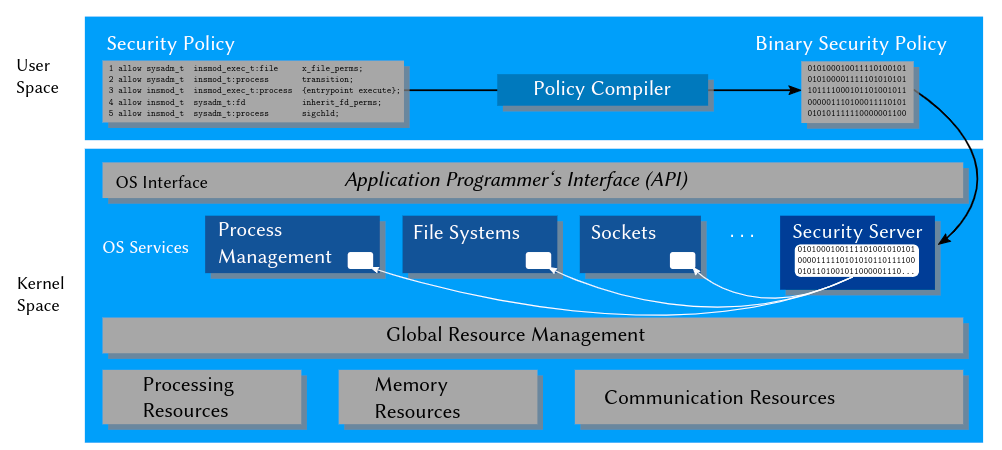
Policy Enforcement in SELinux
- Security Server: Policy runtime environment (protected in kernel space)
- Interceptors:Total control of critical interactions
- Policy Compiler: Translates human-readable policy modules in kernel-readable binary modules
- Security Server: Manages and evaluates these modules
Implementation Alternative B
Application-embedded Policy: The security policy is only known and enforced by oneuser program \rightarrow implemented in a user-space application
Application-level Security Architecture: The security policy is known and enforced by several collaborating user programs in anapplication systems \rightarrow implemented in a local, user-space security architecture
Policy Server Embedded in Middleware: The security policy is communicated and enforced by several collaborating user programs in adistributed application systems \rightarrow implemented in a distributed, user-space security architecture
Security Models
Why We Use Formal Models
Self-Study Task
Please read each of the following scenarios. Then select the statement you intuitively think is most likely:
- Linda is a young student with a vision. She fights against environmental pollution and volunteers in an NGO for climate protection. After finishing her studies ...
- ... she becomes an attorney for tax law.
- ... she becomes an attorney for tax law, but in her spare time consults environmental activists and NGOs.
- Suppose during the 2022 football world cup, Germany reaches the knockout phase after easily winning any game in the previous group phase.
- Germany wins the semi-final.
- Germany wins the world cup. Think twice about your choices. Can you imagine what other people chose, and why?
Goal of Formal Security Models
- Complete, unambiguous representation of security policies for
- analyzing and explaining its behavior:
\rightarrow"This security policy will never allow that ..."\rightarrow"This security policy authorizes/denies an access under conditions ... because ..."
- enabling its correct implementation:
\rightarrow"This rule is enforced by a C++ method ..."
How We Use Formal Models: Model-based Methodology
- Abstraction from (usually too complex) reality
\rightarrowget rid of insignificant details e. g.: allows statements about computability and computation complexity - Precisionin describing what is significant
\rightarrowModel analysis and implementation
Security Model
A security model is a precise, generally formal representation of a security policy.
Model Spectrum
- Models for access control policies:
- identity-based access control (IBAC)
- role-based access control (RBAC)
- attribute-based access control (ABAC)
- Models for information flow policies
\rightarrowmultilevel security(MLS)
- Models for non-interference/domain isolation policies
\rightarrownon-interference(NI)
- In Practice: Most oftenhybrid models
Access Control Models
Formal representations of permissions to execute operations on objects, e. g.:
- Reading files
- Issuing payments
- Controlling industrial centrifuges
Security policies describeaccess rules
\rightarrowsecurity models formalize them
Taxonomy
Identity-based access control models (IBAC)
Rules based on the identity of individual subjects (users, apps, processes, ...) or objects (files, directories, database tables, ...)
\rightarrow"Ann may read ProjectX Files."
Role-based access control models (RBAC)
Rules based on roles of subjects in an organization
\rightarrow"Ward physicians may modify electronic patient records (EPRs) in their ward."
Attribute-based access control models (ABAC)
Rules based on attributes of subjects and objects
\rightarrow"PEGI 18 rated movies may only be streamed to users aged 18 and over."
Discretionary Access Control (DAC)
Individual users specify access rules to objects within their area of responsibility ("at their discretion").
Example: Access control in many OS (e. g. Unix(oids), Windows)
Consequence: Individual users
- enjoy freedom w. r. t. granting access permissions as individually needed
- need to collectively enforce their organization’s security policy:
- competency problem
- responsibility problem
- malware problem
Mandatory Access Control (MAC)
System designers and administrators specify system-wide rules, that apply for all users and cannot be sidestepped.
Examples:
- Organizational: airport security check
- Technical: medical information systems, policy-controlled operating systems(e. g. SELinux)
Consequence:
- Limited individual freedom
- Enforced by central instance:
- clearly identified
- competent (security experts)
- responsible (organizationally & legally)
DAC vs. MAC
In Real-world Scenarios: Mostly hybrid models enforced by both discretionary and mandatory components, e. g.:
- DAC: locally within a project, team members individually define permissions w. r. t. documents (implemented in project management software and workstation OSs) inside this closed scope;
- MAC:globally for the organization, such that e. g. only documents approved for release by organizational policy rules (implemented in servers and their communication middleware) may be accessed from outside a project’s scope.
Identity-based Access Control Models (IBAC)
Goal: To precisely specify the rights ofindividual, acting entities.
- User named s reads file named o
- Client s transfers money to bank account o
- Process with ID s sends over socket with ID o
There are
- Subjects, i. e. active and identifiable entities, that execute
- operations on
- passive and identifiable objects, requiring
- rights (also: permissions, privileges) which
- control (restrict) execution of operations,
- are checked against identity of subjects and objects.
Access Control Functions [Lampson, 1974]
- A really basic model to define access rights:
- Who (subject) is allowed to do what (operation) on which object
- Fundamental to OS access control since 1965 (Multics OS)
- Formal paradigms: sets and functions
- Access Control Function (ACF)
f:S \times O \times OP \rightarrow \{true,false\}where- S is a set of subjects (e. g. users, processes),
- O is a set of objects(e. g. files, sockets, EPRs),
- OP is a finite set of operations(e. g. reading, writing, deleting).
- Interpretation: Rights to execute operations are modeled by the ACF:
- any
s\in Srepresents an authenticated active entity (e. g. a user or process) which potentially executes operations on objects - any
o\in Orepresents an authenticated passive entity (e. g. a file or a database table) on which operations are executed - for any
s\in S,$o\in O$,$op\in OP$:s is allowed to execute op on o iff f(s,o,op)=true. - Model making: finding a
tuple\langleS,O,OP,f\rangle\rightarrowDefinition of S,O, and OP\rightarrowDefinition of f
- any
iff = "if and only if"
Example: Implementation of f in a Unix OS (heavily simplified):
- S: set of identifiers for users who execute processes
- O: set of identifiers for system objects, e. g. files, directories, sockets, ...
- OP: set of system call identifiers
Example for f(caller,file,read):
read ( caller , file ) {
if !(caller.uid == 0) {/* is caller == root? */
if !(R_MODE in file.inode.othersRWX) {/* check "other"-rights */
if !(caller.gid == file.inode.group && R_MODE in file.inode.groupRWX) {/* check "group"-rights */
if !(caller.uid == file.inode.owner && R_MODE in file.inode.ownerRWX) {/* check "group"-rights */
return ERR_ACCESS_DENIED;/* insufficient rights: deny access */
} } }
/* execute syscall "read" */
}
Self-Study Task
Have a look at your (or any) operating system’s API documentation. Find a few examples for
- operations executable by user processes (e. g. Linuxsyscalls),
- their arguments,
- the operating systems resources they work with. Try to distinguish between subjects, objects and operations as defined in the classical ACF model. Can you see any ambiguities or inconsistencies w. r. t. the model? If you have never worked with an OS API, stick to the simple things (such as reading/writing a file). For Linux, you may find help insection 2 of the online manpages.a ahttp://man7.org/linux/man-pages/dir_section_2.html
Access Control Matrix
Access Control Functions in Practice Lampson [1974] already addresses the questions how to ...
- store in a well-structured way,
- efficiently evaluate, and
- completely analyze an ACF:
Access Control Matrix (ACM)
An ACM is a matrix
m:S\times O \rightarrow 2^{OP}, such that\forall s\in S,\forall o\in O:op\in m(s,o)\Leftrightarrow f(s,o,op).
An ACM is a rewriting of the definition of an ACF: nothing is added, nothing is left out ("$\Leftrightarrow$"). Despite a purely theoretical model: paved the way for practically implementing AC meta-informationas
- tables
- 2-dimensional lists
- distributed arrays and lists
Example
S=\{s_1 ,...,s_n\}O=\{o_1 ,...,o_k\}OP=\{read,write\}- $2^{OP}={\varnothing,{read},{write},{read,write}}^2$

Implementation Notes
- ACMs are implemented in most
- Operating systems
- Database information systems
- Middleware platforms(CORBA, Jini/Apache River, Web Services)
- Distributed security architectures (Kerberos)
- whose security mechanisms use one of two implementations:
Access Control Lists (ACLs)
- Columns of the ACM:
char*o3[N] = { "-", "-", "rw", ...}; - Found in I-Nodes of Unix(oids), Windows, Mac OS
Capability Lists
- Rows of the ACM:
char* s1[K] = { "-", "r", "-", ...}; - Found in distributed OSs, middleware, Kerberos
What we Actually Model:
Protection State
A fixed-time snapshot of all active entities, passive entities, and any meta-information used for making access decisions is called theprotection state of an access control system.
Goal of ACFs/ACMs
To precisely specify a protection state of an AC system.
The Harrison-Ruzzo-Ullman Model (HRU)
Our HIS scenario ... modeled by an ACM:
S=\{cox, kelso, carla,...\}O=\{patId, diag, medic,...\}
| m | parId | diag | medic | ... |
|---|---|---|---|---|
| cox | {read, write} | {read, write} | {read, write} | ... |
| kelso | {read} | {read} | {read} | ... |
| carla | {read} | \varnothing |
{read} | ... |
| ... |
We might do it like this, but ... Privilege escalation question:
"Can it ever happen that in a given state, some specific subject obtains a specific permission?"
\varnothing \Rightarrow \{r,w\}
- ACM models a single state \langleS,O,OP,m\rangle
- ACM does not tell us anything about what might happen in the future
- Behavior prediction
\rightarrowproliferation of rights\rightarrowHRU safety
Why "safety", not "security"? Well, historical ...
We need a model which allows statements about
- Dynamic behavior of right assignments
- Complexity of such an analysis
Idea [Harrison et al., 1976]: A (more complex) security model combining
- Lampson’s ACM
\rightarrowfor modeling single protection state (snapshots) of an AC system - Deterministic automata (state machines)
\rightarrowfor modeling runtime changes of a protection state
This idea was pretty awesome. We need to understand automata, since from then on they were used for most security models. \rightarrow Small excursus
Deterministic Automata
Mealy Automaton: \langleQ,\sum,\Omega,\delta,\lambda,q_0\rangle
Qis a finite set of states (state space), e. g.Q=\{q_0 ,q_1 ,q_2\}\sumis a finite set of input words (input alphabet), e. g.\sum=\{a,b\}\Omegais a finite set of output words (output alphabet), e. g.\Omega=\{yes,no\}\delta:Q\times\sum\rightarrow Qis the state transition function\lambda:Q\times\sum\rightarrow\Omegais the output functionq_0\in Qis the initial state\delta(q,\sigma)=q′and\lambda(q,\sigma)=\omegacan be expressed through thestate diagram: a directed graph\langleQ,E\rangle, where each edgee\in Eis represented by a state transition’s predecessor nodeq, its successor nodeq′, and a string "$\sigma|\omega$" of its input and output, respectively.
Example: Return "yes" for any input in an unbroken sequence of "a" or "b", "no" otherwise.

Self-Study Task
I bought a new bluetooth headset for giving this lecture. It has just one button and an LED, and this is what the manual says:
- Turn the device on by holding the button for 1 sec.
- Turn the device off at any time by holding for 5 sec.
- Turn the device on in bluetooth pairing mode by holding for 5 sec.
- Switch to pairing mode when on, but not in a phone call, by holding for 1 sec.
- Leave pairing mode by clicking the button.
- Click to start a call. While in a call, click to hang up.
- While on, the LED indicates modes: red during a call, yellow during pairing, green otherwise. Define a mealy automaton for using this headset by defining
Q,\sum,\Omega,andq_0and draw the state diagram for\sigmaand\lambda.
HRU Security Model
How we use Deterministic Automata
- Snapshot of an ACMis the automaton’s state
- Changes of the ACMduring system usage are modeled by state transitions of the automaton
- Effects ofoperationsthat cause such transitions are described by the state transition function
- Analyses ofright proliferation(
\rightarrowprivilege escalation)are enabled by state reachability analysis methods
An HRU model is a deterministic automaton \langleQ,\sum,\delta,q_0 ,R\rangle where
Q= 2^S\times 2^O\times Mis the state space where- S is a (not necessarily finite) set of subjects,
- O is a (not necessarily finite) set of objects,
M=\{m|m:S\times O\rightarrow 2^R\}is a (not necessarily finite) set of possible ACMs,
\sum=OP\times Xis the (finite) input alphabet whereOPis a set of operations,X=(S\cup O)^kis a set of k-dimensional vectors of arguments (subjects or objects) of these operations,
\sigma:Q\times\sum\rightarrow Qis the state transition function,q_0\in Qis the initial state,- R is a (finite) set of access rights.
Interpretation
- Each
q=S_q,O_q,m_q\in Qmodels a system’s protection state:- current subjects set
S_q\subseteq S - current objects set
O_q\subseteq O - current ACM
m_q\in Mwherem_q:S_q\times O_q\rightarrow 2^R
- current subjects set
- State transitions modeled by
\deltabased on- the current automaton state
- an input word
\langleop,(x_1,...,x_k)\rangle\in\sumwhereop- may modify
S_q(create a userx_i, kill a processx_ietc.), - may modify
O_q(create/delete a filex_i, open a socketx_ietc.), - may modify the contents of a matrix cell
m_q(x_i,x_j)(enter or remove rights) where1\leq i,j\leq k.
- may modify
\rightarrowWe also call\deltathe state transition scheme (STS) of a model.- Historically: "authorization scheme" [Harrison et al., 1976].
State Transition Scheme (STS)
Using the STS, \sigma:Q\times\sum\rightarrow Q is defined by a set of specifications in the normalized form
$\sigma(q,\langleop,(x_1,...,x_k)\rangle)$=if r_1\in m_q(x_{s1},x_{o1}) \wedge ... \wedge r_m\in m_q(x_{sm},x_{om}) then p_1\circle ...\circle p_n where
q=\{S_q,O_q,m_q\}\in Q,op\in OPr_1 ...r_m\in Rx_{s1},...,x_{sm}\in S_qandx_{o1},...,x_{om}\in O_qwheres_iando_i,1\leq i\leq m, are vector indices of the input arguments:1\leq s_i,o_i\leqkp_1,...,p_nare HRU primitives- Note:
\circleis the (transitive) function composition operator:(f\circle g)(x)=g(f(x))
Whenever q is obvious or irrelevant, we use a programming-style notation
Interpretation: The structure of STS definitions is fixed in HRU:
- "if": A conjunction of condition clauses (or just conditions) with the sole semantics "is some right in some matrix cell".
- "then": A concatenation (sequential execution) of HRU primitives.
Conditions:
Expressions that need to evaluate "true" for state q as a necessary precondition for command op to be executable (= can be successfully called).
Primitives:
Short, formal macros that describe differences between q and a successor state q′=\sigma(q,\langleop,(x_1 ,...,x_k)\rangle) that result from a complete execution of op:
- enter r into
m(x_s,x_o) - delete r from
m(x_s,x_o) - create subject
x_s - create object
x_o - destroy subject
x_s - destroy object
x_o \rightarrowEach of these with the intuitive semantics for manipulatingS_q, O_qorm_q.
Note the atomic semantics: the HRU model assumes that each command successfully called is always completely executed!
How to Design an HRU Security Model:
- Model Sets: Subjects, objects, operations, rights
\rightarrowdefine the basic setsS,O,OP,R - STS: Semantics of operations (e. g. the future API of the system to model) that modify the protection state
\rightarrowdefine\sigmausing the normalized form/programming syntax of the STS - Initialization: Define a well-known initial stateq
0 =\langleS_0 ,O_0 ,m_0 \rangleof the system to model
An Open University Information System

- Informal security policy (heavily simplified):2 rules
- "A sample solution for home assignments can be downloaded by students only after submitting their own solution."
- a condition for readSample
- a effect of writeSolution
- "Student solutions can be submitted only before downloading any sample solution."
- a condition for writeSolution
- a effect of readSample
- "A sample solution for home assignments can be downloaded by students only after submitting their own solution."
Model Making
- Sets
- Subjects, objects, operations, rights:
- Subjects: An unlimited number of possible students:
S\congruent\mathbb{N}(S is isomorphic toN) - Objects: An unlimited number of possible solutions:
O\congruent\mathbb{N} - Operations:
- (a) Submit own solution:
writeSolution(s_{student},o_{solution}) - (b) Download sample solution:
readSample(s_{student},o_{sample}) \rightarrow OP=\{writeSolution, readSample\}
- (a) Submit own solution:
- Rights: Exactly one right allows to execute each operation:
R\congruent OP\rightarrow R=\{write, read\}
- Subjects: An unlimited number of possible students:
- State Transition Scheme
- Effects of operations on protection state:
- writeSolution
Informal Policy: "A sample solution (...) can be downloaded by students only after submitting their own solution."
\Leftrightarrow"If the automaton receives an input \langlewriteSolution,(s,o)\rangle and the conditions are satisfied, it transitions to a state where s is allowed to download the sample solution."command writeSolution(s,o) ::= if write $\in$ m(s,o) then enter read into m(s,o); fi - readSample
Informal Policy: "Student solutions can be submitted only before downloading any sample solution."
\Leftrightarrow"If the automaton receives an input\langlereadSample,(s,o)\rangleand the conditions are satisfied, it transitions to a state wheresis denied to submit a solution."command readSample(s,o) ::= if read$\in$ m(s,o) then delete write from m(s,o); fi
- writeSolution
Informal Policy: "A sample solution (...) can be downloaded by students only after submitting their own solution."
- Initialization
- By model definition:
q_0 =\langleS_0 ,O_0 ,m_0 \rangle - For a course with (initially) three students:
S_0 =\{sAnn, sBob, sChris\}O_0 =\{oAnn, oBob, oChris\}m_0:m_0(sAnn,oAnn)=\{write\}m_0(sBob,oBob)=\{write\}m_0(sChris,oChris)=\{write\}m_0(s,o)=\varnothing \Leftrightarrow s\not= o
- Interpretation: "There is a course with three students, each of whom has their own workspace to which she is allowed to submit (write) a solution."
Model Behavior
- Initial Protection State
m oAnn oBob oChris sAnn {write} \varnothing\varnothingsBob \varnothing{write} \varnothingsChris \varnothing\varnothing{write} - After
writeSolution(sChris, oChris)m oAnn oBob oChris sAnn {write} \varnothing\varnothingsBob \varnothing{write} \varnothingsChris \varnothing\varnothing{write, read} - After
readSample(sChris, oChris)m oAnn oBob oChris sAnn {write} \varnothing\varnothingsBob \varnothing{write} \varnothingsChris \varnothing\varnothing{read}
Summary
- Model Behavior
- The model’sinputis a sequence of actions from OP together with their respective arguments.
- The automaton changes its state according to the STS and the semantics of HRU primitives (here: enter and delete).
- In the initial state, each student may (repeatedly) submit her respective solution.
- Tricks in this Example
- The sample solution is not represented by a separate object
\rightarrowno separate column in the ACM. - Instead, we smuggled thereadright for it into the cell of each student’s solution ...
- The sample solution is not represented by a separate object
- Where Do We Stand?
- We can now model a security policy for particular IBAC scenarios
- We can formally express them through an automaton-based framework.
- What’s Next? Why all this?
- Correct specification and implementation of the modeled policy
- Analysis of security properties
\rightarrowNext ...
HRU Model Analysis
- Reminder: "For a given security model, is it possible that a subjecteverobtains a specific permission with respect to a specific object?"
- Analysis of Right Proliferation
\rightarrowThe HRU safety problem.
InputSequences
- "What is the effect of an input in a given state?"
\rightarrowasingle state transitionas defined by\delta - "What is the effect of an input sequence in a given state?"
\rightarrowa composition ofsequential state transitionsas defined by\delta*
Transitive State Transition Function$\delta$^*
Let
\sigma\sigma\in\sum^*be a sequence of inputs consisting of a single input\sigma\in\sum\cup\{\epsilon\}followed by a sequence\sigma\in\sum^^*, where\epsilondenotes an empty input sequence. Then,\delta^*:Q\times\sum^^*\rightarrow Qis defined by
\delta^*(q,\sigma\sigma^^*)=\delta^^*(\delta(q,\sigma),\sigma^^*)\delta^^*(q,\epsilon)=q.
HRU Safety
A state q of an HRU model is called HRU safe with respect to a right r\in R iff, beginning with q, there is no sequence of commands that enters r in an ACM cell where it did not exist in q.
According to Tripunitara and Li [2013], this property (Due to more technical details, it’s called simple-safety there.) is defined as:
HRU Safety
For a state
q=\{S_q,O_q,m_q\}\in Qand a rightr\in Rof an HRU model\langleQ,\sum,\delta,q_0,R\rangle, the predicatesafe(q,r)holds iff\forall q′= S_{q′},O_{q′},m_{q′} \in \{\delta^^*(q,\sigma^^*)|\sigma^^*\in\sum^^*\},\forall s\in S_{q′},\forall o\in O_{q′}: r\in m_{q′}(s,o)\Rightarrow s\in S_q \wedge o\in O_q \wedge r\in m_q(s,o).We say that an HRU model is safe w.r.t. r iff
safe(q_0 ,r).
HRU Safety
Examples
- Assume all states in
{\delta^^*(q,\sigma^^*)|\sigma^^*\in\sum^^*\}have been validated except forq′:-
State transfer 1
m_qo_1o_2o_3s_1\{r_1,r_3\}\{r_1,r_3\}\{r_2\}s_2${r_1} \{r_1\}\{r_2\}s_3\varnothing\varnothing\{r_2\}\Rightarrow \delta^*(q,\sigma^*)m_{q'}o_1o_2o_3s_1\{r_1,r_3\}\{r_1\}\{r_2\}s_2${r_1,r_2} \{r_1\}\{r_2\}s_3\varnothing\varnothing\varnothingr_3\not\in m_{q′}(s_1,o_2)\wedge r_3\in m_q(s_1,o_1)\Rightarrow safe(q,r_3)r_2\in m_{q′}(s_2,o_1)\wedge r_2 \not\in m_q(s_2,o_1)\Rightarrow\lnot safe(q,r_2)
-
State transfer 2
m_qo_1o_2o_3s_1\{r_1,r_3\}\{r_1,r_3\}\{r_2\}s_2${r_1} \{r_1\}\{r_2\}s_3\varnothing\varnothing\{r_2\}\Rightarrow \delta^*(q,\sigma^*)m_{q'}o_1o_2o_3o_4s_1\{r_1,r_3\}\{r_1,r_3\}\{r_2\}\varnothings_2${r_1} \{r_1\}\{r_2\}\{r_2\}s_3\varnothing\varnothing\{r_2\}\varnothing\forall s\in S_{q′}:r_3\not\in m_{q′}(s,o_4)\wedge r_3\in m_q(s_1,o_1)\wedge r_3\in m_q(s_1,o_2)\Rightarrow safe(q,r_3)r_2\in m_{q′}(s_2,o_4)\wedge o_4\not\in O_q\Rightarrow\lnot safe(q,r_2)
-
Let’s dissect the previous definitions: from a practical perspective, showing that an HRU model is safe w.r.t. r means to
- Search for any possible (reachable) successor state
q′ofq_0("${\delta(q_0,\sigma)|\sigma\in\sum}$") - Visit all cells in
m_{q′}("$\forall s\in S_{q′},\forall o\in O_{q′}:...$") - If r is found in one of these cells ("$r\in m_{q′}(s,o)$"), check if
m_qis defined for this very cell ("$s\in S_q\wedge o\in O_q$"),rwas already contained in this very cell inm_q("$r\in m_q(s,o)$").
- Recursively proceed with 2. for any possible successor state
q′′ofq′("${\delta^^(q_0,\sigma^^)|\sigma^^\in\sum^^}$")
Safety Decidability
Theorem 1 [Harrison et al., 1976]
Ingeneral, HRU safety is not decidable.
Theorem 2 (also Harrison et al. [1976])
For mono-operational models, HRU safety is decidable.
"So ... what is amono-operational HRU model?" \rightarrow exactly one primitive for each operation in the STS:
command op(x_1 , ...,x_k) ::= if r_1 \in m(x_s1 ,x_o1 ) \wedge
... \wedge
r_m \in m(x_sm,x_om)
then
p_1;
fi
- Theorem 1: See Harrison et al. [1976], reduction to the Halteproblem.
- Theorem 2: We’ll have a closer look at this one ...
- Insights into the operational principles modeled by HRU models
- Demonstrates a method to prove safety property for a particular, given model
\rightarrow"Proofs teach us how to build things so nothing more needs to be proven." (W. E. Kühnhauser)
Proof of Theorem
- Proof Sketch
- Find an upper bound for the length of all input sequences with different effects on the protection state w.r.t. safety
If such can be found:
\existsa finite number of input sequences with different effects - All these inputs can be tested whether they violate safety. This test terminates because:
- each input sequence is finite
- there is only a finite number of relevant sequences
\rightarrowsafety is decidable
- Find an upper bound for the length of all input sequences with different effects on the protection state w.r.t. safety
If such can be found:
Given a mono-operational HRU model.
Let \sigma_1...\sigma_n be any sequence of inputs in \sum^* that violates safe(q,r), and let p_1...p_n be the corresponding sequence of primitives (same length, since mono-operational).
Proposition: For each such sequence, there is a corresponding finite sequence that
- Still violates
safe(q,r) - Consists only of enter and two initial create primitives
In other words: For any input sequence,$\exists$ a finite sequence with the same effect.
Proof:
- We construct these finite sequences ...$\rightarrow$
- Transform
\sigma_1...\sigma_ninto shorter sequences with the same effect:- Remove all input operations that contain delete or destroy primitives. The sequence still violates
safe(q,r), because conditions of successive commands must still be satisfied (no absence, only presence of rights is checked). - Prepend the sequence with an initial create subject
s_{init}operation. This won’t change its netto effect, because the new subject isn’t used anywhere. - Prune the last create subject s operation and substitute each following reference to s with
s_{init}. Repeat until allcreate subjectoperations are removed, except from the initialcreate subject sinit. - Same as steps 2 and 3 for objects.
- Remove all redundant enter operations (remember: each matrix cell is a set
\rightarrowunique elements).
- Remove all input operations that contain delete or destroy primitives. The sequence still violates
Example:
| init | 1. | 2. | 3. | 4. | 5. |
|---|---|---|---|---|---|
| ... | ... | create subject s_{init}; |
create subject s_{init}; |
create subject s_{init}; |
create subject s_{init}; |
| ... | ... | ... | ... | create object o_{init} |
create object o_{init} |
| create subject x2; | create subject x2; | create subject x2; | - | - | - |
| create object x5; | create object x5; | create object x5; | create object x5; | - | - |
| enter r1 into m(x2,x5); | enter r1 into m(x2,x5); | enter r1 into m(x2,x5); | enter r1 into m(s_{init},x5); |
enter r1 into m(s_{init},o_{init}); |
enter r1 into m(s_{init},o_{init}); |
| enter r2 into m(x2,x5); | enter r2 into m(x2,x5); | enter r2 into m(x2,x5); | enter r2 into m(s_{init},x5); |
enter r2 into m(s_{init},o_{init}); |
enter r2 into m(s_{init},o_{init}); |
| create subject x7; | create subject x7; | create subject x7; | - | - | - |
| delete r1 from m(x2,x5); | - | - | - | - | - |
| destroy subject x2; | - | - | - | - | - |
| enter r1 into m(x7,x5); | enter r1 into m(x7,x5); | enter r1 into m(x7,x5); | enter r1 into m(s_{init},x5); |
enter r1 into m(s_{init},o_{init}); |
- |
| ... | ... | ... | ... | ... | ... |
Observations
- after step 3:
- Except for
s_{init}, the sequence creates no more subjects - All rights of the formerly created subjects are accumulated in
s_{init}\rightarrowfor the evaluation ofsafe(q,r), nothing has changed:- generally:
\forall s\in S_{q′},\forall o\in O_{q′}:r\in m_{q′}(s,o)\Rightarrow s\in S_q\wedge o\in O_q\wedge r\in m_q(s,o) - in this case:
\forall s\in S_{q′},\forall o\in O_{q′}:r\in m_{q′}(s,o)\Rightarrow s\not=s_{init}\wedge o\in O_q\wedge r\in m_q(s,o)
- generally:
- The sequence is generally shorter (never longer) than before
- Except for
- Final Observations
- Except for
s_{init}ando_{init}, the sequence creates no subjects or objects - All entered rights are accumulated in
m_{q′}(s_{init},o_{init}):- generally:
\forall s\in S_{q′},\forall o\in O_{q′}:r\in m_{q′}(s,o)\Rightarrow s\in S_q\wedge o\in O_q\wedge r\in m_q(s,o) - here:
\forall s\in S_{q′},\forall o\in O_{q′}:r\in m_{q′}(s,o)\Rightarrow s\not=s_{init}\wedge o\not=o_{init}\wedge r\in m_q(s,o)
- generally:
- This sequence still violates
safe(q,r), but its length is restricted to(|S_q| + 1)(|O_q|+1)|R|+2because- Each enter must enter a new right into a cell
- The number of cells is restricted to
(|S_q| + 1)(|O_q|+1)
- Except for
Conclusions from these Theorems
- Dilemma:
- General (unrestricted) HRU models
- have strong expressiveness
\rightarrowcan model a broad range of AC policies - are hard to analyze: algorithms and tools for safety analysis
\rightarrowcannot certainly produce accurate results\rightarroware hard to design for approximative results
- have strong expressiveness
- Mono-operational HRU models
- have weak expressiveness
\rightarrowgoes as far as uselessness: e. g. for modeling Unix creat(can only create files, sockets, IPC, ... that no user process can access!) - are efficient to analyze: algorithms and tools for safety analysis
\rightarroware always guaranteed to terminate\rightarroware straight-forward to design
- have weak expressiveness
- General (unrestricted) HRU models
Consequences:
- Model variants with restricted yet usable expressiveness have been proposed
- Heuristic analysis methods try to provide educated guesses about safety of unrestricted HRU
(A) Restricted Model Variants
Static HRU Models
- Static: no create primitives allowed
- safe(q,r) decidable, but NP-complete problem
- Applications: (static) real-time systems, closed embedded systems
Monotonous Mono-conditional HRU Models
- Monotonous (MHRU): no delete or destroy primitives
- Mono-conditional: at most one clause in conditions part (For monotonous bi-conditional models, safety is already undecidable ...)
- safe(q,r) efficiently decidable
- Applications: Archiving/logging systems (where nothing is ever deleted)
Finite Subject Set
\forall q\in Q,\exists n\in N: |S_q|\leq nsafe(q,r)decidable, but high computational complexity
Fixed STS
- All STS commands are fixed, match particular application domain (e.g. OS access control [Lipton and Snyder, 1977])
\rightarrowno model reusability - For Lipton and Snyder [1977]:
safe(q,r)decidable in linear time (!)
Strong Type System
- Special model that generalizes HRU: Typed Access Matrix (TAM) [Sandhu, 1992]
safe(q,r)decidable in polynomial time for ternary, acyclic, monotonous variants- high, though not unrestricted expressiveness in practice
(B) Heuristic Analysis Methods
Motivation:
- Restricted model variants: often too weak for real-world applications
- General HRU models: safety property cannot be guaranteed
\rightarrowLet’s try to get a piece from both cakes: Heuristically guided safety estimation [Amthor et al., 2013]
Idea:
- State-space exploration by model simulation
- Task of heuristic: generating input sequences ("educated guessing")
Outline: Two-phase-algorithm to analyze safe(q_0,r):
- Static phase: Infer knowledge from the model that helps heuristic to make "good" decisions.
\rightarrowRuntime: polynomial in model size (q_0 + STS)
- Simulation phase: The automaton is implemented and, starting with
q_0, fed with inputs\sigma=\langleop,x\rangle\rightarrowFor each\sigma, the heuristic has to decide:- which operation op to use
- which vector of arguments x to pass
- which
q_ito use from the states inQknown so far
- Termination: As soon as
\sigma(q_i,\sigma)violatessafe(q_0,r).
Goal: Iteratively build up the (possibly infinite!) Q for a model to falsify safety by example (finding a violating, but possible protection state).
Results:
- Termination: Well ... we only have a semi-decidable problem here: It can be guaranteed that a model is unsafe if we terminate. We cannot ever prove the opposite, however! (
\rightarrowsafety undecidability) - Performance: A few results
- 2013:Model size 10 000 ≈2215 s
- 2018:Model size 10 000 ≈0,36 s
- 2018:Model size 10 000 000 ≈417 s
Achievements:
- Find typical errors in security policies: Guide their designers, who might know there’s something wrong w. r. t. right proliferation, but not what and why!
- Increase our understanding of unsafety origins: By building clever heuristics, we started to understand how we might design specialized HRU models (
\rightarrowfixed STS, type system) that are safety-decidable yet practically (re-) usable [Amthor and Rabe, 2020].
Summary HRU Models
Goal
- Analysis of right proliferation in AC models
- Assessing the computational complexity of such analyses
Method
- Combining ACMs and deterministic automata
- Defining
safe(q,r)based on this formalism
Conclusions
- Potential right proliferation (privilege escalation): Generally undecidable problem
\rightarrowHRUmodel family, consisting of application-tailored, safety-decidable variants\rightarrowHeuristic analysis methods for practical error-finding
The Typed-Access-Matrix Model (TAM)
Goal
- AC model, similar expressiveness to HRU
\rightarrowcan be directly mapped to implementations of an ACM: OS ACLs, DB permission assignment tables- Better suited for safety analyses: precisely statemodel properties for decidable safety
Idea [Sandhu, 1992]
- Adopted from HRU: subjects, objects, ACM, automaton
- New: leverage the principle of strong typing known from programming
\rightarrowsafety decidability properties relate to type-based restrictions
How it Works:
- Foundation of a TAM model is an HRU model
\langleQ,\sum,\delta,q_0 ,R\rangle, whereQ= 2^S\times 2^O\times M - However:
S\subseteq O, i. e.:- all subjects can also act as objects (=targets of an access)
\rightarrowuseful for modeling e. g. delegation ("s has the right to grant s′ her read-right")- objects in
O\backslash S: pure objects
- Each
o\in Ohas a type from a type setTassigned through a mappingtype:O\rightarrow T - An HRU model is a special case of a TAM model:
T=\{tSubject,tObject\}\forall s\in S:type(s)=tSubject; \forall o\in O\backslash S:type(o)=tObject
TAM Security Model
A TAM model is a deterministic automaton
\langleQ,\sum,\delta,q_0 ,T,R\ranglewhere
Q= 2^S\times 2^O\times TYPE\times Mis the state space whereSandOare subjects set and objects set as in HRU, whereS\subseteq O,TYPE=\{type|type:O\rightarrow T\}is a set of possible type functions,Mis the set of possibleACMsas in HRU,\sum=OP\times Xis the (finite) input alphabet whereOPis a set of operations as in HRU,X=O^kis a set of $k$-dimensional vectors of arguments (objects) of these operations,\delta:Q\times\sum\rightarrow Qis the state transition function,q_0\in Qis the initial state,Tis a static (finite) set of types,Ris a (finite) set of access rights.
State Transition Scheme (STS)
\delta:Q\times\sum\rightarrow Q is defined by a set of specifications:
 where
where
q= (S_q,O_q,type_q,m_q)\in Q,op\in OPr_1,...,r_m\in Rx_{s1},...,x_{sm}\in S_q,x_{o1},...,x_{om}\in Oq\backslash S_q, andt_1,...,t_k\in Twheres_iando_i, 1\leq i\leq m, are vector indices of the input arguments:1\leq s_i,o_i\leq kp_1,...,p_nare TAM primitives- Convenience Notation where
- TAM-specific
TAM-specific
- Primitives:
- enter r into m(x_s,x_o)
- delete r from m(x_s,x_o)
- create subject x_s of type t_s
- create object x_o of type t_o
- destroy subject x_s
- destroy object x_o
- Observation:
SandOare dynamic (as in HRU), thustype:O\rightarrow Tmust be dynamic too (cf. definition ofQin TAM).
TAM Example: The ORCON Policy
- Example Scenario: Originator Controlled Access Rights (ORCON Policy)
- Goal: To illustrate usefulness/convenience of type system
- ORCON describes sub-problem of larger policies
- Information flow confinement required by ORCON is tricky to do in HRU ("This information may not flow beyond ...")
- The Problem
- Solution with TAM
- Idea: A confined subject type that can never execute any operation other than reading
- Model Initialization:
- Subjects:
S_0=\{ann,bob,chris\} - Objects:
O_0 =S_0\cup\{projectX\} - Operations:
\rightarrownext ... - Rights:
R=\{read,write,cread,own,parent\} - Types:
T=\{s,cs,co\}(regular subject,confined subject/object) type_0:type_0(ann)=stype_0(bob)=stype_0(projectX)=co
- Subjects:
- Model Behavior (Example)
- ann creates ORCON object projectX (STS command createOrconObject)
- ann grants cread ("confined read") right for projectX to bob (STS command grantCRead)
- bob uses cread to create confined subject chris with permission to read projectX (STS command useCRead)
m ann:s bob:s projectX:co chris:cs ann:s \varnothing\varnothing\{own, read, write\}\varnothingbob:s \varnothing\varnothing\{cread\}\{parent\}chris:cs \varnothing\varnothing\{read\}\varnothing
- Model Behavior (STS)
- The State Transition Scheme
- createOrconObject
command createOrconObject(s_1:s, o_1:co) ::= if true then create object o_1 of type co; enter own into m(s_1 ,o_1); enter read into m(s_1 ,o_1); enter write into m(s_1 ,o_1); fi - grantCRead
command grantCRead(s 1 :s,s 2 :s,o 1 :co) ::= if own ∈ m(s_1 ,o_1) then enter cread into m(s_2 ,o_1); fi - useCRead
command useCRead(s_1:s, o_1:co, s_2:cs) ::= if cread ∈ m(s_1 ,o_1) then create subject s_2 of type cs; enter parent into m(s_1 ,s_2); enter readinto m(s_2 ,o_1); fi - Enable ann to revoke cread from bob:
command revokeCRead(s_1:s, s_2:s, o_1:co) ::= if own ∈ m(s_1, o_1) then delete cread from m(s_2, o_1); fi - Enable ann to destroy conf. object projectX:
command destroyOrconObject(s_1:s, o_1:co) ::= if own ∈ m(s_1 ,o_1) then destroy object o_1; fi - Enable ann to destroy conf. subject chris:
command revokeRead(s_1:s, s_2:cs, o_1:co) ::= if own ∈ m(s_1 ,o_1) ∧ read ∈ m(s_2 ,o_1) then destroy subject s_2; fi - Enable bob to destroy conf. subject chris:
command finishOrconRead(s_1:s, s_2:cs) ::= if parent ∈ m(s_1, s_2) then destroy subject s_2; fi
- createOrconObject
- Commands 1.-3.:
- Authorize the steps in the example above
- Are monotonic
- Commands 4.-7.:
- Will control right revocation
\rightarrowessence of originator control - Are not monotonic (consequences ...)
- Will control right revocation
- The State Transition Scheme
- Summary
- Contributions of ORCON Example
- Owner ("originator") retains full control over
- Use of her confined objects by third parties
\rightarrowtransitive right revocation - Subjects using (or misusing) these objects
\rightarrowdestruction of these subjects
- Use of her confined objects by third parties
- Subjects using such objects are confined: cannot forward read information
- Owner ("originator") retains full control over
- Contributions of ORCON Example
TAM Safety Decidability
Why all this?
- General TAM models (cf. previous definition)
\rightarrowsafety not decidable (no surprise, since generalization of HRU) - MTAM:monotonous TAM models; STS without delete or destroy primitives
\rightarrowsafety decidable if mono-conditional only - AMTAM:acyclic MTAM models
\rightarrowsafety decidable, but (most likely) not efficiently: NP-hardproblem - TAMTAM: ternaryAMTAM models; each STS command requires max. 3 arguments
\rightarrowprovably same computational power and thus expressive power as AMTAM; safety decidable in polynomial time
Acyclic TAM Models
Auxiliary analysis tools for TAM models:
Parent- and Child-Types
For any operation
opwith arguments\langlex_1,t_1\rangle,\langlex_2,t_2\rangle,...,\langlex_k,t_k\ranglein an STS of a TAM model, it holds thatt_i, 1\leq i\leq k
- is a child type in op if one of its primitives creates a subject or object
x_iof typet_i,- is a parent type in op if none of its primitives creates a subject or object
x_iof typet_i.
Type Creation Graph
The type creation graph
TCG=\langleT,E=T\times T\ranglefor the STS of a TAM model is a directed graph with vertex setTand anedge\langleu,v\rangle\in Eiff\exists op\in OP:uis a parent type inop\wedge vis a child type in op.
Example STS:
command foo(s_1:u, o_1:w, o_2:v) ::=
if r_1 ∈ m(s_1 ,o_1)
then
create object o_2 of type v;
fi
command bar(s_1:u, s_2:u, s_3:v, o_1:w) ::=
if r_2 ∈ m(s_1 ,o_1)
then
create subject s_2 of type u;
create subject s_3 of type v;
fi
Note:In bar,u is both a parent type (because of s_1) and a child type (because of s_2) \rightarrow hence the loop edge.
Safety Decidability
- We call a TAM model acyclic, iff its TCG is acyclic.
Theorem [Sandhu, 1992, Theorem 5]
Safety of a ternary, acyclic, monotonous TAM model (TAMTAM) is decidable in polynomial time in the size of
m_0.
- Crucial property acyclic, intuitively:
- Evolution of the system (protection state transitions) checks both rights in the ACMas well as argument types
- TCG is acyclic
\Rightarrow\existsa finite sequence of possible state transitions after which no input tuple with argument types, that were not already considered before, can be found - One may prove that an algorithm, which tries to expandall possible different follow-up states from
q_0, may terminate after this finite sequence - Proof details: SeeSandhu [1992].
Expressive Power of TAMTAM
- MTAM: obviously same expressive power as monotonic HRU (MHRU)
\rightarrowcannot model:- transfer of rights: "take r from ... and in turn grant r to ..."
- countdown rights: "r can only be used n times"
- ORCON example (and many others): allow to ignore non-monotonic command
sfrom STS, e.g. 4.-7., since they- only remove rights
- are reversible (e. g.: undo 4. by 2.; compensate 7. by 3. where the new subject takes roles of the destroyed one)
- AMTAM: most MTAM STS may be re-written as acyclic(cf. ORCON example)
- TAMTAM: expressive power equivalent to AMTAM
IBAC Model Comparison
- So far: family of IBAC models to describe different ranges of security policies they are able to express(depicted as an Euler diagram):

IBAC Summary
- We May Now
- Model identity-based AC policies (IBAC)
- Analyze them w. r. t. basic security properties (right proliferation)
\rightarrowMinimize specification errors\rightarrowMinimize implementation errors
- Approach
- Unambiguous policy representation through formal notation
- Prediction and/or verification of mission-critical properties
- Derivation of implementation concepts
- Model Range
- Static models:
- Access control function (ACF):
f:S\times O\times OP\rightarrow \{true,false\} - Access control matrix (ACM):
m:S\times O\rightarrow 2^{OP} \rightarrowStatic analysis: Which rights are assigned to whom, which (indirect) information flows are possible\rightarrowImplementation: Access control lists (ACLs), e.g. in OS, (DB)IS
- Access control function (ACF):
- Dynamic models:
- ACM plus deterministic automaton
\rightarrowAnalysis of dynamic behavior: HRU safety- generally undecidable
- decidable under specific restrictions: monotonous mono-conditional, static, typed, etc.
- identifying and explaining safety-violations, in case such (are assumed to) exists: heuristic analysis algorithms
- ACM plus deterministic automaton
- Static models:
- Limitations
- IBAC models are fundamental: KISS
- IBAC models provide basic expressiveness only:
- Comparable to "assembler programs for writing AC policies"
- Imagine writing a sophisticated end-user application in assembler:
- reserve and keep track of memory layout and addresses ≈ create and maintain individual rights for thousands of subjects, billions of objects
- display comfortable GUI by writing to the video card framebuffer ≈ specify sophisticated workflows through an HRU STS
- For more application-oriented policy semantics:
- Large information systems: many users, many databases, files, ...
\rightarrowScalability problem - Access decisions not just based on subjects, objects, and operations
\rightarrowAbstraction problem
- Large information systems: many users, many databases, files, ...
\rightarrow "New" paradigm (early-mid 90s): Role-based Access Control
Roles-based Access Control Models (RBAC)
Self-Study Task
Have a look at the syscall API of Linux as a typical file server operating system. Roughly count the number of operations and estimate their average number of arguments based on a few samples. Then try to estimate the average number of files that each user keeps in her home directory. A good sample is your own user directory, which you can count (including subdirectories) as follows:
find ~ -type f | wc -lIf 200 employees of a medium-sized company have user accounts:
- How many ACLs must be saved to encode the IBAC policy of this server as a classical ACM?
- If each ACL take 12 bits, how big is the resulting storage overhead in total?
- If you had to heuristically analyze safety of this policy: how many different inputs would you have to simulate in the worst case just for the first state transition?
Problems of IBAC Models:
- Scalability w.r.t. the number of controlled entities
- Level of abstraction: System-oriented policy semantics (processes, files, databases, ...) instead of problem-oriented (management levels, user accounts, quota, ...)
Goals of RBAC:
- Solving these problems results in smaller modeling effort results in smaller chance of human errors made in the process:
- Improved scalability and manageability
- Improved, application-oriented semantics: roles≈functions in organizations
RBAC Application Domains
- Public health care systems
- Roles: Patient, physician, therapist, pharmacist, insurer, legislator, ...
- Financial services
- Roles: Client, consultant, analyst, product manager, ...
- Operating systems
- Roles: System admin, webserver admin, database admin, key account user, user, ...
RBAC Idea
- Models include smart abstraction: roles
- Access control rules are specified based on roles instead of identities:
- "All ward physiciansare allowed to read EPRs."
- "Allnursesare allowed to log body temperature."
- Compared to IBAC
- IBAC Semantics:
- Subjects, objects, and rights for executing operations
- Access rules are based onidentity of individualsubjects and objects
- RBAC Semantics:
- Users, roles, and rights for executing operations
- Access rules are based onrolesof users
\rightarrowon assignments:
- IBAC Semantics:
RBAC Security Model Definition
Basic RBAC model: "$RBAC_0$" [Sandhu, 1994]:
An RBAC 0 model is a tuple
\langleU,R,P,S,UA,PA,user,roles\ranglewhere
- U is a set of user identifiers,
- R is a set of role identifiers,
- P is a set of permission identifiers,
- S is a set of session identifiers,
UA\subseteq U\times Ris a many-to-many user-role-relation,PA\subseteq P\times Ris a many-to-many permission-role-relation,user:S\rightarrow Uis a total function mapping sessions to users,roles:S\rightarrow 2^Ris a total function mapping sessions to sets of roles such that\forall s\in S:r\in roles(s)\Rightarrow \langleuser(s),r\rangle\in UA.
Interpretation
- Users U model people: actual humans that operate the AC system
- Roles R model functions (accumulations of tasks), that originate from the workflows and areas of responsibility in organizations
- Permissions P model rights for any particular access to a particular document (e. g. read project documentation, transfer money, write into EPR, ...)
- The user-role-relation
UA\subseteq U\times Rdefines which roles are available to users at any given time\rightarrowmust be assumed during runtime first, before they are usable! - The permission-role-relation
PA\subseteq P\times Rdefines which permissions are associate with roles UAandPAdescribe static policy rules: Roles available to a user are not considered to possibly change, same with permissions associated with a role. Examples:- "Bob may assume the role of a developer; Ann may assume the role of a developer or a project manager; ..."
- "A developer may read and write the project documentation; a project manager may create branches of a source code repository; ..."
- Sessions
Sdescribe dynamic assignments of roles\rightarrowa sessions\in Smodels when a user is logged in(where she may use some role(s) available to her as perUA):- The session-user-mapping user:
S\rightarrow Uassociates a session with its ("owning") user - The session-roles-mapping roles:
S\rightarrow 2^Rassociates a session with the set of roles currently assumed by that user (active roles)
- The session-user-mapping user:
Remark: Note the difference between users in RBAC and subjects in IBAC: the latter usually represent a technical abstraction, such as an OS process, while RBAC users always model an organizational abstraction, such as an employee, a patient, etc.!
RBAC Access Control Function
- Authorization in practice: access rules have to be defined for operations on objects (cf. IBAC)
- IBAC approach: access control function
f:S\times O\times OP\rightarrow \{true,false\} - RBAC approach: implicitly defined through
P\rightarrowmade explicit:P\subseteq O\times OPis a set of permission tuples\langleo,op\ranglewhereo\in Ois an object from a set of object identifiers,op\in OPis an operation from a set of operation identifiers.
- We may now define the
ACFforRBAC_0:
RBAC_0ACF
f_{RBAC_0}:U \times O\times OP\rightarrow\{true,false\}wheref_{RBAC_0} (u,o,op)= \begin{cases} true, \quad \exists r\in R,s\in S:u=user(s)\wedge r\in roles(s)\wedge \langle\langleo,op\rangle,r\rangle \in PA \\ false, \quad\text{ otherwise\end{cases}.
RBAC96 Model Family
Sandhu et al. [1996]
In practice, organizations have more requirements that need to be expressed in their security policy:
- Roles are often hierarchical: "Any project manager is also a developer, any medical director is also a doctor, ..."
\rightarrowRBAC_1 = RBAC_0 + hierarchies - Role association and activation are often constrained: "No purchasing manager may be head of internal auditing, no product manager may be logged in as a project manager for more than one project at a time, ..."
\rightarrowRBAC_2 = RBAC_0 + constraints - Both may be needed:
\rightarrowRBAC_3= consolidation:RBAC_0 + RBAC_1 + RBAC_2
RBAC 1 : Role Hierarchies
- Observation: Roles in organizations often overlap:
- Users in different roles havecommon permissions: "Any project manager must have the same permissions as any developer in the same project."
- Approach 1: disjoint permissions for roles proManager and proDev
\rightarrowany proManager user must always have proDev assigned and activated for any of her workflows\rightarrowrole assignment redundancy - Approach 2: overlapping permissions:
\forall p\in P:\langlep,proDev\rangle \in PA\Rightarrow \langlep,proManager\rangle \in PA\rightarrowany permission for project developers must be assigned to two different roles\rightarrowrole definition redundancy - Two types of redundancy
\rightarrowundermines scalability goal of RBAC!
- Solution
- Role hierarchy: Eliminates role definition redundancy through permissions inheritance
- Modeling Role Hierarchies
- Lattice here:
\langleR,\leq\rangle - Hierarchy expressed through dominance relation:
r_1\leq r_2 \Leftrightarrow r_2inherits any permissions fromr_1 - Interpretation
- Reflexivity: any role consists of ("inherits") its own permissions
\forall r\in R:r\leq r - Antisymmetry: no two different roles may mutually inherit their respective permissions
\forall r_1 ,r_2\in R:r_1\leq r_2\wedge r_2\leq r_1\Rightarrow r_1=r_2 - Transitivity: permissions may be inherited indirectly
\forall r_1,r_2,r_3\in R:r_1\leq r_2 \wedge r_2\leq r_3\Rightarrow r_1\leq r_3
- Reflexivity: any role consists of ("inherits") its own permissions
- Lattice here:
RBAC_1Security ModelAn
RBAC_1model is a tuple\langleU,R,P,S,UA,PA,user,roles,RH\ranglewhere
U,R,P,S,UA,PAanduserare defined as forRBAC_0,RH\subseteq R\times Ris a partial order that represents a role hierarchy where\langler,r′\rangle\in RH\Leftrightarrow r\leq r′such that\langleR,\leq\rangleis a lattice,- roles is defined as for
RBAC_0, while additionally holds:\forall r,r′\in R,\exists s\in S:r\leq r′\wedge r′\in roles(s)\Rightarrow r\in roles(s).
In prose: When activating any role that inherits permissions from another role, this other role isautomatically(by definition) active as well.
\rightarrowno role assignment redundancy in defining the STS\rightarrowno role definition redundancy in defining PA
RBAC 2 : Constraints
- Observation: Assuming and activating roles in organizations is often more restricted:
- Certain roles may not beactive at the same time(same session)for any user: "A payment initiator may not be a payment authorizer at the same time (in the same session)."
- Certain roles may not be together assigned to any user: "A purchasing manager never be the same person as the head of internal auditing."
\rightarrowseparation of duty (SoD)- While SoD constraints are a more fine-grained type of security requirements to avoid mission-critical risks, there are other types represented by RBAC constraints.
- Constraint Types
- Separation of duty: mutually exclusive roles
- Quantitative constraints: maximum number of roles per user
- Temporal constraints: time/date/week/... of role activation (advanced RBAC models, e.g. Bertino et al. [2001])
- Factual constraints: assigning or activating roles for specific permissions causally depends on any roles for a certain, other permissions (e.g. only allow user
uto activate auditingDelegator role if audit payments permission is usable byu)
- Modeling Constraints:(idea only)
RBAC_2 : \langleU,R,P,S,UA,PA,user,roles,RE\rangleRBAC_3 : \langleU,R,P,S,UA,PA,user,roles,RH,RE\rangle- where
REis aset of logical expressions over the other model components (such asUA,PA,user,roles).
RBAC Summary
- Scalability
- Application-oriented model abstractions
- Standardization (RBAC96)
\rightarrowtool-support for:- role engineering (identifying and modeling roles)
- model engineering (specifying and validating a model configuration)
- static model checking (verifying consistency and plausibility of a model configuration)
- Still weak OS-support
\rightarrowapplication-level integrations (e. g. hospital IS, DBIS, ERP systems)\rightarrowmiddleware integrations (e. g. XACML, NGAC[Ferraiolo et al., 2016])
- Limited dynamic analyses w.r.t. automaton-based models
- cf. HRU:safety properties?
- solution approach: automaton-based RBAC96 model
\rightarrowDRBAC 0 ... 3 [Schlegel and Amthor, 2020]
Attribute-based Access Control Models
Goals of ABAC:
- Providing a more versatile solution than RBAC for these problems, especially for open and distributed systems.
- Scalability and manageability
- Application-oriented model abstractions
- Model semantics meet functional requirements of open systems:
- user IDs, INode IDs, ... only available locally, scaling bad
- roles that gather permissions model functions limited to specific organizational structure; only assignable to users
\rightarrowConsider application-specific context of an access: attributes of subjects and objects(e. g. age, location, trust level, ...)
Idea: Generalizing the principle of indirection already known from RBAC
- IBAC: no indirection between subjects and objects
- RBAC: indirection via roles assigned to subjects
- ABAC: indirection via arbitrary attributes assigned to subjects or objects
- Attributes model application-specific properties of the system entities involved in any access, e. g.:
- Age, location, trustworthiness of a application/user/device/...
- Size, creation time, premium-access classification of web resource/multimedia content/document/...
- Risk quantification involved with these subjects and objects (e. g. access from an IP address/proxy domain reportedly belonging to a TOR network)
ABAC Access Control Function
f_{IBAC}:S\times O\times OP\rightarrow\{true,false\}f_{RBAC}:U\times O\times OP\rightarrow\{true,false\}f_{ABAC}:S\times O\times OP\rightarrow\{true,false\}\rightarrowEvaluates attribute values for\langles,o,op\rangle, e. g.:f_{ABAC}(user,game,download)=game.pegi \leq user.age
ABAC Security Model
- Note: There is no such thing (yet) like a standard ABAC model (such as RBAC96).
- Instead: Many highly specialized, application-specific models.
- Here: minimal common formalism, based on Servos and Osborn [2017]
ABAC Security Model
An ABAC security model is a tuple
\langleS,O,AS,AO,attS,attO,OP,AAR\ranglewhere
Sis a set of subject identifiers andOis a set of object identifiers,A_S=V_S^1 \times...\times V_S^nis a set of subject attributes, where each attribute is an n-tuple of values from arbitrary domainsV_S^i,1\leq i \leq n,A_O=V_O^1\times...\times V_O^mis a corresponding set of object attributes, based on values from arbitrary domainsV_O^j,1\leq j \leq m,att_S:S\rightarrow A_Sis the subject attribute assignment function,att_O:O\rightarrow A_Ois the object attribute assignment function,OPis a set of operation identifiers,AAR\subseteq \Phi\times OPis the authorization relation.
Interpretation
- Active and passive entities are modeled by
SandO, respectively - Attributes in
AS,AOare index-referenced tuples of values, which are specific to some property of subjectsV_S^i(e.g. age) or of objectsV_O^j(e. g. PEGI rating) - Attributes are assigned to subjects and objects via
att_S,att_O - Access control rules w.r.t. the execution of operations in
OPare modeled by theAARrelation\rightarrowdetermines ACF! AARis based on aset of first-order logic predicates\Phi:\Phi=\{\phi_1 (x_{s1},x_{o1}),\phi_2 (x_{s2},x_{o2}),...\}. Each\phi_i\in\Phiis a binary predicate (a logical statement with two arguments), wherex_{si}is a subject variable andx_{oi}is an object variable.
ABAC Access Control Function
With conditions from \Phi for executing operations in OP,AAR determines the ACF of the model:
ABAC ACF
f_{ABAC}:S\times O\times OP\rightarrow\{true,false\}wheref_{ABAC}(s,o,op)= \begin{cases} true, \quad\exists \langle\phi,op\rangle\in AAR:\phi(s,o)=true\\ false, \quad\text{ otherwise }. We call\phian authorization predicate forop.
Example 1: Online Game Store
- Policy goal: Enforce PEGI age restrictions for video game access
- S: set of client IDs
- O: set of video game titles
A_S=\mathbb{N}(where\ n=1): one subject attribute (age)A_O=\{0,3,7,12,14,18\}(where\ m=1): one object attribute (PEGI rating)att_S:S\rightarrow A_S: assigns age attribute to clientsatt_O:O\rightarrow A_O: assigns PEGI rating attribute to gamesOP=\{download\}: sole operation- One simpleauthorization rule:
AAR=\{\langleatt_O(o) \leq att_S(s),download\rangle\}
Example 2: Document Management System
- Policy goal: Enforce document confidentiality
S: set of user IDsO: set of document IDsA_S=\mathbb{N}(where\ n=1): subject attribute (trustworthiness value)A_O=\mathbb{N}(where\ m=1): object attribute (confidentiality level)att_S:S\rightarrow A_S: assigns trustworthiness value to user (e. g. based on management level)att_O:O\rightarrow A_O: assigns confidentiality level to documentsOP=\{read,write,append,...\}: operations- Authorization rules:
AAR=\{\langleatt_O(o)\leq att_S(s),read\rangle,\langleatt_S(s) \leq att_O(o),write\rangle,...\}
ABAC Summary
- Scalability
- Application-oriented model abstractions
- Universality: ABAC can conveniently express
- IBAC (attributes: IDs)
- RBAC (attributes: roles)
- MLS (attributes: sensitivity levels
\rightarrownext topic)
- Still weak OS-support
\rightarrowapplication-level integrations (increasingly replacing RBAC) - Attribute semantics highly diverse, not normalizable
\rightarrowno common "standard ABAC" to expect (all too soon ...) - Limited dynamic analyses w.r.t. automaton-based models
- cf. HRU:safety properties?
- solution approach: automaton-based ABAC model ...
Information Flow Models
Abstraction Level of AC Models: rules about subjects accessing objects
Adequate for
- Workflow systems
- Document/information management systems
- ... that’s it.
Goal of Information Flow (IF) Models: Problem-oriented definition of policy rules for scenarios based on information flows(rather than access rights)
Lattices (refreshment)
- Terms:
inf_C: "systemlow"sup_C: "systemhigh"
\rightarrownotably, a graph described by a lattice- is connected
- has a source:
deg^-(inf_C)= 0 - has a sink:
deg^+(sup_C)= 0
Self-Study Task
I work on six days in a
week:W=\{Mo,Tu,We,Th,Fr,Sa\}. On each of these days, I can decide to procrastinate work from daywtow′: the same or a day later that week(w\rightarrow w′). For a lattice\langleW,\rightarrow\rangle:
- Draw the lattice as a graph.
- Determine
inf_Wandsup_W. Let’s assume that Saturday is exclusively reserved for work I was unable to do on Monday. Is\langleW,\rightarrow\ranglestill a lattice now? Why (not)?
Implementation of Information Flow Models
- Background: Information flows and read/write operations are isomorphic
- s has read permission w.r.t. o
\Leftrightarrowinformation may flow from o to s - s has write permission w.r.t. o
\Leftrightarrowinformation may flow from s to o
- s has read permission w.r.t. o
\rightarrowImplementation by standard AC mechanisms!
Analysis of Information Flow Models
- IF Transitivity
\rightarrowanalysis goal: covert information flows- Question: "Is there a possible, sequential usage of read- and write-permissions that ultimately leads to an unintended information flow?"
- IF Antisymmetry
\rightarrowanalysis goal: redundancy- Question: "Which subjects/object share the same possible information flows and are therefore redundant?"
The Denning Model
On of the first information flow models [Denning, 1976]:
Denning Security Model
A Denning information flow model is a tuple
\langleS,O,L,cl,\bigoplus\ranglewhere
- S is a set of subjects,
- O is a set of objects,
L=\langleC,\leq\rangleis a lattice where
- C is a set of classes,
\leqis a dominance relation wherec\leq d \Leftrightarrowinformation may flow from c to d,cl:S\cup O\rightarrow Cis a classification function, and\bigoplus:C\times C\rightarrow Cis a reclassification function.
Interpretation
- Subject set S models active entities, which information flows originate from
- Object set O models passive entities, which may receive information flows (e.g. documents)
- Classes set C used to label entities with identical information flow properties, e.g.
C=\{Physician,Patient\} - Classification function
classigns a class to each entity, e.g.cl(cox)=Physician - Reclassification function
\bigoplusdetermines which class an entity is assigned after receiving certain a information flow; e.g. for Physician to Patient:\bigoplus (Physician,Patient)=sup_{\{Physician,Patient\}}
Example \langleS,O,L,cl,\bigoplus\rangle mit L=\langleC,\leq\rangle:
S=O=\{cox,kelso,carla,...\}C=\{Physician, Anamnesis, Pharmacy, Medication,...\}- dominance relation
\leq:- rule "information may flow from any ward physician to an anamnesis record"
\LeftrightarrowPhysician\leqAnamnesis - rule "information may flow from a medication record to the pharmacy"
\LeftrightarrowMedication\leqPharmacy
- rule "information may flow from any ward physician to an anamnesis record"
- classification cl:
cox=Physiciancarla=Medication
We can now ...
- precisely define all information flows valid for a given policy
- define analysis goals for an IF model w.r.t.
- Correctness:
\existscovert information flows? (transitivity of\leq, automation: graph analysis tools) - Redundancy:
\existssets of subjects and objects with (transitively) equivalent information contents? (antisymmetry of\leq, automation: graph analysis tools)
- Correctness:
- implement a model: through an automatically generated, isomorphic ACM(using already-present ACLs!)
Multilevel Security (MLS)
Motivation
- Introducing a hierarchy of information flow classes: levels of trust
- Subjects and objects are classified:
- Subjects w.r.t. their trust worthiness
- Objects w.r.t. their criticality
- Within this hierarchy, information may flow only in one direction
\rightarrow"secure" according to these levels! \rightarrow \existsMLS models for different security goals!
Modeling Confidentiality Levels
- Class set: levels of confidentiality e.g.
C=\{public,confidential,secret\} - Dominance relation: hierarchy between confidentiality levels e.g.
\{public \leq confidential,confidential \leq secret\} - Classification of subjects and objects:
cl:S\cup O\rightarrow Ce.g.cl(BulletinBoard)=public,cl(Timetable)=confidential - Note: In contrast du Denning,
\leqin MLS models is a total order.
Example
- Lattice
\langle\{public,confidential,secret\},\leq\ranglewhere\leq=\{\langlepublic,confidential\rangle,\langleconfidential,secret\rangle\} - Objects
O=\{ProjectXFiles, Timetable, BulletinBoard\} - Subjects
S=\{Ann, Bob\} - Classification of objects (classification level):
cl(ProjectXFiles)=secretcl(Timetable)=confidentialcl(BulletinBoard)=pulic
- Classification of subjects (clearance level):
cl(Ann)=confidentialcl(Bob)=public
- Neither Ann nor Bob can readProjectXFiles
- Ann can
- write to ProjectXFiles and Timetable
- read from Timetable and BulletinBoard
- Bob can
- write to all objects
- read from BulletinBoard
The Bell-LaPadula Model
Goal: MLS-Model for Preserving Information Confidentiality
Incorporates impacts on model design ...
- from the application domain: hierarchy of trust
- from the Denning model: information flow and lattices
- from the MLS models: information flow hierarchy
- from the HRU model:
- Modeling dynamic behavior: state machine and STS
- Model implementation: ACM
\rightarrowapplication-oriented model engineering by composition of known abstractions
Idea:
- entity sets S,O
lattice\langleC,\leq\rangledefines information flows by- C: classification/clearance levels
\leq: hierarchy of trust
- classification function
classigns- clearance level from C to subjects
- classification level from C to objects
- Model’s runtime behavior is specified by a deterministic automaton
BLP Security Model
A BLP model is a deterministic automaton
\langleS,O,L,Q,\sum,\sigma,q_0,R\ranglewhere
- S and O are (static) subject and object sets,
L=\langleC,\leq\rangleis a (static) lattice consisting of
- the classes set C,
- the dominance relation
\leq,Q=M\times CLis the state space where
M=\{m|m:S\times O\rightarrow 2^R\}is the set ofpossible ACMs,CL=\{cl|cl:S\cup O\rightarrow C\}is a set offunctions that classify entities inS\cup O,\sumis the input alphabet,\sigma:Q\times \sum\rightarrow Qis the state transition function,q_0\in Qis the initial state,R=\{read,write\}is the set of access rights.
Interpretation
S,O,M,\sum,\sigma,q_0,R: same as HRU- L: models confidentiality hierarchy
- cl: models classification meta-information about subjects and objects
Q=M\times CLmodels dynamic protection states; includes- rights in the ACM,
- classification of subjects/objects,
- not: S and O (different to HRU
\rightarrowconsequences for safety analysis?)
- Commands in the STS may therefore
- change rights in the ACM,
- reclassify subjects and objects.
Lattice vs. ACM
Given an exemplary BLP model where
S=\{s_1,s_2\}, O=\{o_1,o_2\}C=\{public,confidential\}\leq=\{\langlepublic,confidential\rangle\}cl(s_1)=cl(o_1)=public,cl(s_2)=cl(o_2)=confidential
- Observation: L and m are isomorphic
\rightarrowredundancy? \rightarrowSo, why do we need both model components?
Rationale
- L is an application-oriented abstraction
- Supports convenient for model specification
- Supports easy model correctness analysis (
\rightarrowreachability analyses in graphs) \rightarroweasy to specify and to analyze
- m can be directly implemented by standard OS/DBIS access control mechanisms (ACLs, Capabilities)
\rightarroweasy to implement - m is determined (= restricted) by L and cl, not vice-versa!
Rationale for L and m
- L and cl control m
- m provides an easy specification for model implementation
Consistency of L,cl, and m
We know: IF rules specificed by L and cl are implemented by an ACM m...
So: What are the conditions for m to be a correct representation of L and cl?
Intuition: An ACM m is a correct representation of a lattice L iff information flows granted by m do not exceed those defined by L and cl. \rightarrow BLP security property
Consequence: If we can prove this property for a given model, then its implementation (by m) is consistent with the rules given by L and cl.
BLP Security
Help Definitions
Read-Security Rule A BLP model state
\langlem,cl\rangleis called read-secure iff\forall s\in S,o\in O:read\in m(s,o)\Rightarrow cl(o) \leq cl(s).
Write-Security Rule A BLP model state
\langlem,cl\rangleis called write-secure iff\forall s\in S,o\in O:write\in m(s,o)\Rightarrow cl(s)\leq cl(o).
Note: In some literature, read-security is called "simple security", while write-security is called "^*-property". Reasons are obscure-historical.
State Security A BLP model state is called secure iff it is both read- and write-secure.
Model Security A BLP model with initial state
q_0is called secure iff
q_0is secure and- each state reachable from
q_0by a finite input sequence is secure.
The above definition is
- intuitive
- difficult to verify: state reachability...
Auxiliary Definition: The Basic Security Theorem for BLP (BLP BST)
- A convenient tool for proving BLP security
- Idea: let’s look at properties of the finite and small model components
\rightarrow\sigma\rightarrowSTS
The BLP Basic Security Theorem
A BLP model
\langleS,O,L,Q,\sum,\sigma,q_0,R\rangleis secure iff both of the following holds:
q_0is secure\sigmais build such that for each state q reachable fromq_0by a finite input sequence, whereq=\langlem,cl\rangleandq′=\sigma(q,\delta)=m′,cl′,\forall s\in S, o\inO,\delta\in\sumthe following holds:
- Read-security conformity:
- read
\not\in m(s,o)\wedge read\in m′(s,o)\Rightarrow cl′(o)\leq cl′(s)- read
\in m(s,o) \wedge\lnot (cl′(o)\leq cl′(s)) \Rightarrow read \not\in m′(s,o)- Write-security conformity:
- write
\not\in m(s,o)\wedge write \in m′(s,o)\Rightarrow cl′(s)\leq cl′(o)- write
\in m(s,o)\wedge\lnot(cl′(s)\leq cl′(o)) \Rightarrow write \not\in m′(s,o)
Proof of Read Security
- Technique: Term rewriting
Let
q=\sigma*(q_0 ,\sigma^+),\sigma^+\in\sigma^+,q′=\delta(q,\sigma),\sigma\in\sigma,s\in S,o\in O. Withq=\langlem,cl\rangleandq′=m′,cl′, the BLP BST for read-security is- (a1)
read \not\in m(s,o) \wedge read\in m′(s,o) \Rightarrow cl′(o) \leq cl′(s) - (a2)
read \in m(s,o) \wedge\lnot (cl′(o)\leq cl′(s)) \Rightarrow read \not\in m′(s,o) - Let’s first introduce some convenient abbreviations for this:
R:=read\in m(s,o)R′:=read\in m′(s,o)C′:=cl′(o) \leq cl′(s)\sigma^+is the set of finite, non-empty input sequences.
- (a1)
- Proposition:
(a1) \wedge (a2)\equiv read-security - Proof:
(a1) \wedge (a2)= R′ \Rightarrow C′\equiv read\in m′(s,o) \Rightarrow cl′(o)\leq cl′(s), which exactly matches the definition of read-security forq′. - Write-security: Same steps for
(b1)\wedge (b2).
Where Do We Stand?
- Precision: necessary and sufficient conditions for BLP security property
- Analytical power: statements about dynamic model behavior based on static analysis of the (finite and generally small) STS
\rightarrowtool support - Insights: shows that BLP security is an inductive property
Problem: Larger systems: only source of access rules is the trust hierarchy \rightarrow too coarse-grained!
Idea: Encode an additional, more fine-grained type of access restriction in the ACM \rightarrow compartments
- Comp: set of compartments
co:S\cup O\rightarrow 2^{Comp}: assigns a set of compartments to an entity as an (additional) attribute- Refined state security rules:
\langlem,cl,co\rangleis read-secure\Leftrightarrow\forall s\in S,o\in O:read \in m(s,o)\Rightarrow cl(o)\leq cl(s)\wedge co(o) \subseteq co(s)\langlem,cl,co\rangleis write-secure\Leftrightarrow\forall s\in S,o\in O:write\in m(s,o)\Rightarrow cl(s)\leq cl(o)\wedge co(o) \subseteq co(s)- Good ol’ BLP:
\langleS,O,L,Q,\sigma,\delta,q_0\rangle - With compartments: $\langleS,O,L,Comp,Q_{co},\sigma,\delta,q_0\rangle where
Q_{co}=M\times CL\times COandCO=\{co|co:S\cup O\rightarrow 2^{Comp}\}
Example
- Let
co(o)=secret,co(o)=airforce s_1wherecl(s_1)=public,co(s_1)=\{airforce,navy\}can write os_2wherecl(s_2)=secret,co(s_2)=\{airforce,navy\}can read and write os_3wherecl(s_3)=secret,co(s_3)=\{navy\}can do neither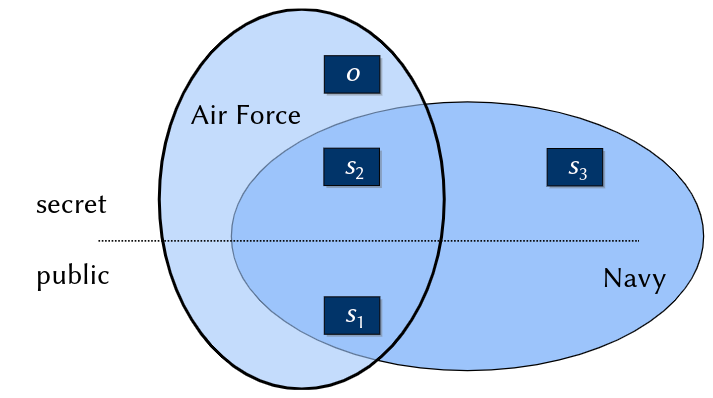
BLP Model Summary
Model Achievements
- Application-oriented modeling
\rightarrowhierarchical information flow (goal: preserve confidentiality) - Scalability
\rightarrowattributes: trust levels - Modeling dynamic behavior
\rightarrowautomaton with STS - Correctness guarantees
- Of model specification: analysis of
- consistency: BLP security, BST
- completeness of IF: IFG path finding
- presence of unintended, transitive IF: IFG path finding
- unwanted redundancy: IF cycles
\rightarrowinformation equivalence classes - safety properties:decidable!
\rightarrowtool-supportpossible!
- Of model implementation: good ol’ ACM
\rightarrowACLs, capabilities
- Of model specification: analysis of
- Implementation
- ACM is a standard AC mechanism in contemporary implementation platforms (cf. prev. slide)
- Contemporary standard OSs need this: do not support mechanisms for
- entity classification
- arbitrary STSs
\rightarrownewer platforms may do: SELinux, SEAndroid, TrustedBSD, Solaris, Trusted Extensions, PostgreSQL
- Is an example of a hybrid model: IF + AC + ABAC
Lessons Learned - What we can learn from BLP for designing and using security models:
- Model composition from known model abstractions
- Denning: IF modeling
- ABAC: IF classes and compartments as attributes
- MSL: modeling trust as a linear hierarchy
- HRU: modeling dynamic behavior
- ACM: implementing application-oriented policy semantics
- Consistency is an important property of composed models
- BLP is further extensible and refinable
\rightarrowstarting point for later models, e. g. Biba
The Biba Model
- BLP
\rightarrowpreserves confidentiality - Biba
\rightarrowpreserves integrity
Applications Example: On-board Airplane Passenger Information Systems
- Goal: Provide in-flight information in cabin network
- Flight instruments data
- Outboard camera video streams
- communication pilot - tower
- Integrity: no information flow from cabin to flight deck!
- As employed in Boeing 787: common network for cabin and flight deck + software firewall + Biba implementation
Windows Vista UAC
- An application of the Biba model for OS access control:
- Integrity: Protect system files from malicious user (software) tampering
- Class hierarchy:
- system: OS level objects
- high: services
- medium: user level objects
- low: untrusted processes e. g. web browser, setup application, ...
- Consequence: every file, process, ... created by the web browser is classified low
\rightarrowcannot violate integrity of system- and user-objects - Manual user involvement (
\rightarrowDAC portion of the policy):resolving intended exceptions, e. g. to install trusted application software
Non-interference Models
Problem No. 1: Covert Channels
Covert Channel [Lampson, 1973] Channels [...] not intended for information transfer at all, such as the service program’s effect on the system load.
- AC policies (ACM, HRU, TAM, RBAC, ABAC): colluding malware agents, escalation of common privileges
- Process 1: only read permissions on user files
- Process 2: only permission to create an internet socket
- both:communication via covert channel(e. g. swapping behavior)
- MLS policies (Denning, BLP, Biba): indirect information flow exploitation (Note: We can never prohibitany possible transitive IF ...)
- Test for existence of a file
- Volume control on smartphones
- Timing channels from server response times
Problem No. 2: Damage Range
How to substantiate a statement like: "Corruption of privileged system software will never have any impact on other system components." \rightarrow Attack perimeter
Idea of NI models:
- Once more: higher level of abstraction
- Policy semantics: which domains should be isolated based on their mutual impact
Consequences:
- Easier policy modeling
- More difficult policy implementation ...(
\rightarrowhigher degree of abstraction!)
Example 1: Multi-application Smart Cards
- Different services, different providers, different levels of trust
- Shared resources: Runtime software, OS, hardware (processor, memory, I/O interfaces, ...)
- Needed:Total isolation of services (program code, security-critical information e. g. private keys)
\rightarrowGuarantee of total non-interference between domains
Example 2: Server System
- Different services: web hosting, mail service, file sharing
- Shared resources (see example 1)
- Needed:Precisely defined and restricted cross-domain interactions (e. g. file up-/downloads, socket communication, shared memory read/write, ...)
\rightarrowGuarantee of limited non-interferenc ebetween domains
NI Security Policies
NI-Policies Specify
- Security domains
- Cross-domain (inter)actions
\rightarrowinterference From convert channels to domain interference:
Non-Interference
Two domains do not interfere with each other iff no action in one domain can be observed by the other.
\rightarrow NI Model Abstractions:
- Set of domains D
- A non-interference relation
≈_{NI}\subseteq D\times D, such thatd_1 ≈_{NI} d_2\Leftrightarrow d_1does not interfere withd_2 - Subjects executeactions
a\in A - Effects of actions on domains defined by a mapping
dom:A\rightarrow 2^D
NI Security Model An NI model is a det. automaton
\langleQ,\sigma,\delta,\lambda,q_0,D,A,dom,≈_{NI},Out\ranglewhere
- Q is the set of (abstract) states,
\sigma=Ais the input alphabet where A is the set of (abstract) actions,\delta:Q\times\sigma\rightarrow Qis the state transition function,\lambda:Q\times\sigma\rightarrow Outis the output function,q_0\in Qis the initial state,Dis a set of domains,dom:A\rightarrow 2^Dis adomain function that completely defines the set of domains affected by an action,≈_{NI}\subseteq D\times Dis a non-interference relation,Outis a set of (abstract) outputs.
NI Security Model is also called Goguen/Meseguer-Model [Goguen and Meseguer, 1982].
BLP written as an NI Model
- BLP Rules:
- write in class public may affect public and confidential
- write in class confidential may only affect confidential
- NI Model:
D=\{d_{pub},d_{conf}\}- write in
d_{conf}does not affectd_{pub}, sod_{conf} ≈_{NI} d_{pub} A=\{writeInPub, writeInConf\}dom(writeInPub)=\{d_{pub},d_{conf}\}dom(writeInConf)=\{d_{conf}\}
NI Model Analysis
Goal
- AC models: privilege escalation (
\rightarrowHRU safety) - BLP models:model consistency (
\rightarrowBLP security) - NI models:Non-interference between domains
Non-Interference Intuitively:
Is there a sequence of actions a^*\in A^* that violates ≈_{NI}? \rightarrow A model is called $NI$-secure iff there is no sequence of actions that results in an illegal domain interference. Now what does this meansprecisely...?
Before we define what NI-secure is, assume we could remove all actions from an action sequence that have no effect on a given set of domains:
Purge Function
Let
aa^*\in A^*be a sequence of actions consisting of a single actiona\in A\cup\{\epsilon\}followed by a sequencea^*\in A^*, where\epsilondenotes an empty sequence. LetD′\in 2^Dbe any set of domains. Then, purge:A^*\times 2^D \rightarrow A^*computes a subsequence ofaa^*by removing such actions without an observable effect on any element of $D′:
purge(aa^*,D′)=\begin{cases} a\circ purge(a^*,D′), \quad\exists d_a\in dom(a),d′\in D′:d_a≈_I d′ \\ purge(a^*,D′), \quad\text{ otherwise }\end{cases}- $purge(\epsilon,D′)=\epsilon$ where
≈_Iis the complement of≈_{NI}:d_1 ≈_I d_2\Leftrightarrow \lnot(d_1 ≈_{NI} d_2).
NI Security
For a state
q\in Qof an NI model\langleQ,\sigma,\delta,\lambda,q_0,D,A,dom,≈_{NI},Out\rangle, the predicate ni-secure(q) holds iff\forall a\in A,\forall a^*\in A^*:\lambda (\delta^*(q,a^*),a)=\lambda(\delta^*(q,purge(a^*,dom(a))),a)
Interpretation
- Running an NI model on
\langleq,a^*\rangleyieldsq′=\delta^*(q,a^*). - Running the model on the purged input sequence so that it contains only actions that, according to
≈_{NI}, actually have impact ondom(a)yieldsq′_{clean}=\delta^*(q,purge(a^*,dom(a))) - If
\forall a\in A:\lambda(q′,a)=\lambda(q′_{clean},a), than the model is called NI-secure w.r.t. q(ni-secure(q)).
Comparison to HRU and IF Models
- HRU Models
- Policies describe rules that control subjects accessing objects
- Analysis goal: right proliferation
- Covert channels analysis: only based on model implementation
- IF Models
- Policies describe rules about legal information flows
- Analysis goals: indirect IFs, redundancy, inner consistency
- Covert channel analysis: same as HRU
- NI Models
- Rules about mutual interference between domains
- Analysis goal: consistency of
≈_{NI}anddom - Implementation needs rigorous domain isolation (more rigorous than MLS, e.g. object encryption is not sufficient!)
\rightarrowexpensive - State of the Art w.r.t. isolation completeness: VMs > OS domains (SELinux) > Containers
Hybrid Models
Real-world Scenarios e.g. workflow modeling: IBAC plus RBAC plus IF plus time... \rightarrow Hybrid models by composing pure models
Chinese-Wall Policies
Security policy family for consulting companies
- Clients of any such company
- Companies, including their business data
- Often: mutual competitors
- Employees of consulting companies
- Are assigned to clients they consult (decided by management)
- Work for many clients
\rightarrowgather insider information
\rightarrowPolicy goal: No flow of (insider) information between competing clients
Why look at specifically these policies?
- Modeling
- Composition of
- Discretionary IBAC components
- Mandatory ABAC components
- Driven by real-world demands: iterative refinements of a model over time
- Brewer-Nash model [Brewer and Nash, 1989]
- Information flow model [Sandhu, 1992a]
- Attribute-based model [Sharifi and Tripunitara, 2013]
- Composition of
- Application areas: consulting, cloud computing
The Brewer-Nash Model
Specialized model: Explicitly tailored towards Chinese Wall (CW) policies
Model Abstractions
- Consultants represented by subjects
- Client companies represented by objects, which comprise a company’s business data
- Modeling of competition by conflict classes: two different clients are competitors
\Leftrightarrowtheir objects belong to the same class - No information flow between competing objects
\rightarrowa "wall" separating any two objects from the same conflict class - Additional ACM for refined management settings of access permissions
Example
- Consultancy clients
- Banks: HSBC, Deutsche Bank, Citigroup
- Oil companies: Shell, Exxon Mobil/Esso
- Conflicts: business-crucial information flows between banks and oil companies

Representation of Conflict Classes
- Client company data: object set O
- Competition: conflict relation
C\subseteq O\times O:\langleo,o′\rangle\in C\Leftrightarrow oando′belong to competing companies (non-reflexive, symmetric, generally not transitive) - In terms of ABAC:object attribute
att_O:O\rightarrow 2^O, such thatatt_O(o)=\{o′\in O|\langleo,o′\rangle\in C\}.
Representation of a Consultant’s History
- Consultants: subject set S
- History relation
H\subseteq S\times O:\langles,o\rangle\in H\Leftrightarrow shas previously consultedo - In terms of ABAC: subject attribute
att_S:S\rightarrow 2^O, such thatatt_S(s)=\{o\in O|\langles,o\rangle\in H\}.
Brewer-Nash Security Model
The Brewer-Nash model of the CW policy is a det.
automaton\langleS,O,Q,\sigma,\delta,q_0,R\ranglewhere
SandOare sets of subjects (consultants) and (company data) objects,Q=M\times 2^C\times 2^His the state space where
M=\{m|m:S\times O\rightarrow 2^R\}is the set ofpossible ACMs,C\subseteq O\times Ois the conflict relation:\langleo,o′\rangle\in C\Leftrightarrow oando′are competitors,H\subseteq S\times Ois the history relation:\langles,o\rangle\in H\Leftrightarrow shas previously consultedo,\sigma=OP \times Xis the input alphabet where
OP=\{read,write\}is a set of operations,X=S \times Ois the set of arguments of these operations,\delta:Q \times\sigma\rightarrow Qis the state transition function,q_0\in Qis the initial state,R=\{read,write\}is the set of access rights.
- Conflict relation:
C=\{\langleHSBC,DB\rangle,\langleHSBC,Citi\rangle,\langleDB,Citi\rangle,\langleShell,Esso\rangle\} - History relation:
H=\{\langleAnn,DB\rangle,\langleBob,Citi\rangle,\langleBob,Esso\rangle\}
Brewer-Nash STS
- Read (here: similar to HRU notation)
$command read(s,o)::=if read \in m(s,o) \wedge\forall \langleo′,o\rangle\in C:\langles,o′\rangle\not\in H$
$then$
$H:=H\cup{\langles,o\rangle}$
fi - Write
$command write(s,o)::=if write \in m(s,o) \wedge\forall o′\in O:o'\not=o \Rightarrow \langles,o′\rangle\not\in H$
$then$
$H:=H\cup{\langles,o\rangle}$
fi
Not shown: Discretionary policy portion \rightarrow modifications in m to enable fine-grained rights management.
Restrictiveness
- Write Command: s is allowed to write
o\Leftrightarrow write\in m(s,o)\wedge\forall o′\in O:o′\not=o\Rightarrow\langles,o′\rangle\not\in H - Why so restrictive?
\rightarrowNo transitive information flow!\rightarrows must never have previously consulted any other client!\Rightarrowany consultant is stuck with her client on first read access\Rightarrownot (yet) a professional model!
Brewer-Nash Model
Instantiation of a Model
- Initial State
q_0m_0: consultant assignments to clients, issued by managementC_0: according to real-life competitionH_0 =\varnothing
Secure State $\forall o,o′ \in O,s\in S:\langles,o\rangle\in H_q\wedge\langles,o′\rangle\in H_q\Rightarrow\langleo,o′\rangle\not\in C_q$ Corollary:
\forall o,o′\in O,s\in S:\langleo,o′\rangle\in C_q\wedge\langles,o\rangle\in H_q\Rightarrow \langles,o′\rangle\not\in H_q
Secure Brewer-Nash Model Similar to "secure BLP model".
In the exercises: STS, transformation into pure HRU calculus, dynamic subject and object sets.
Summary Brewer-Nash
What’s remarkable with this model?
- Composes DAC and MAC components
- Simple model paradigms
- Sets (subjects, objects)
- ACM (DAC)
- Relations (company conflicts, consultants history)
- Simple "read" and "write" rule
\rightarroweasy to implement
- Analysis goals
- MAC: Model security
- DAC: safety properties
- Drawback: Restrictive write-rule
Professionalization
- Remember the difference: trusting humans (consultants) vs. trusting software agents (subjects)
- Consultants are assumed to be trusted
- Systems (processes, sessions, etc.) may fail, e. g. due to a malware attack
\rightarrowWrite-rule applied not to humans, but to (shorter-lived) software agents\rightarrowmitigating malware effectiveness\rightarrowSubject set S models consultant’s subjects (e. g. processes) in a group model:- All processes of one consultant form a group
- Group members
- have the same rights in m
- have individual histories
- are strictly isolated w.r.t. IF
- Solution approach: as we already know
\rightarrowmodel refinement!
The Least-Restrictive-CW Model
Restrictiveness of Brewer-Nash Model:
- If
\langleo_i,o_k\rangle\in C: no transitive information flowo_i \rightarrow o_j\rightarrow o_k, i.e. consultant(s) ofo_imust never write to anyo_j\not=o_i - This is actually more restrictive than necessary:
o_j\rightarrow o_kand afterwardso_i\rightarrow o_jwould be fine! (no information can actually flow fromo_itoo_k) - In other words: Criticality of an IF depends on existence of earlier flows.
Idea LR-CW[Sharifi and Tripunitara, 2013]: Include time as a model abstraction!
Approach:
\forall s\in S,o\in O: remember, which information has flown to an entity\rightarrowsubject-/object-specific history, $≈$attributes ("lables")
LR-CW Model
The Least-Restrictive model of the CW policy is a deterministic
automaton \langleS,O,F,\zeta,Q,\sigma,\delta,q_0\ranglewhere
- S and O are sets of subjects (consultants) and data objects,
- F is the set of client companies,
\zeta:O\rightarrow F("zeta") is a function mapping each object to its company,Q=2^C \times 2^His the state space where
C\subseteq F\times Fis the conflict relation:\langlef,f′\rangle\in C\Leftrightarrow fandf′are competitors,H=\{Z_e\subseteq F|e\in S\cup O\}is the history set:f\in Z_e\Leftrightarrow econtains information aboutf(Z_eis the "history label" ofe),\sigma=OP\times Xis the input alphabet where
OP=\{read,write\}is the set of operations,X=S\times Ois the set of arguments of these operations,\delta:Q\times\sigma\rightarrow Qis the state transition function,q_0\in Qis the initial state
- At the time depicted (before the first write):
- Client companies:
F=\{HSBC,DB,Citi,Shell,Esso\} - History set:
H=\{Z_{Ann},Z_{Bob},Z_{o1} ,...,Z_{o|O|}\}with history labelsZ_{Ann}=\{DB\}Z_{Bob}=\{Citi,Esso\},Z_{oi}=\{\zeta(o_i)}, 1\leq i\leq |O|.
- Client companies:
Inside the STS
- a reading operation
- requires that no conflicting information is accumulated in the subject potentially increases the amount of information in the subject
- command read(s,o) ::= if
\forall f,f′\in Z_s \cup Z_o:\langlef,f′\rangle\not\in CthenZ_s:=Z_s\cup Z_ofi
- a writing operation
- requires that no conflicting information is accumulated in the object potentially increases the amount of information in the object
- command write(s,o) ::= if
\forall f,f′\in Z_s\cup Z_o:\langlef,f′\rangle\not\in CthenZ_o:=Z_o\cup Z_sfi
Model Achievements
- Applicability: more writes allowed in comparison to Brewer-Nash (note that this still complies with the general CW policy)
- Paid for with
- Need to store individual attributes of all entities (their history labels
Z_e) - Dependency of write permissions on earlier actions of other subjects
- Need to store individual attributes of all entities (their history labels
- More extensions:
- Operations to modify conflict relation
- Operations to create/destroy entities
An MLS Model for Chinese-Wall Policies
Problems
- Modeling of conflict relation
- Modeling of consultants history
Conflict relation is
- non-reflexive: no company is a competitor of itself
- symmetric: competition is always mutual
- not necessarily transitive: any company might belong to more than one conflict class
\Rightarrowif a competes with b and b competes with c, then a and c might still be in different conflict classes (= no competitors)\rightarrowCannot be modeled by a lattice!
Reminder:In a lattice$\langleC,\leq\rangle$,$\leq$ is a partial order:
- reflexive
(\forall a\in C:a \leq a) - anti-symmetric
(\forall a,b \in C:a \leq b \wedge b \leq a\Rightarrow a=b) - transitive
(a,b,c \in C:a \leq b \wedge b \leq c \Rightarrow a \leq c)
MLS-CW Example:
- Two conflict classes:
- Resulting valid information flows:
- Problem: How to express this more directly, by allowed information flows rather than (forbidden) conflicts?
Idea: Labeling of entities
- Class of an entity (subject or object) reflects information it carries
- Consultant reclassified whenever a company data object is read
\rightarrowClasses and labels:- Class set of a lattice
C=\{DB,Citi,Shell,Esso\} - Entity label: vector of information already present in each business branch (formerly known as conflict classin Brewer-Nash!)
- In our example, a vector consists of 2 elements
\in C; resulting in labels such as:[\epsilon,\epsilon](exclusively forinf_C)[DB,\epsilon](for DB-objects or -consultants)[DB,Shell](for subjects or objects containing information from both DB and Shell)[Esso,Shell](illegal label!)- ...
Summary CW
Why is the "Chinese Wall" policy interesting?
- One policy, multiple models:
- The Brewer-Nash model demonstrates hybrid DAC-/MAC-/IFC-approach
- The Least-Restrictive CW model demonstrates a more practical professionalization
- The MLS-CW model demonstrates applicability of lattice-based IF modeling
\rightarrowsemantically cleaner approach
- Applications: Far beyond traditional consulting scenarios...$\rightarrow$ current problems in cloud computing!
Summary
Security Models
- Formalize informal security policies for the sake of
- objectification by unambiguous calculi
- explanation and (possibly) proof of security properties (e.g. HRU safety, BLP security, NI security) by formal analysis techniques
- foundation for correct implementations
- Are composed of simple building blocks
- E.g. ACMs, sets, relations, functions, lattices, state machines
- ... that are combined and interrelated to form more complex models
\rightarrow(D)RBAC, (D)ABAC, BLP, Brewer-Nash, LR-CW, MLS-CW
Remember: Goals of Security Models
- Unambiguous policy formalization to
- reason about policy correctness
- correctly implement a policy
Practical Security Engineering
Problem: Off-the-shelf models not always a perfect match for real-world scenarios
Goal: Design of new, application-specific models
- Identify common components found in many models
\rightarrowgeneric model core - Core specialization
- Core extension
- Glue between model components
Model Engineering
Model Family
In Formal Words ...
- HRU:
\langle Q, \sum , \delta, q_0 , R \rangle DRBAC_0:\langle Q, \sum , \delta, q_0 , R, P, PA \rangle- DABAC:
\langle A , Q ,\sum , \delta, q_0 \rangle - TAM:
\langle Q , \sum , \delta, q_0 , T, R \rangle - BLP:
\langle S, O, L, Q , \sum , \delta, q_0 , R \rangle - NI:
\langle Q , \sum , \delta, \lambda ,q_0 , D, A, dom, =_{NI} , Out \rangle
Core Model (Common Model Core)
- HRU:
\langle Q, \sum , \delta, q_0 , \not R \rangle DRBAC_0:\langle Q, \sum , \delta, q_0 , \not R, \not P, \not PA \rangle- DABAC:
\langle \not A , Q ,\sum , \delta, q_0 \rangle - TAM:
\langle Q , \sum , \delta, q_0 , \not T, \not R \rangle - BLP:
\langle \not S, \not O, \not L, Q , \sum , \delta, q_0 , \not R \rangle - NI:
\langle Q , \sum , \delta, \not \lambda ,q_0 , \not D, \not A, \not dom, \not =_{NI} , \not Out \rangle \rightarrow \langle Q ,\sum , \delta, q_0 \rangle
Core Specialization
- HRU:
\langle Q, \sum , \delta, q_0 , R \rangle \Rightarrow Q = 2^S \times 2^O \times M DRBAC_0:\langle Q, \sum , \delta, q_0 , R, P, PA \rangle \Rightarrow Q = 2^U\times 2^{UA}\times 2^S \times USER \times ROLES- DABAC:
\langle A , Q ,\sum , \delta, q_0 \rangle \Rightarrow Q = 2^S\times 2^O \times M\times ATT - TAM:
\langle Q , \sum , \delta, q_0 , T, R \rangle \Rightarrow Q = 2^S\times 2^O\times TYPE \times M - BLP:
\langle S, O, L, Q , \sum , \delta, q_0 , R \rangle \Rightarrow Q = M \times CL - NI:
\langle Q , \sum , \delta, \lambda ,q_0 , D, A, dom, =_{NI} , Out \rangle
Core Extensions
- HRU:
\langle Q, \sum , \delta, q_0 , R \rangle \Rightarrow R DRBAC_0:\langle Q, \sum , \delta, q_0 , R, P, PA \rangle \Rightarrow R,P,PA- DABAC:
\langle A , Q ,\sum , \delta, q_0 \rangle \Rightarrow A - TAM:
\langle Q , \sum , \delta, q_0 , T, R \rangle \Rightarrow T,R - BLP:
\langle S, O, L, Q , \sum , \delta, q_0 , R \rangle \Rightarrow S,O,L,R - NI:
\langle Q , \sum , \delta, \lambda ,q_0 , D, A, dom, =_{NI} , Out \rangle \Rightarrow \lambda,D,A,dom,=_{NI},Out \rightarrow R, P, PA, A , T , S , O , L , D , dom , =_{NI} , ...
Glue
- E.g. TAM: State transition scheme (types)
- E.g. DABAC: State transition scheme (matrix and predicates)
- E.g. Brewer/Nash Chinese Wall model: "$\wedge$" (simple, because
H+C\not= m) - E.g. BLP
- BLP read rule
- BLP write rule
- BST
- (much more complex, because rules restrict m by L and cl )
\rightarrow Model Engineering Principles
- Core model
- Core specialization, e.g.
Q = 2^S\times 2^O \times M(HRU)Q = M\times CL(BLP)- Core extension, e.g.
- e.g.
L(BLP) T(TAM)D, dom ,=_{NI}(NI)
- e.g.
- Component glue, e.g.
- Chinese Wall: DAC "$\wedge$" MAC in AS
- BLP: complex relation between ACM and lattice
\rightarrowBLP security, BLP BST
You should have mastered now: A basic tool set for model-based security policy engineering
- A stock of basic security model abstractions
- ACFs and ACMs
- Model states and transitions defined by an STS
- Attributes (roles, confidentiality classes, information contents, location, ...)
- Information flows
- A stock of formal model building blocks
- Sets, functions, relations
- Deterministic automatons
- Graphs and lattices
- A stock of standard, off-the-shelf security models
- Methods and techniques
- for model-based proof of policy properties properties
- for combining basic model building blocks into new, application-oriented security models
Model Specification
Policy Implementation
- We want: A system controlled by a security policy
- We have: A (satisfying) formal model of this policy
To Do
- How to convert a formal model into an executable policy?
\rightarrowPolicy specification languages
- How to enforce an executable policy in a system?
\rightarrowsecurity mechanisms and architectures (Chapters 5 and 6)
Role of Specification Languages: Same as in software engineering
- To bridge the gap between
- Abstractions of security models (sets, relations, ...)
- Abstractions of implementation platforms (security mechanisms such as ACLs, krypto-algorithms, Security Server ...)
- Foundation for
- Code verification
- Or even more convenient: Automated code generation
Approach
- Abstraction level:
- Step stone between model and security mechanisms
\rightarrowMore concrete than models\rightarrowMore abstract than programming languages ("what" instead of "how")
- Expressive power:
- Domain-specific; for representing security models only
\rightarrowNecessary: adequate language paradigms\rightarrowSufficient: not more than necessary (no dead weight)
Domains
- Model domain
- e.g. AC models (TAM, RBAC, ABAC)
- e.g. IF models (MLS)
- e.g. NI models
- Implementation domain
- OS
- Middleware
- Applications
DYNAMO: A Dynamic-Model-Specification Language
formerly known as "CorPS: Core-based Policy Specification Language"
Language Domain: RBACmodels
- RBAC 0 - 3
- DRBAC 0 - 3
- DABAC (with some restrictions)
Language Paradigms: Abstractions of (D)RBAC models
- Users, roles, permissions, sessions
- State transition scheme (STS)
Language Features: Re-usability and inheritance
- Base Classes: Model family (e.g.
DRBAC_0 , DRBAC_1 , ...)- Model components
- Conditions
- Primitives
- Policy Classes : Inherit definitions from Base Classes
- State space
- State transition scheme
- Extensions
Tools
- DYNAMO compiler("corps2cpp"): Translates specification into
- XML
\rightarrowanalysis by WORSE algorithms - C++ classes
\rightarrowintegration into TCB (OS/Middleware/Application)
- XML
Example: Specification of a DRBAC_0 Model
$DRBAC_0 = RBAC_0 + Automaton \rightarrow$
$RBAC_0 = \langle U , R , P , S , UA , PA , user , roles \rangle$
$DRBAC_0 = \langle Q , \sum, \delta, q_0 , R , P , PA \rangle$
Q = 2^U \times 2^S \times 2^{UA}\times ...
Policy Specification in EBNF
policy =
"begin" "policy" string ":" string ":"
"state-space" ":" "{" state_space "}" ";" // Q
"input-vector" ":" "{" input_vector "}" ";" // SUM
"begin" "authorisation-scheme" ":" // delta
authorisation_scheme
"end" "authorisation-scheme" ";" // q_0
"begin" "initial-state" ":"
inital_state
"end" "initial-state" ";"
"begin" "extension-vector" ":" // E
extension_vector
"end" "extension-vector" ";"
"end" "policy" ";"
OpenMRS: A DRBAC_0 Policy Specification Example
begin policy openRMS: DRBAC_0 :
state-space : {U, O, S, UA, PA, user, roles};
input-vector : {OP, U, O, S , R};
begin authorisation-scheme :
read_medical_record(U u, O o, OP op):
condition : f_rbac(u, o, ’read_medical_record’);
write_medical_record(U u, O o, OP op):
condition : f_rbac(u, o, ’write_medical_record’);
activate_role_in_session(S s, R r):
condition : can_activate_role(s, r);
begin body :
activate_role(s, r);
end body ;
end authorisation-scheme ;
begin initial-state :
U = {’Cox’, ’Reid’};
O = {‘epr1’, ‘epr2’, ...}; S = {‘s1’, ‘s2’};
UA = {[’Cox’, ’doctor’], [’Reid’, ’doctor’]};
user = {(’s1’ : ‘Cox’), (‘s2’ : ’Reid’)}; ...
end initial-state;
begin extension-vector :
OP = {’read_medical_record’, ’write_medical_record’, ’activate_role_in_session’};
R = {’doctor’, ’nurse’, ’researcher’};
end extension-vector ;
end policy ;
What Can We Do Now?
DYNAMO specification \rightarrow corps2cpp \rightarrow C++-Classes \rightarrow Security Server
DYNAMO Summary
- Specification language for (D)RBAC security models
- Base classes:
DRBAC_0 ... DRBAC_3 - Conditions
f_rbaccan_activate_rolecan_assign_user_to_role
- Primitives
create_user , destroy_usercreate_object , destroy_objectcreate_role , destroy_rolecreate_session , destroy_sessionactivate_role- ...
- Tools
- Compiler: XML, C++ generation
SELinux Policy Language
Language Domain
- I/R/A-BAC models
- IF models
- NI models
Implementation Domain
- Operating systems accesscontrol
Language paradigms
- OS Abstractions: Users, processes, files, directories, sockets, pipes, ...
- I/R/ABAC, TAM, MLS, NI model paradigms: Users, rights, roles, types, attributes, security domains, ...
Tools
- Specification: Policy creating and validation
- Policy compiler: Translates policy specifications
- Security server: Policy runtime environment (RTE) in OS kernel’s security architecture
- LSM hooks: Support policy enforcement in OS kernel’s security architecture
Technology
- Policy compiler
\rightarrowtranslates specifications into loadable binaries (ACM) - Security architecture
\rightarrowimplementation of Flask architecture
Fundamental Flask Security Architecture as found in SELinux:
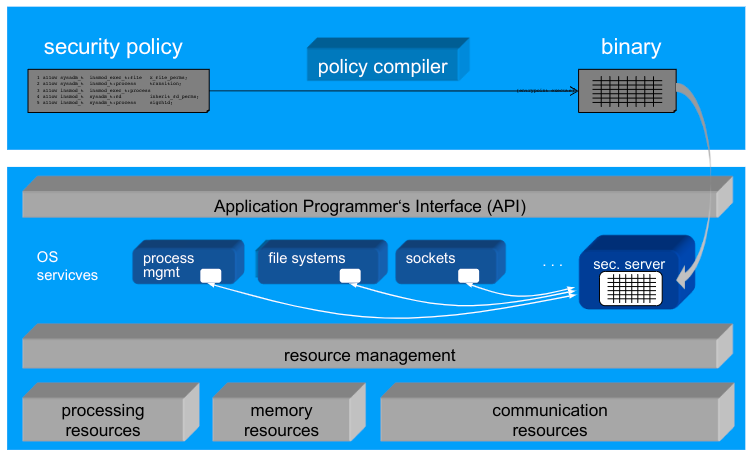
Basic Language Concepts
- Definition of types (a.k.a. "domains")
- Labeling of subjects (e.g. processes) with "domains"
\rightarrow passwd_t: all processes managing passwords - Labeling of objects (e.g. files, sockets) with "types"
\rightarrow shadow_t: all files containing password info - AC: defined by permissions between pairs of types ("type enforcement")
\rightarrow allow\ passwd_t\ shadow_t:file \{read\ write\} - Dynamic interactions: transitions between domains
\rightarrow allow\ user_t\ passwd_t:process {\transition\}
Policy Rules
- Grant permissions: allow rules "allow" ":"
- Typical domains:
user_t,bin_t,passwd_t,insmod_t,tomCat_t, ... - Classes: OS abstractions (process, file, socket, ...)
- Permissions: read, write, execute, getattr, signal, transition, ... (≈ 1000)
The Model Behind: 3 Mappings
- Classification
cl : S\cup O \rightarrowC where C=\{ process , file , dir , pipe, socket , ...\} - Types
type: S\cup O \rightarrowT where T=\{ user_t , passwd_t , bin_t , ...\} - Access Control Function ( Type Enforcement , TE )
te : T\times T \times C \rightarrow 2^R \rightarrow ACM : T\times( T \times C ) \rightarrow 2^R
Idea only: SELinux RBAC
Users and Roles
- User ID assigned on login
- RBAC rules confine type associations "Only users in role
doctor_rmay transit to domain $edit-epr_t$" \rightarrowfine-grained domain transitions\rightarrowAttributes in SELinux-style RBAC:- User ID (
\not =Linux UID) - Role ID
- User ID (
What we can do now: Specification \rightarrow Tool \rightarrow Binary \rightarrow Security Server
Summary SELinux Policy Specification Language
Application Domain
- OS-level security policies
Model Domain
- ∗BAC, MLS, NI
Model abstractions
- TE: MAC rules based on types
- ABAC:MAC rules based on attributes
- RBAC: MAC rules based on roles
- Additionally: BLP-style MLS
Other Policy Specification Languages
- XACML ( eXtensibleAccess Control Markup Language )
- NGAC ( Next Generation Access Control Language )
- SEAL (Label-based AC policies)
- Ponder (Event-based condition/action rules)
- GrapPS (Graphical Policy Specification Language)
- GemRBAC (Role-based AC models)
- PTaCL (Policy re-use by composition)
Summary
Security Models in Practice
- Model abstractions
- Subjects, objects, rights
- ACMs and state transition schemes
- Types, roles, attributes
- Information flow, non-interference domains
- Model languages
- Sets, functions, relations, lattices/IFGs
- Deterministic automata
- Model engineering
- Generic model core
- Core specialization and extension
Next Step: Policy Implementation & Integration
Models expect
- Confidentiality, integrity, and authenticity of
- Model entities
- Entity communication
- Tamperproofness of policy implementation
- Total access mediation for policy
Security Mechanisms
Security Models Implicitly Assume
- Integrity of model implementation
- Model state
- Authorization scheme
- Integrity of model operations call
- Parameters of authorization scheme ops
- Completeness and total mediation of their invocation
- AC, IF: no covert chanels
- NI: Rigorous domain isolation
- ...
\rightarrowjob of the "Trusted Computing Base" (TCB) of an IT system
Definitions
Trusted Computing Base (TCB) The set of functions of an IT system that are necessary and sufficient for implementing its security properties
\rightarrowIsolation, Policy Enforcement, Authentication ...
Security Architecture The part of a system’s architecture that implement its TCB
\rightarrowSecurity policies, Security Server (PDP) and PEPs, authentication components, ...
Security Mechanisms Algorithms and data structures for implementing functions of a TCB
\rightarrowIsolation mechanisms, communication mechanisms, authentication mechanisms, ...
\rightarrow TCB - runtime environment for security policies
Implementation of Security Policies
- (some) TCB functions are integrated in today's commodity OSes
- Isolation
- Subject/object authentication
- Complex models (HRU, RBAC, ABAC, MLS) additionally require implementation of
- Authorization schemes
- Roles, lattices, attributes
\rightarrowstronger concepts and mechanisms- OS level: Security Server (SELinux, OpenSolaris, TrustedBSD)
- Middleware level: Policy Objects (CORBA, Java, DBMSs, Web Services)
- Application level: user level reference monitors (Flume), user level policy servers (SELinux)
Security mechanisms: A Visit in the Zoo: ...
- In OSes
- Authenticity
- Of subjects: login
- Of objects: object management, e.g. file systems, communication
- Confidentialityand integrity
- Access control lists
- In middleware layer (DBMSs, distributed systems)
- Authentication
- Authentication server (e.g. Kerberos AS, see below)
- Authentication protocols (e.g. LDAP )
- Authorization
- Ticket server (e.g. Kerberos TGS, see below)
- In application systems
- Authentication
- In email servers, Web browsers
- In libraries
- Confidentiality, integrity, authenticity
- Cryptographic algorithms
- Certificate management for PKIs
- In utilities
- Confidentiality, integrity, authenticity
- Document integrity
dunraven> md5 kap3.pptx MD5 (kap3.pptx) = 17467e340438ae4dc0e2d9ad9afe dunraven> - Isolation
- Sandboxing in OS X
dunraven> sandbox-exec -f policy fishy-program sandbox-exec: fishy-program: operation not permitted dunraven> \rightarrowsecurity mechanisms are everywhere
Authorization
Lampson, HRU, RBAC, ABAC, BLP, CW \rightarrow ACMs
Security Mechanisms for Implementation?
Access Control Lists und Capability Lists
Lampson’s ACM
We have
- Sets
S,OandR - ACM
m: S\times O\rightarrow 2^R
| m | o_1 | o_2 | o_3 | ... | o_m |
|---|---|---|---|---|---|
| s_1 | |||||
| s_2 | {r,w} | ||||
| s_3 | {r,w} | ||||
| ... | {w} | ||||
| s_n |
Properties of an ACM
- Large (e.g. "normal" file server:
|m| >> 1TByte) - Sparsely populated
- Subject and object identifications in OSes generally are
- Not numerical
- Not consecutive
- Rowsand columns are created and destroyed dynamically
\rightarrownaive ACM implementation such as rightset m[SubjectIdType][ObjectIdType] in a file system‘s metadata (e.g. similar to inode table) out of question
Idea: Distributed ACM Implementation
- Split matrix into vectors; options:
- Column vectors
- Row vectors
- Attach vectors to subjects resp. objects
Alternative Approaches
- Column vectors
- Describe every existing right wrt. an object
- Each vector associated to its object, part of object‘s metadata
\rightarrowAccess control lists (ACLs)
- Row vectors
- Describe every existing right wrt. a subject
- Associated to its subject, part of subject‘s metadata
\rightarrowcapability lists
ACLs
- Associated to exactly one object
- Describes every existing right wrt. object by a set of tuples (subject identification, right set)
- Implemented e.g. as list, table, bitmap
- Part of object‘s metadata (generally located in inode)
Capability Lists
- Associated to exactly one subject
- Describes every existing right wrt. subject by a set of tuples (object identification, right set)
- Implemented e.g. as list, table, bitmap
- Part of object‘s metadata (generally located in process descriptor)
Figuratively
- Enrollment: capability list
- Authorization: high school diploma (personal capability carrying authenticity proof)
- Authentication: id card
- Vienna Opera Ball: ACL
- Authorization: list of invited people
- Authentication: (id card)
Operations on ACLs
Create and Delete an ACL
- Together with creation and deletion of an object
- Options for initialization
- Initialrights are create operation parameters
\rightarrowdiscretionary access control- Initialrights issued by third party
\rightarrowmandatory access control
Example: creat/open of Unix API
- S_IRWXU (= 00700oct) user (=owner) has read-, write- and execute permissions
- S_IRUSR (= 00400oct) user has read permission
- S_IRWXG (= 00070oct) group has read-, write- und execute permissions
Modify an ACL
- Add or remove tuples (subject identification, right set)
- General Options
- Owner has right to modify ACL
\rightarrowimplements discretionary access control
- Third party has right to modify ACL
\rightarrowimplements mandatory access control
- Right to modify ACL is part of ACL
\rightarrowuniversal
- Owner has right to modify ACL
Check Rights
- Whenever an object is accessed
- Search granting tuple in ACL
Negative Rights
- Dominate positive rights
- Are represented - same as positive rights - by tuples (subject identification, negative rights set)
- Rights of a subject
s: difference of accumulated positive rights and accumulated negative rights
Example: ACLs in Unix
Metadata (management data) of a file system include
Model of a Unix ACL...
| read | write | exec | |
|---|---|---|---|
| owner | y | y | n |
| group | y | n | n |
| others | n | n | n |
- 3 elements per list list
- 3 elements per right set
\rightarrow9 bits- ... and its implementation ... coded in 16-bit-word (PDP 11, 1972 !!)
...110 100 000
Operations on Capability Lists
Create and Delete a Capability List
- Together with creation and deletion of a subject
- Options for initialization
- Initial rights same as parent
- $\rightarrow$inherited
- Constraints by
- Parent
\rightarrowdiscretionary access control
- Capability
\rightarrowmandatory access control
- Parent
Modification of Capability Lists
- Add or remove tuples (object identification, right set)
Passing on Capabilities, options:
- Emission and call-back by capability owner
\rightarrowdiscretionary access control
- Emission and call-back by third party
\rightarrowmandatory access control
- Emission and call-back controlled by capability itself
\rightarrowuniversal
Equivalence of ACLs and Capability Lists
- Strictly formally speaking: isomorphic
\delta s:- Administration
- Distributed systems
\delta s in Administration
ACLs - Located near objects
\rightarrowfinding all rights of a subject expensive
Example BLP: re-classification of a subject
\rightarrowupdate every ACL with rights of this subject
Consequence - Group models; e.g.
- BLP: subjects with same classification
- Unix: subjects belonging to project staff
Capability Lists - Located near objects
\rightarrowfinding all rights of an object expensive
Example BLP: re-classification of an object
\rightarrowupdate every Capability with rights for this object
Consequence - Role models (role: set of rights); e.g.
- BLP: set of rights wrt. objects with same classification
\delta s in Distributed Systems
Non-distributed Systems: Management and protection of
- subject ids and ACLs in trustworthy OS kernel
- capability lists in trustworthy OS kernel
- Example: Traditional monolithic OS architecture
- or in a microkernel architecture
\rightarrowin non-distributed systems,- Management
- Authentication
- Management and checking of capabilities
- Checking of rights in trustworthy environment
Distributed Systems
- No encapsulation of subject ids and ACLs in a single trustworthy OS
\rightarrowin distributed systems,- Authentication of subjects on subject’s system
- Transfer of subject id via open communication system
- Checking of subject id by object’s system
- No encapsulation of capability lists in a single trustworthy OS kernel
\rightarrowin distributed systems,- Authentication of subjects and management of capabilities on subject’s system
- Transfer of subject id and capabilities via open communication system
- Checking of capabilities and subject ids on object’s system
Vulnerabilities and Counteractions
- Subject’s system may fake subject ids
- Consequence: Reliable subject authentication required
\rightarrowauthentication architectures (e.g. Kerberos)
\rightarrow in non-distributed systems,
- Authentication
- Management and checking of capabilities in trustworthy environment
Vulnerabilities and Counteractions
-
Non-trustworthy subject systems modify capabilities
\rightarrowcryptographic sealing of capabilities such that- Issuer can be determined
- Modification can be detected
- sealing e.g. by digital signatures (see below)
-
Non-trustworthy subject systems pass capabilities to third parties, or Capabilities are copied by third parties while in transit
\rightarrowpersonalized capabilities
-
Exploit stolen capabilities by ntw. subject system by forging subject id
\rightarrowcryptographically sealed personalized capabilities\rightarrowreliable subject authentication required\rightarrowauthentication architectures
On the Expressive Power of ACLs and Capability Lists
ACLs and capability lists
- Efficient data structures for implementing ACMs
- located in
- OSs, middleware, DBMSe, application systems
- Correctness, tamperproofness, total S/O interaction mediation vital for enforcing access control
\rightarrowimplementation by strong architectural principles, see below- Assume reliable authentication of subjects and objects
\rightarrowsupport by further security mechanisms- Not sufficient for implementing more complex security policies
- Authorization schemes
Interceptors
Problem: Implementing authorization schemes
- Examples
- Open university scenario: "After accessing the solution, assignments can no longer be submitted"
- Unix fork : "A child process inherits all security attributes from its parent"
- ACLs and capability lists are just lists...
Idea: Policy implementation by algorithms instead of lists
Interceptors
- Tamperproof runtime environments for security policies
- In total control of subject/object interactions
- Observation
- Modification
- Prevention
General Architectural Principle: Separation of
- (Replaceable) strategies
- (Strategy-independent) mechanisms
Applied to Interceptors \rightarrow 2 Parts
- Runtime environment for security policies (strategies)
- often called "policy decision point" (PDP)
- Interception points (mechanisms)
- often called "policy enforcement points" (PEP)
Summary Interceptors
- RTE for security policies in policy-controlled systems
- SELinux: "Policy Server"
- CORBA: "Policy Objects"
- Architecture: separation of responsibilities
- Strategic component
- State; e.g.
- HRU models:
Q= 2^S\times 2^O\times M - MLS models:
Q =M\times CL
- HRU models:
- Algorithms
- authorization scheme
- State; e.g.
- Mechanisms component
- Policy enforcement: total policy entities interaction mediation
- Generality: implement - apart from AC policies - a broad scope of policies (all that generally are computable)
- "Only documents signed by X may be classified as ‘public’"
-
\rightarrowrules based on checking digital signatures - "Documents may be sent over public networks only if they are encrypted"
-
\rightarrowinterceptor checks/implements encryption
Summary
ACLs and Capability Lists
- Efficient data structures for implementing ACFs
- Located in
- OSs, middleware, DBMSe, application systems
- Assume reliable authentication of subjects and objects
- Are too weak to implement complex security policies
Interceptors
- For implementing complex security policies
- Located in
- OSs, middleware (SELinux LSM-Framework and Security Server; CORBA Policy Objects)
- Middleware platforms
- As "policy objects" (CORBA, Java)
- As part of a handler chain (Web services middleware, Apache Axis)
Cryptographic Security Mechanisms
Goal: Enforcement of access control policies
IBAC/ABAC/RBAC/MLS Models assume
- Reliable identification of subjects and objects
- Integrity and confidentiality of
- Subjects and objects
- Their communication (especially in distributed environments)
Encryption Techniques and Algorithms
Encryption
- Transformation of a plaintext into a ciphertext
- Decryption possible only if decrypt algorithm is known
Cryptosystem Components
- 2 functions encrypt, decrypt
- 2 keys k1, k2
Notation
text = decrypt_{k2}(encrypt_{k1}(text))or simplytext = \{\{text\}_{k1}\}_{k2}(if encryption function is obvious)
Kerkhoff’s Principle
- Encryption functions (algorithms) are publicly known
\rightarrowmany experts look at it\rightarrowquality advantage assumed
- Keys are secret
\rightarrowencryption security depends on- Properties of algorithms
- Confidentiality of keys
Classification of Encryption Schemes
- Symmetric schemes (secret key): one single key:
k1=k2 - Asymmetric schemes (public key): two different keys:
K1\not=K2
Symmetric Encryption Schemes
Characteristic Feature
- Encryption and decryption with same key
\rightarrowsecurity based on keeping key secret
Example
- Key
k\in\mathbb{N} encrypt_k: shift letters of a plaintext backwards in alphabet by K positionsdecrypt_k: shift letters of a ciphertext forward by K positions- ciphertext "HAL", key
k=1\rightarrowdecrypt_1 ("HAL") = "IBM"
Application Examples
- Confidentiality of Communication (Assumptions)
- Sender and receiver share key k , which has to be established - Before communication - Authentically - Confidentially
- Nobody else must know
k(secretkey)
- Authentication: E.g. client to server ( challenge-response - authentication by shared secret key)
- Each client shares an individual andsecret key
k_{client}with server - Server and clients keep key secret
- Server reliably generates a nonce (= never sent once before )
- Sealing of Documents, e.g. Capabilities
- 1 key owner
\rightarrowowner may- seal document
- check whether seal is sound
- Group of key owners
\rightarroweach group membermay- Seal document
- Check whether seal was impressed by group member
\rightarrowbut also: nobody in this group can prove it was or wasn’t him (this is not yet a digital signature!)
- Outside the group
\rightarrownobody can do any of these things
Algorithms
- Block and Stream Ciphers
- Block cipher
- Decompose plaintext into blocks of equal size (e.g. 64 bits)
- Encrypt each block
- stream cipher
- Encrypt each digit of a plaintext stream by a cipher digit stream (e.g. by XOR)
- Cipher digit stream: pseudo-random digit stream
Block Cipher Algorithms
- Data Encryption Standard (DES)
- Published 1975
- Keyspace 56 bits, 8 parity bits (much too small today)
- HW implementation
~10^9bit/sec (FPGAs, 2002) - No longer certified since 1998
- Advanced Encryption Standard (AES)
- Standard since May 2002; variable key and block lengths
- Encryption speed (SmartCard 28MHz ARM processor)
2,4*10^6bits/sec for 128 - bit keys, 128-bit block length
Asymmetric Encryption Schemes
Characteristic Feature: Encryption and decryption with different keys
\rightarrowkey pair(k1,k2) = (k_{pub} , k_{sec})wheredecrypt_{k_{sec}} ( encrypt_{k_{pub}} (text)) = textk_{pub}: public keyk_{sec}: private (secret) key
Conditio sine qua non
- Secret key not computable from public key
Application Examples
- Confidentiality of Communication (compare symmetric encryption schemes)
- Sender shares no secret with receiver
- No key exchange before communication
- Sender can be anonymous (e.g. electronic payment systems)
- No trust between sender and receiver necessary
- Sender must know public key of receiver
\rightarrowpublic-key-Infrastructures (PKIs) containing key certificates
- Sender shares no secret with receiver
- Authentication: e.g. client to server
- challenge-response - authentication using public key
- Assumptions
- Each client owns an individual key pair (
k_{pub}, k_{sec}) - Server knows public keys of clients (PKI)
- Clients are not disclosing secret key
- Server reliably generates nonces
- Properties
- Client and server share no secrets
- No key exchange before communication
- No mutual trust required
- But: sender must know public key of receiver
\rightarrowPKIs
- Client and server share no secrets
- Each client owns an individual key pair (
- Sealing of Documents, e.g. Contracts (compare sealing using secret keys)
\existsjust 1 owner of secret key\rightarrowonly she may seal contract- Knowing her public key,
\rightarroweverybody can check contract’s authenticity\rightarrowespecially, everybody can prove that she was not the author\rightarrowrepudiability; see below, digital signatures- Consequence of Symmetric vs. Asymmetric Encryption
- Symmetric: shared key, integrity and authenticity can be checked only by key holders
\rightarrowmessage authentication codes (MACs) - Asymmetric: integrity and authenticity can be checked by anyone holding public key (because only holder of secret key could have encrypted the checksum
\rightarrowdigital signatures
- Symmetric: shared key, integrity and authenticity can be checked only by key holders
- Key Distribution for Symmetric Schemes
- Asymmetric encryption is expensive
- Runtime > 3 orders of magnitude
- Key pairs generation
- High computational costs
- High degree of trust needed in generating organization
- Public Key Infrastructures needed for publishing public keys
- Worldwide data bases with key certificates, certifying (public key
\Leftrightarrowperson) - Certification authorities
- Worldwide data bases with key certificates, certifying (public key
\rightarrowUse asymmetric key for establishing communication- Mutual authentication
- Symmetric key exchange
- Use symmetric encryption for communication
- Asymmetric encryption is expensive
The RSA Cryptosystem ( Rivest / Shamir / Adleman , 1978)
Applied in >95% of today’s applications of asymmetric cryptosystems
Attractive because encrypt=decrypt
decrypt_{k_{sec}}(encrypt_{k_{pub}}(Text))decrypt_{k_{pub}}(encrypt_{k_{sec}}(Text))
\rightarrow universal:
- Confidentiality
- Integrity and authenticity (non repudiability, digital signatures)
Problem: Inference of private key from public key
Idea: Link this problem to known hard problem: prime factorization
\Leftrightarrow For n\in\mathbb{N} we search 2 primes p and q such that n=p*q
\rightarrow(believed to be) a hard problem because for factorization, prime numbers are needed- There are many of them, e.g. between
2^{512}and2^{513}approx.7*10^{151} - Finding them is extremely expensive: Sieve of Eratosthenes
- Memory
O(n)\rightarrow12 - digit primes ~4 Terabyte - 64 digits: more memory cells than atoms in Solar system
- Current standard
\geq 308digits
- Memory
- Optimization: Atkin’s Sieve,
O(n^{1/2+O(1)})
However ...
- Until today, we only believe that for computing
k_{sec}we need to factorizen; there might be a completely different way but: if we can computek_{sec}in this way, we would have solved the factorization problem - Until today, no polynomial factorization algorithm is known
- Until today, nobody proved that such algorithm cannot exist...
Precautions in PKIs: Prepare for fast exchange of cryptosystem (e.g. based on computation of logarithm in elliptic curves)
Attack on confidentiality
- Ann with (
k_{pub}, k_{sec}) is client of 2 servers Good und Bad: Bad listenswhile Good $\rightarrow$Ann: {X} kpub (someconfidentialmessage)
Next authenticationchallengeby Bad :
Bad $\rightarrow$Ann: {X} kpub (uses{X} kpub as nonce )
Ann \rightarrow Bad : {{X} kpub } ksec = X (responsebyAnn)
Cause
- nonce property violated
- Samekey used for 2 differentpurposes (authentication, confidentiality)
\rightarrowflawed use of security mechanism
Cryptographic Hash Functions
Goal
- Discover violation of integrity of data
- So that integrity of information is maintained
Method
- Checksum generation by cryptographic hash functions
- Checksum encryption
- Integrity check by
- Generating a new checksum
- Decryption of encrypted checksum
- Comparison of both values
Method of Operation: Map data
- Of arbitrary length
- To checksum of fixed length
such that
Text1 \not= Text2 \Rightarrow hash(Text1) \not= hash(Text2)with high probability
Weak and Strong Hash Functions: One-way
\forall x\in X, hash:X\rightarrow Yis efficiently computable- There is no efficient algorithm that computes
xfromhash(x)\rightarrowgivenhash(x), it is practically impossible to compute anx\not= x'wherehash(x‘)=hash(x)
Strong Hash Functions: + Collision-free
hash: X\rightarrow Yis a weak hash function- It is practically impossible to find
x\not= x‘wherehash(x)=hash(x‘)(however, they do exist ...)
Algorithms: best before ...
- 160 - Bit checksums
- RIPEMD-160
- For creating qualified digital signatures certified in Germany until end of 2010
- For checking until end of 2015
- Secure Hash Algorithm (SHA-1, published NIST 1993)
- 2010/2015
- RIPEMD-160
- Larger Checksums
- SHA-256, SHA-384, SHA-512
- No longer approved
- Message Digest (MD4 (1991), MD5 (1992)); 128-Bit checksum
- MD5: belongs to IPsec algorithm group, used also in SSL
- Since 1996 doubts concerning collisions
- Message Digest (MD4 (1991), MD5 (1992)); 128-Bit checksum
Digital Signatures
Goal
- To assert author of a document (signer)
\rightarrowAuthenticity - To discover modifications after signing
\rightarrowIntegrity \Rightarrownon-repudiability
Approach
- Create signature
- Integrity: create checksum
\rightarrowcryptographic hash function - Authenticity: encrypt checksum
\rightarrowuse private key of signer
- Integrity: create checksum
- check signature
- Decryptchecksum using public key of signer
- Compare result with newly created checksum
Applications
- Authenticity of documents
- Orders to banks(HBCI / FinTS)
- Contracts (signed by all parties)
- Emails (e.g. from your bank)
- Ownership proofs (cadastral register, permissions (capabilities))
- Tax declarations
- Key certificates
- Authenticity of software
- Downloads, OS updates, Microsoft device driver signatures
Cryptographic Attacks
4 Classes
- Ciphertext Only attacks
- Known Plaintext attacks
- Chosen Plaintext attacks
- Chosen Ciphertext attacks
Notation
- T: plaintext
- CT: ciphertext
- Ke: encryption key, so
CT =\{T\}_{Ke} - Kd: decryption key, so
T=\{CT\}_{Kd}
Ciphertext Only Attacks (weakest assumptions)
- Known: ciphertext
CT - Wanted: plaintext
T,Ke,Kd, algorithm - Typical assumptions
CTwas completely generated by oneKe- Known algorithm
Examples
- Observation of packet sequences in networks
- Listening into password-based authentication with encrypted passwords
Known Plaintext Attacks
- Known:
TandCT(respectively parts thereof) - Wanted:
Ke,Kd, algorithm
Example
- Listening into challenge/response protocols
- Server
\rightarrowClient: nonce - Client
\rightarrowServer:\{nonce\}_{Ke}
- Server
- (countermeasure often: Client
\rightarrowServer:${nonce + Time}_{Ke}$)
Chosen Plaintext Attacks
- Known:
TandCTwhereTcan be chosen by attacker,CTobservable- attacker
\rightarrow X:T X\rightarrow attacker:CT(=\{T\}_{Ke})
- attacker
- Wanted:
Ke, Kd(algorithm often known)
Examples
- Authentication in challenge/response protocols
- Attacker (malicious server) tries to find client’s private key
- sends tailored nonces
- Authentication by chosen passwords
- Attacker tries to find login password
- Generates passwords and compares their encryptions with password data base
Chosen Ciphertext Attacks
- Known:
T,CTandKdwhereCTcan be chosen andTcan be computed fromCT - wanted:
Ke \rightarrowsuccessful attacks allow forging digital signatures
Examples: Attack by
- (within limits) Servers while authenticating clients
- (within limits) Observers of such authentications
- In a PK cryptosystem: Everybody knowing
Kd(the whole world)
Scenario
- Public network, public key encryption, RSA
- Authentication and confidentiality using same key pairs
- Client/server
- One server is a bad guy
Summary
Goals of Cryptographic Algorithms
- To provide security properties such as
- Integrity, confidentiality, non-repudiability
- Of communication
- Of resources such as files, documents, program code
- Especially: implement assumptions made by security models, such as
- Authenticity, integrity, confidentiality of
- Model entities (subjects, objects, roles, attributes)
- Model implementations
Cryptographic Mechanisms
- Encryption algorithms
- Symmetric
- Asymmetric
- Hash functions
- Combinationsof these mechanisms
- Messageauthentication codes
- Digitalsignatures
Beware: Many Pitfalls!
- Weaknesses of mathematical foundations
\rightarrowunproved assumptions - Weaknesses of algorithms
\rightarrowcryptographic attacks - Weaknesses of key generation
\rightarrowe.g. weak prime numbers - Weaknesses of mechanism use
\rightarrowco-existence of mechanisms
Identification and Authentication
Goal: To reliably identify people, servers, systems, subjects, objects ... \rightarrow general term in authentication: "principal"
Required e.g. by
- IBACpolicies
- RBAC policies
- User-to-role association
- ABAC policies
- Assignment of attributes to subjects and objects
- MLS policies
- Assignment of classes to subjects and objects
Approaches: Proof of identity by
- By proving knowledge of simple secret
\rightarrowpasswords - By biophysicproperties
\rightarrowbiometrics - By proving knowledge of simple secret
\rightarrowcryptographic protocols
Passwords
Used For: Authentication of humans to IT systems
Verified Item: Knowledge of simple secret
Properties
- Convenient
- Easy to guess / compute (RainbowCrack:
104*10^9hash values per second\rightarrow10 - digits passwords in 1,5 months ...)\rightarrowpassword generators ("TomApple")\rightarrowpassword checkers (min. 8 chars, no word from dictionary, not the dog, ...)
- Easy to compute
\rightarrowlongpasswords - Problem of careless handling (password on post-it pinned to screen)
- Input can easily be observed (see EC PINs)
- Trust in system necessary, secret is exposed (EC-PINs)
- Fundamental requirement in distributed systems:
- Confidential communication with authenticating system
Storing the Secret at 2 parties
- Principal
- Bio-mem, key store, memo
- plaintext
- Authentication service
- Local data base, file ("/etc/passwd", "/etc/shadow")
- Distributedsystems: centralized directory (LDAP server)
- Encrypted byone-wayfunction
- Password-DB (principal, hash (password))
Verifying a Secret (Principalname, hash(password)) = Password-DB.Principalname.hashvalue
Biometrics
Used For: Authentication of humans to IT systems
Verified Items: Individual properties such as voice, hand/retina geometry, finger print, Signature
Verification: By comparing probe with reference pattern
- Pros
- Convenient, no secrets to remember, cannot be lost
- Difficult to intentionally pass on
- (prospectively) Difficult to counterfeit
- Contras: Fundamental technical problems
- Comparison methods with reference fuzzy techniques, e.g. for finger prints: coordinate grid, geometry of minutiae
- FalseNon-match Rate (FNMR): authorized people are rejected
- False Match Rate (FMR): not authorized people are accepted
Some numbers (2008) :
- Finger print readers: FMR 0,01% -0,0001% (1 von 10^4 - 106 ), FNMR 1%
- Iris readers: FMR
\sim0,0008%
More Technical Issues
- Susceptible wrt. environmental conditions
- Voice: noise
- Finger print: dirt
- Signature: nervousness, fractured arm
- Trust in system required
- Fundamental weaknesses in distributed systems
- Secure communication to authenticating system required (personal data)
Organizational Costs
- Reference probes are personal data
\rightarrowData Protection Act - Reaction time on security incidents
- Passwords, smartcards can be exchanged easily
- Fingers or eyes ...
Social Barriers
- Not easily accepted
- Finger prints: criminal image
- Retina
- Some weekend entertainments identifiable
- Some diseases identifiable
- Naive advertising calls for distrust
- Politically: "Biometrician undesired on national security congress"
- Technically: for many years unkeptpromise to cure weaknesses
Cryptographic Protocols
SmartCards
Used For: Authentication of humans to IT systems
Verified Item: Knowledge of complex secret
- Secret part of asymmetric key pair
- Symmetric key
Verification
- Challenge/response protocols
- Goal
- Proof that secret is knows
- Contrary to password authentication, no secret exposure
Vehicle for Humans: SmartCards
- Small Computing Devices Encompassing
- Processor(s)
- RAM
- Persistent memory
- Communication interfaces
- What They Do
- Store and keep complex secrets (keys)
- Run cryptographic algorithms
- Response to challenges in challenge/response protocols
- Encryptincoming nonces
- Launch challenges to authenticate other principals
- Generate nonces, verify response
Usage... e.g. via plug-ins in browsers
Properties
- no secret is exposed
\rightarrowno trust in authenticating system required\rightarrowno trust in network required
- Besides authentication other features possible
\rightarrowdigital signatures, credit card, parking card ...
- Weak verification of card right to use card (PIN, password)
\rightarrowsome cards have finger print readers
- Power supply for contactless cards
Authentication Protocols
Used For: Authentication between IT systems
Method: challenge/response-scheme
Based on
- symmetric key: principal and authenticating system share secret
- asymmetric key: authenticating system knows public key of principal
Authentication Using Secret Keys The Fundamentals: 2 Scenarios
- After one single authentication, Alice wants to use all servers in a distributed system of an organization. "Here is a nonce I encrypted using Alice‘s secret key. Prove that you are Alice by decrypting it."
- Alice wants authentic and confidential communication with Bob. Authentication Server serves session keys to Bob and Alice
Needham-Schroeder Authentication Protocol
- for secret keys
- Goal: To establish authentic and confidential communication between 2 Principals
- Method
- Authentication of Alice to Bob
\rightarrowBob knows the other end is Alice - Authentication of Bob to Alice
\rightarrowAlice knows the other end is Bob - Establish a fresh secret between Alice and Bob: a shared symmetric session key
\rightarrowconfidentiality, integrity, authenticity
- Authentication of Alice to Bob
Fundamental
- Common trust in same authentication server
- Client-specific secret keys (
K_{AS}, K_{BS})
Note: Protocol used in Kerberos security architecture
Message Semantics
A\rightarrow S:A,B,N_A: A requests session key for B from SS\rightarrow A:\{N_A,B,K_{AB},K_{AB},A\}_{KBS}\}_{KAS}: S responds encrypted withK_{AS}such that only A is able to understand- nonce proves that 2. is a reply to 1. (fresh)
- session key
K_{AB} - ticket for B; encryption proves that
K_{AB}was generated byS(S assures thatK_{AB}belongs to A)
A\rightarrow B:\{K_{AB},A\}_{KBS}: A gives ticket to B; encryption serves as challengeB\rightarrow A:\{N_B\}_{KAB}: B decrypts ticket (response) and verifies whether A knowsK_{AB}(challenge)A\rightarrow B:\{N_B-1\}_{KAB}: A proves by usingK_{AB}that he was the sender of 3. (response)
- Authentication of A to B: only A can decrypt 2.; freshness from 5.
- Authentication of B to A: only B can decrypt 3. (use of
K_{AB}in 4. must be recognizable by A (recognizable nonce, e.g. timestamp)) - A and B now also share a secret session key
Authentication Servers
- Common trust in server by all principals
\rightarrowclosed user group, in general belonging to same organization- Servershares individual secret with each principal (symmetric key)
Needham-Schroeder Authentication Protocol for public keys
- Goal: To establish authentic and confidential communication between Principals
- Method
- Authentication of Alice to Bob
\rightarrowBob knows the other end is Alice - Authentication of Bob to Alice
\rightarrowAlice knows the other end is Bob - Establish a fresh secret between Alice and Bob: a shared symmetric session key
\rightarrowconfidentiality, integrity, authenticity
- Authentication of Alice to Bob
- Premise: Trust
- Individually in issuer of certificate (certification authority, CA)
- Not necessary: in certificate server!
\rightarrowmuch weaker than secret key based authentication
- Message Semantics
A\rightarrow S:A,B: A requests public key of BS\rightarrow A:\{PK_B,B\}_{SK_S}: S sends certificate; A must know public key of CA- $A\rightarrow B:{N_A,A}_{PK_B}: A sends challenge to B
B\rightarrow S:B,A: B requests public key of AS\rightarrow B:\{PK_A,A\}_{SK_S}: S responds (see 2.)B\rightarrow A:\{N_A, N_B\}_{PK_A}: B proves it is B (response) and challenges A withN_B- $A\rightarrow B:{N_B}_{PK_B}: A replies to challenge and proves that it is A
- Authentication of A to B: 6. together with 7. (only A can decrypt 6.)
- Authentication of B to A: 3. together with 6. (only B can decrypt 3.)
- From WHERE the key certificates actually are obtained is irrelevant
Certificate Servers: Basis of Authentication
- Key certificates
- Digitally signed mappings (name
\leftrightarrowpublic key) - Issued by certification authorities (CAs, trustworthy organizations)
- Certificate servers
- Manage certificate data base
- Need not be trustworthy

\delta s Between Secret Key and Public Key Authentication
- Functionality
- SK:
- Requires common trust in AS, á-priori key exchange, and mutual trust in keeping session key secret
- Allows for message authentication codes
- PK:
- Requires knowledge of public keys
\rightarrowPKIs - Allows for digital signatures
- Requires knowledge of public keys
- SK:
- Availability
- SK: Require online AS
- PK: Allow for local chaching of certificates (e.g. in web browsers)
- Key Management
- security
- SK: accumulation of secrets at AS
\rightarrowdangerous, server always online
- SK: accumulation of secrets at AS
- complexity
- SK:
- n keys for authenticating n principals
O(n^2)session keys for n communicating parties
- PK:
- n keys for authenticating n principals
O(n)keys forncommunicating parties if PKs are usedO(n^2)key for n communicating parties if session keys are used- Certificate management: PKIs, CAs, data bases, callbacks list, ...
- SK:
- security
Summary
TCB: All functions of an IT system necessary and sufficient to establish its security properties
Basic Security Mechanisms of a TCB
- Authentication
\rightarrowpasswords, biometrics, symmetric and asymmetric encryption, challenge/response protocols, hash functions, message authentication codes, digital signatures
- Authorization
\rightarrowACLs, capability lists, interceptors, policy servers/objects\rightarrowsymmetric and asymmetric cryptosystems
\rightarrowconfidentiality, integrity, ...- Of subjects and objects
- Of their communication
- Problems Only Touched
- Multitude and diversity of security mechanisms
- Distributed among
- OS
- Middleware platforms
- Libraries
- Application software
\rightarrowlarge, distributed TCB with fuzzy perimeter\rightarrowset of all security mechanisms\not =security architecture
Security Architectures
Trusted Computing Base (TCB) The set of functionsof an IT system that are necessary and sufficient for implementing its security properties
\rightarrowIsolation, Policy Enforcement, Authentication ...
Security Architecture The part(s) of a system’s architecture that implement its TCB
\rightarrowSecurity policies, Security Server (PDP) and PEPs, authentication components, ...
Security Mechanisms Algorithms and data structures for implementing functions of a TCB
\rightarrowIsolation mechanisms, communication mechanisms, authentication mechanisms, ...
\rightarrow TCB \sim runtime environment for security policies
Security architectures have been around for a long time ...
- Architecture Components
- Buildings, walls, windows, doors, moats, draw bridges
- Architecture
- Component arrangement and interaction
- Goal of a Security Architecture: Build a stronghold such that security policies can be enforced
- Presence of necessary components/mechanisms
- Totality of interaction control ("mediation")
- Tamperproofness
\rightarrowarchitecture design principles
Check your trust in
- Completeness of access mediation (and its verification!)
- Policy tamperproofness(and its verification!)
- TCB correctness (and its verification!)
Problem Areas
- PDPs (policy decision points)
- PEPs (policy enforcement points)
are
- Scattered among many OS components
\rightarrowProblem of security architecture design - Not robust
- Notisolated from errors within the entire OS implementation
- Especially in dynamically loaded OS modules
\rightarrowProblem of security architecture implementation
... and that is not all
Linux set-user-id programs
- Execute security-sensitive operations
- Adopt different effective user id during execution
- Thushave different privileges
- Especially those of user id "root"
\rightarroweach such program is part of the TCB!- e.g.
- /usr/bin/passwd (> 50 y old open sourceprogram)
- /opt/google/chrome/chrome-sandbox (author: Google!)
- /usr/lib/virtualbox/VirtualBox (author: Oracle!)
Problem
- OSes/Middleware/Applications are big
- Only a small set of their functions logically belongs to the TCB
\rightarrowSecurity architecture design such that TCB functions are collected in an- not bypassable (total access mediation),
- isolated (tamperproofness),
- trustworthy (verifiable correctness) core
\rightarrowSecurity architecture implementation such that these properties are enforced
Architecture Design Principles
Goal
- Complete
- Tamperproof
- Verifiably correct
- control of all security-relevant actions in a system
Approach: Definitions of fundamental security architecture design principles
The Reference Monitor Principles
There Exists an Architecture Component that is
- (RM 1) Involved in any subject/object interaction
\rightarrowtotal mediation property
- (RM 2) Well-isolated from the rest of the system
\rightarrowtamperproofness
- (RM 3) Small and well-structured enough to analyze correctness by formal methods
\rightarrowverifiability
A security architecture component built along these principles: "Reference Monitor"
Idea
- 1 PDP (policy implementation)
- many PEPs (interceptors, policy enforcement)
Reference Monitor
- Core component of a TCB
- Typically encloses
- Security policy implementation(s) (PDP)
- Model state (e.g. ACM, subject set, entity attributes)
- Model behavioral logic (e.g.authorization scheme)
- Enforcement mechanisms: PEPs
- Security policy implementation(s) (PDP)
- Typically excludes (due to complexity and size, RM 3)
- Authentication
- Cryptographic mechanisms
- Sometimes also model state (e.g.ACLs)
Consequences of (RM 3) for TCBs
- Few functions
\rightarrowsmall size (LoC) - Simple functions
\rightarrowlow complexity - Strong isolation
- Precisely known perimeter
Implementation Layers
- Policy-controlled OS - Monolithic OS Kernel
- Policy-controlled OS - Microkernel Architecture ( Nizza )
- Policy-controlled Application: Middleware-level Policy
- Policy-controlled Application
State of the Art
- Numerous rather weak implementations in
- Commodity OSes
- Middleware
- Applications
- Stronger approaches in
- Microkernel OSes (e.g.L4/Nizza)
- Security-focused OSes(e.g.SELinux, Trusted BSD, Open Solaris)
Security Architectures of Operating Systems
Goal: OS security architecture such that reference monitor principles
- (RM 1) Involved in any subject/object interaction
- (RM 2) Well isolated from the rest of the system
- (RM 3) Small and well-structured
for security policy are satisfied
Nizza
Goals
- RM 1 - RM 3
- Especially: Small TCB
- Maintain functionality of
- Contemporary legacy OSes
- Legacy Applications ("legacy" = unmodified for security)
Concepts
- Reference monitor principles: Separation of OS, Applications into security-critical vs. non-critical components
\rightarrowprecise identification of a (minimal) TCB
- Maintain functionality
\rightarrowParavirtualization of standard, legacy OSes
- Trustworthymicrokernel
- Trustworthybasic services
- Nottrustworthy (paravirtualized) legacy OS
Application View
- Vulnerability increaseswith growing complexity
\rightarrowreduce vulnerability of security-critical code by
- Software functionality separation
- Isolation of functional domains
- Example: Email Client
- Non-critical: reading/composing/sending emails
- Critical: signing emails (email-client
\leftrightarrowEnigmail Signer)
Size of TCB: 105 000 LoC
- Microkernel (L4/Fiasco): 15 000 LoC
- Trustworthy basic services: 35 000 LoC
- Enigmail Signer: 55 000 LoC
Results
- Code size of TCB reduced by 2 orders of magnitude (100 000 LOC vs. 10 000 000 LOC!)
- Functionality of legacy OSes and applications preserved
Costs
- (Moderate) performance penalties
- Paravirtualization of legacy OS
- Decomposition of trusted applications
Security Enhanced Linux (SELinux)
Goal: Security-aware OS
- State-of-the-art OS
- State-of-the-art security paradigms
Idea: Policy-controlled (Linux) OS kernel
Approach SELinux =
- Linux (DAC, IBAC)
- MAC, RBAC, ABAC, TAM, MLS
Security Policies in SELinux
- Implementation by new OS abstractions (unheard of for > 40 years...)
- Somewhat comparable to " process" abstraction!
- Specification ...
- of a process is a program: algorithm implemented in formal language (C++, Rust, Python, Java, ...)
- of a security policy is a security model: rule set in formal language (predicate logic, automaton theory, DynaMo, ...)
- Runtime environment (RTE) ...
- of a process is OSprocess management
\rightarrowRTE for application-level programs - of a security policy is OS security Server
\rightarrowRTE for kernel-level policies
- of a process is OSprocess management
- Specification ...
- Policy-aware Security Server (policy decision point, PDP)
- Policy RTE in kernel‘s protectiondomain
- Interceptors (policy enforcement points, PEPs)
- Total interaction control in object managers (part of Linux Security Module Framework)
Implementation Concepts
- Reference Monitor Principles
- Total mediation of security-relevant interactions
\rightarrowplacement of PEPs: Integration into object managers
- Tamperproofness of policy implementation
\rightarrowplacement of PDP: Integration into kernel ( security server )
- Total mediation of security-relevant interactions
- Policy Support
- Remember: Security policies require
- Authenticity of entities: Unique subject/object identifiers
- Policy-specific entity attributes (type, role, MLS label)
- Problem in Linux,
- Subject identifiers (PIDs) or object identifiers (i-node numbers)are
- neither unique
- nor are of uniform type
\rightarrowsecurity identifier (SID)- Policy-specific subject/object attributes (type, role, MLS label) are
- not part of subject/object metadata (task struct, i-node struct)
\rightarrowsecurity context
\rightarrowApproach: Extensions of process/file/socket...-management
- Subject identifiers (PIDs) or object identifiers (i-node numbers)are
Authenticity of Entities
- Object managers help: implement injective mapping SÈO
\rightarrowSID
Entity Attributes
- Security policy implements injective mapping SID
\rightarrowsecurity context - security contexts creation according to policy-specific labeling rules
- Entry in SID
\rightarrowsecurity context mapping table
Security Context contains
- Standard entity attributes such as
- Unique user ID
- Role
- Type (user_t , tomCat_t, ...)
- Class (process, file, ...)
- Policy-specific entity attributes such as
- Confidentiality/clearance level (e.g.MLS label)
- is implemented as
- A text string with policy-dependent format:
$ ps -Z bob:doctor_r:shell_t:s0-s0:c0.c255 4056 pts/2 00:00:00 bash
- A text string with policy-dependent format:
Problem: Security contexts of persistent Entities
- Policies not aware of persistency of entities, e.g. files (that continue existing over system shutdowns)
\rightarrowpersistency of security contexts is job of object managers
- Layout of object metadata (e.g. inodes in a file system) is file system standard
\rightarrowsecurity contexts cannot be integrated in i-nodes (their implementation: policy-independent)!
Solution
- Persistent objects additionally have (OM-local) persistent SID : "PSID"
- OMs map these to SID
- 3 invisible storage areas (
\simfiles) in persistent memory(HDD, SSD) implementing- Security context of file system itself (label)
- Bijective mapping: inode
\rightarrowPSID - Bijective mapping: PSID
\rightarrowsecurity context
Access Vector Cache(AVC)
- Located in object managers (user level) resp. in Security Server (kernel level)
- Caches access decisions
Summary SELinux
- Motivation
- Out-of-date and weak security mechanisms in contemporary commodity OSs
- Consequence
- Insufficient and inadequate security specification paradigms
- Numerous vulnerabilities
- Approach
- New OS abstraction: Security policies
\rightarrowpolicy-controlled OS: DAC & MAC, IBAC, RBAC, ABAC, TAM, MLS
RM Evaluation of SELinux
- Compliance with Reference Monitor Principles
- Total Mediation Property (placement of PEPs) (currently) done manually
- Tamperproofness of Policy Implementation
- Fundamental problem in monolithic software architectures
\rightarrowTCB implementation vulnerable from entire OS kernel code- Security server
- All object managers
- Memory management
- IPC implementation
- I/O system
- It can be done: Nizza
- Verifiability
- Size and complexity of policy (reference policy
\sim50.000 rules)\rightarrowanalysis tools - Policy‘s RTE claim to be universal
- Completeness of PEPs
- Policy isolation
- Size and complexity of policy (reference policy
Security Architectures of Distributed Systems
CORBA
Integration of Security Policies
Web Services
Integration of Security Policies
Example: Apache Axis-2 Webserver
Kerberos
Authentication and authorization architecture for distributed systems with closed user groups( \rightarrow static sets of subjects)
Target Scenario:
- Distributed system run by single organization
- Workstations and Servers
- 2 Kerberos servers
- Authentication Server (AS)
- Authorization Server (TGS)
History:
- MIT Athena project, started 1986
- Concepts are part of CORBA‘s Basic CORBA Security Architecture specification
- Originally designed for: 650 workstations, 65 servers, 5000 users (1988)
Principal Architecture Components
- Authentication Server (AS)
- Authenticates users
- Based on (symmetric) key shared between user and AS
- Result: electronic ID card (authenticator)
- Authorizes use of TGS
- Based on key shared between AS and TGS
- Result: ticket (capability) for TGS
- Authenticates users
- Ticket Granting Server (TGS)
- Issues tickets for all servers
- Based on key shared between TGS and respective server
- Result: ticket(s) for server(s)
- Issues tickets for all servers
- Kerberos database
- Contains for each user and server a mapping
\langleuser, server\rangle\rightarrowauthentication key - Used by AS
- Is multiply replicated (availability, scalability)
- Contains for each user and server a mapping
Typical Use Case
- Authentication, then request for TGS ticket
- Authenticator, TGS-Ticket
- Request for further server tickets
- Server tickets
- Service request: Servers decide based on
- authenticator of client
- server ticket
- (tentatively) local security policies
Kerberos Cryptography: Inside Kerberos Tickets
Tickets
- Issued by Ticket Granting Server
- Specify right of one client to use one server (personalized capability)
- Limited lifetime (to make cryptographic attacks difficult)
\sim1 day; balance between secure and convenient- Short: inconvenient but more secure (if ticket is stolen it soon expires)
- Long: insecure but more convenient (no need for frequent renewal)
- Can be used multiply while valid
- Are sealed by TGS with key of server
T_{Client/Server}=\{Client, Server, Client.NetworkAddress, Timestamp, Lifetime, SessionKey_{Client/Server}\}_{KTGS/Server}
Provisions against Misuse
- Tampering by client to fabricate rights for different server
\rightarrowprovision: guarantee of integrity by MAC using KTGS/Server
- Use by third party intercepting ticket
\rightarrowprovision: personalization by- Name and network address of client together with
- Limited lifetime
- Authenticator of client
\rightarrow
Authenticators
- Proof of identity of client to server
- Created using SessionKeyClient/Server
\rightarrowcan be created and checked only by- Client (without help by AS, because client knows session key (see below))
- Server
- TGS (trusted)
- Can be used exactly once
\rightarrowprevent replay attacks by checking freshness
A_{Client}=\{Client, Client.NetworkAddress, Timestamp\}_{SessionKey_{Client/Server}}
Kerberos Login
Single Steps:
- Alice tells her name
- Alice’s workstation requests authentication
- The AS
- Creates fresh timestamp
- Creates a fresh session key for Alice's communication with the TGS:
SessionKey_{Alice/TGS} - Creates Alice’s ticket for TGS and encrypts it with
K_{AS/TGS}(so Alice cannot modify it):Ticket_{Alice/TGS}=\{Alice, TGS, ..., SessionKey_{Alice/TGS}\}_{K_{AS/TGS}} - Encrypts everything with
K_{Alice/AS}(so only Alice can read the session key and the TGS-Ticket)\{TGS, Timestamp , SessionKey_{Alice/TGS}, Ticket_{Alice/TGS}\}_{K_{Alice/AS}}
- Alice’s workstation
- Now has
{TGS, Timestamp , SessionKey_{Alice/TGS} , Ticket_{Alice/TGS}\}_{K_{Alice/AS}} - Requests Alice’s password
- Computes
K_{Alice/AS}from password using a cryptographic hash function - Uses it to decrypt above message from AS
- Result: Alice’s workstation has
- Session key for TGS session:
SessionKey_{Alice/TGS} - Ticket for TGS:
Ticket_{Alice/TGS} - The means to create an authenticator
- Session key for TGS session:
Using a Server
Authentication (bidirectional)
2 Steps
-
Authentication of client to server
-
Authentication of server to client (optional)
-
Authentication of Client
- Assumptions
- Alice has session key
- Alice has server ticket
- Alice assembles authenticator
A_{Alice}=\{Alice,Alice’s network address,timestamp\}_{SessionKey_{Alice/Server}}Only Alice can do that, because only she knowsSessionKey_{Alice/Server} - Alice sends
Ticket_{Alice/Server}, A_{Alice}to Server - Server decrypts ticket and thus gets session key; thus it can decrypt
A_{Alice}and check:- Freshness
- Compliance of names in ticket and authenticator
- Origin of message (as told by network interface) and network address in authenticator
- Authentication of Servers
- Server sends
\{Timestamp+1\}_{SessionKey_{Alice/Server}}to Alice - Can only be done by principal that knows
SessionKey_{Alice/Server} - This can only be a server that can extract the session key from the ticket
Ticket_{Alice/Server}=\{Alice,Server ,..., SessionKey_{Alice/Server}\}_{K_{TGS/Server}}
Getting a Ticket for a Server
- Are valid for a pair \langleclient, server\rangle
- Are issued (but for TGS-Ticket itself) only by TGS
- Ticket request to TGS:
(server, TGS ticket, authenticator)
TGS:
- Checks
Ticket_{Alice/TGS}andauthenticator - Generates session key for client and server:
SessionKey_{Alice/Server} - Generates ticket:
Ticket_{Alice/Server} - Encrypts both using shared session key
\{Server, SessionKey_{Alice/Server}, Ticket_{Alice/Server}\}_{SessionKey_{Alice/TGS}}
Kerberos Summary
Distributed Authentication and Authorization Architecture
- 2 Security servers
- Authentication
- Authorization
- Cryptographic mechanisms for
- Authentication
- Symmetric encryption: Confidentiality + Integrity + Authenticity
- of communication
- of tickets and authenticators
- Kerberos TCB: TCBs of all OSes+
- Authentication Server
- Ticket GrantingServer
- Kerberos database
- All PDPs and PEPs on the servers
- Time server (
\rightarrowsigned time stamps!)
Summary
Current TCBs
- Huge
- Inhomogeneous
- Distributed
- Hard to identify precisely
Security Architectures’ Problem
- Compliance to reference monitor principles
Case Studies
- Nizza
- SELinux
- CORBA, Web Services, Kerberos
\rightarrowHuge challenges!
